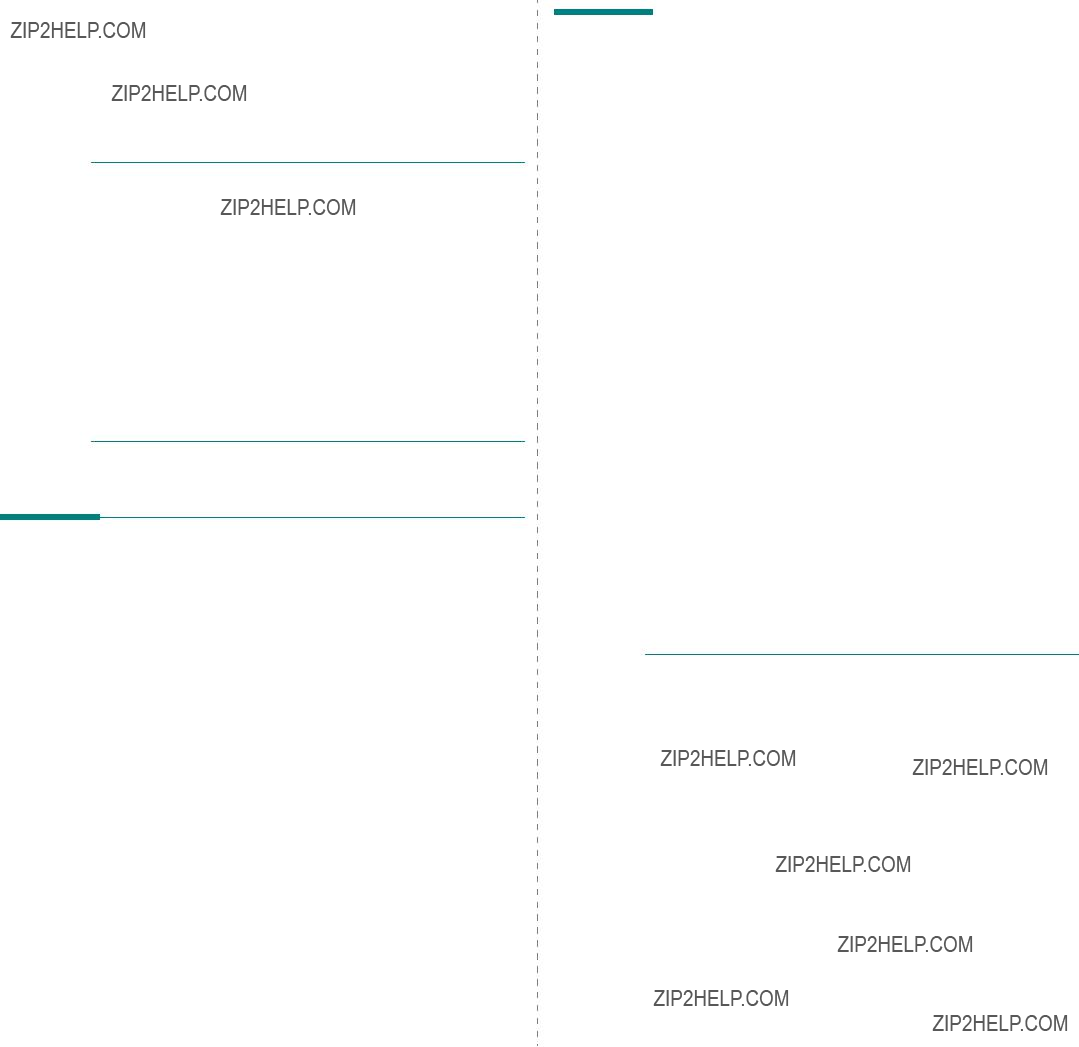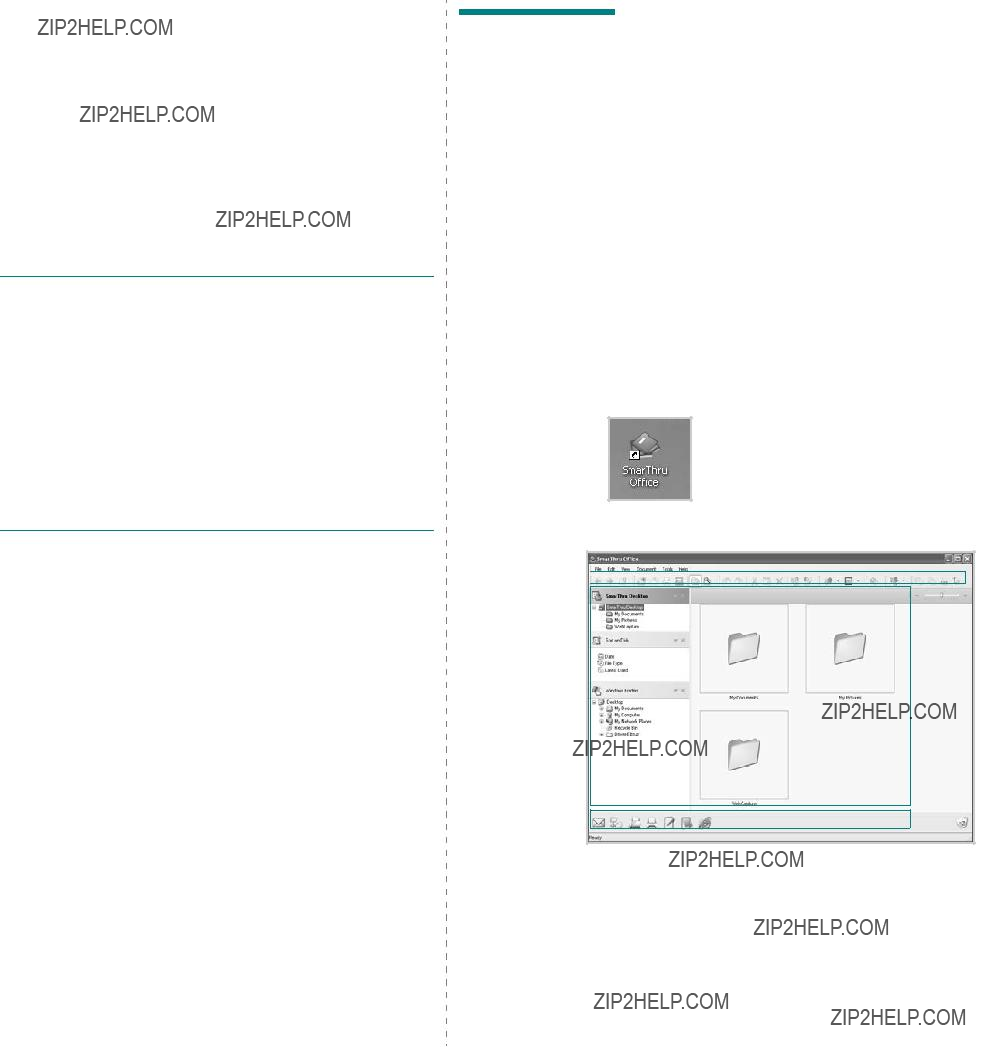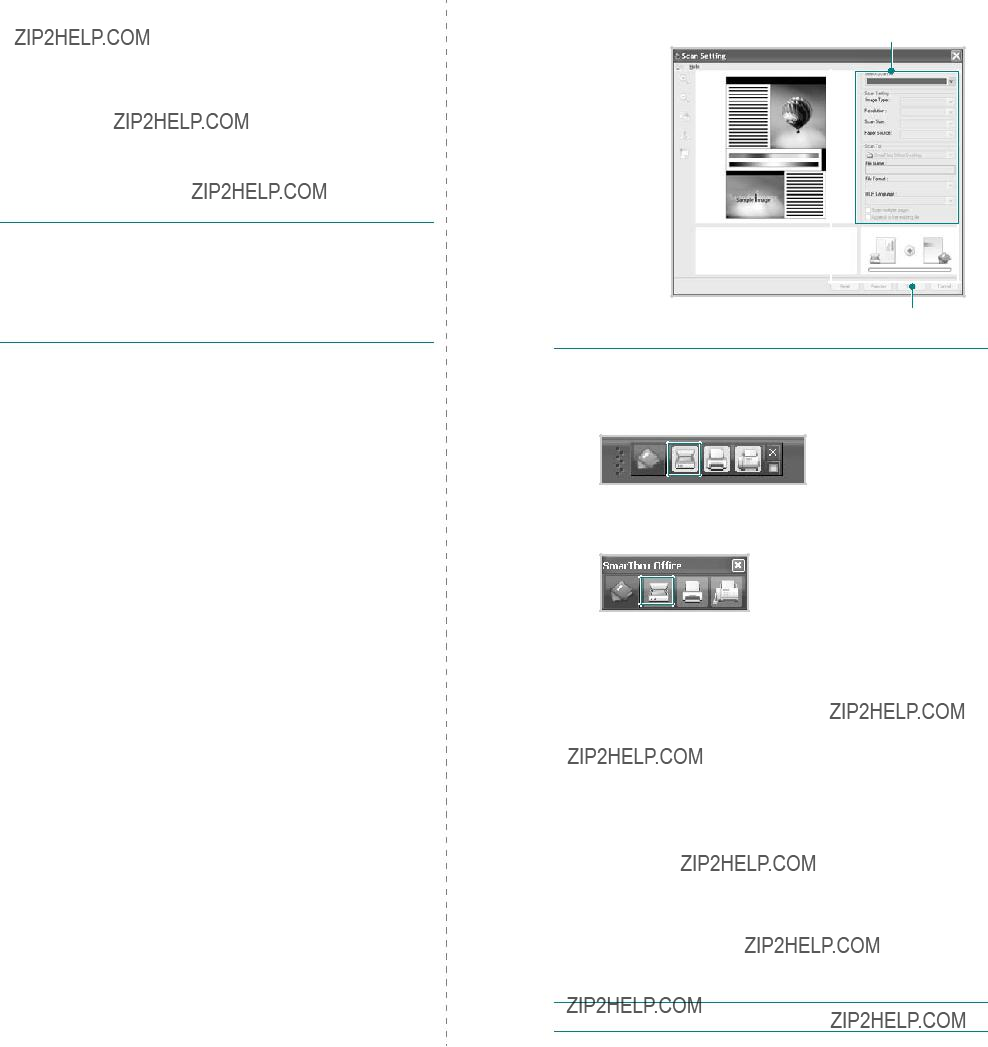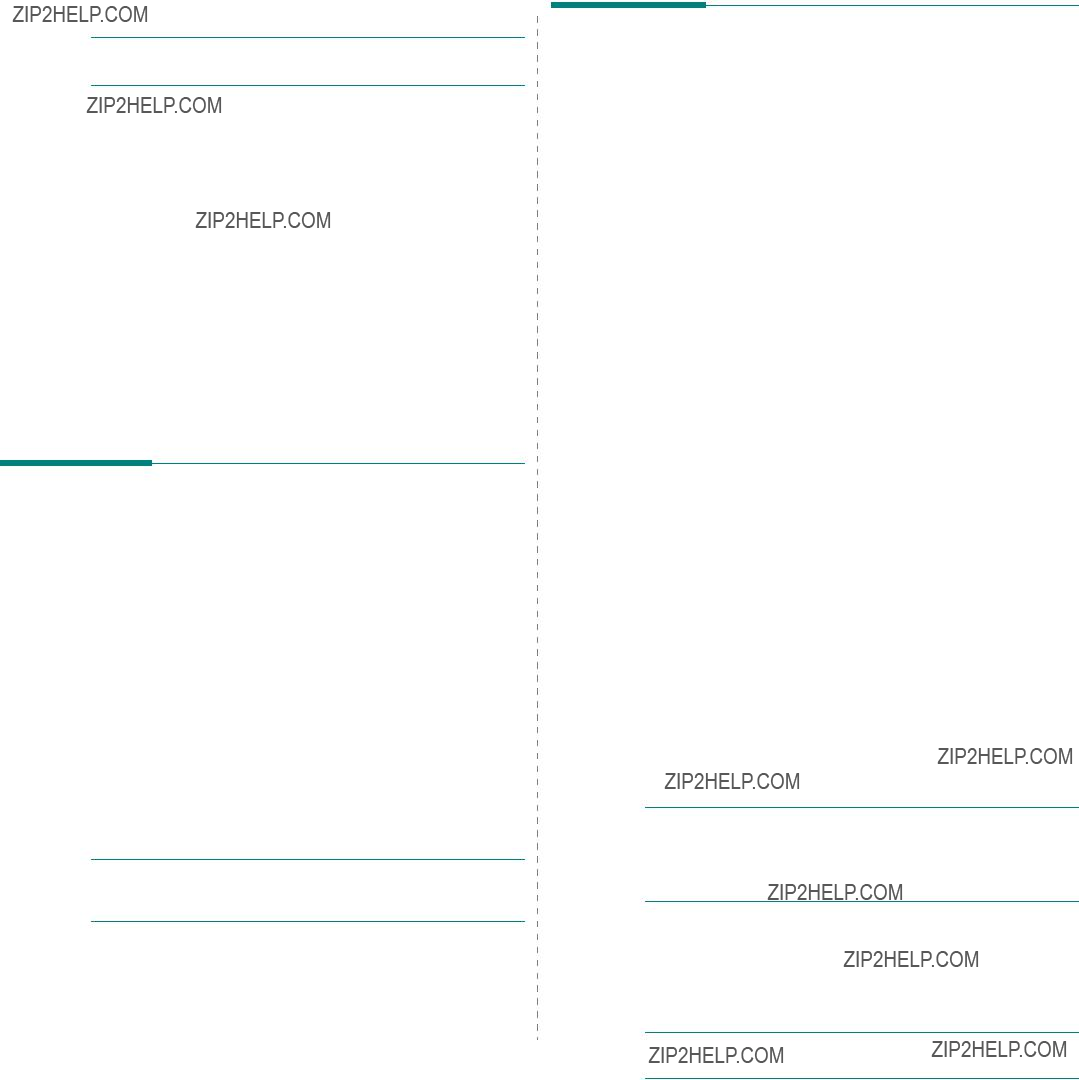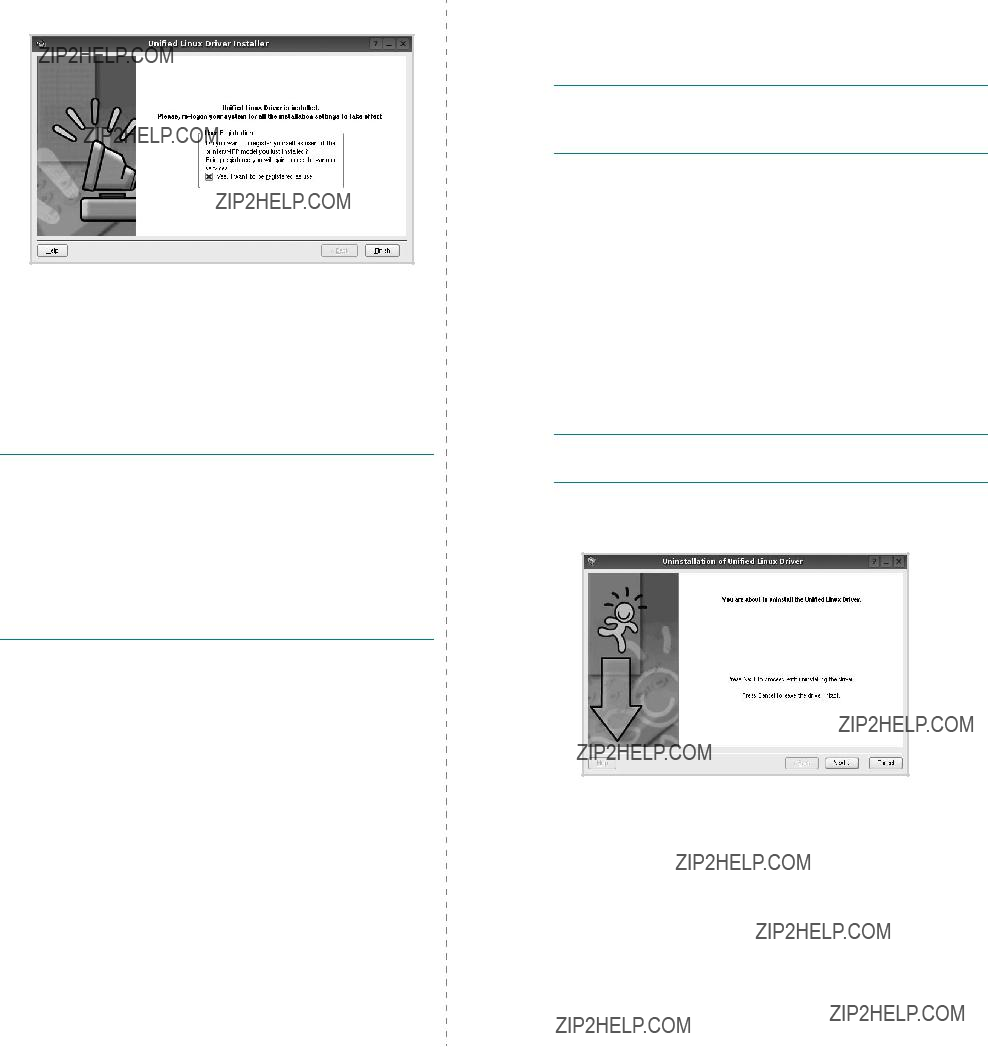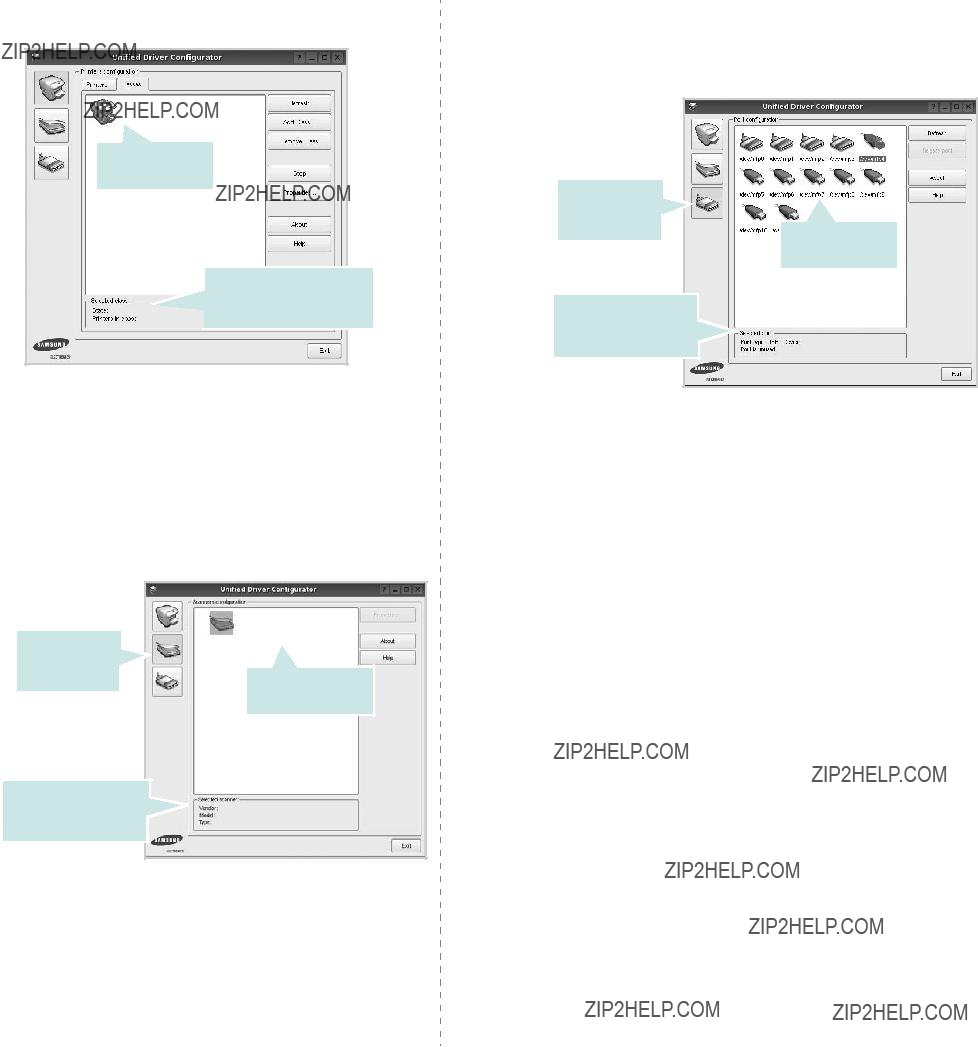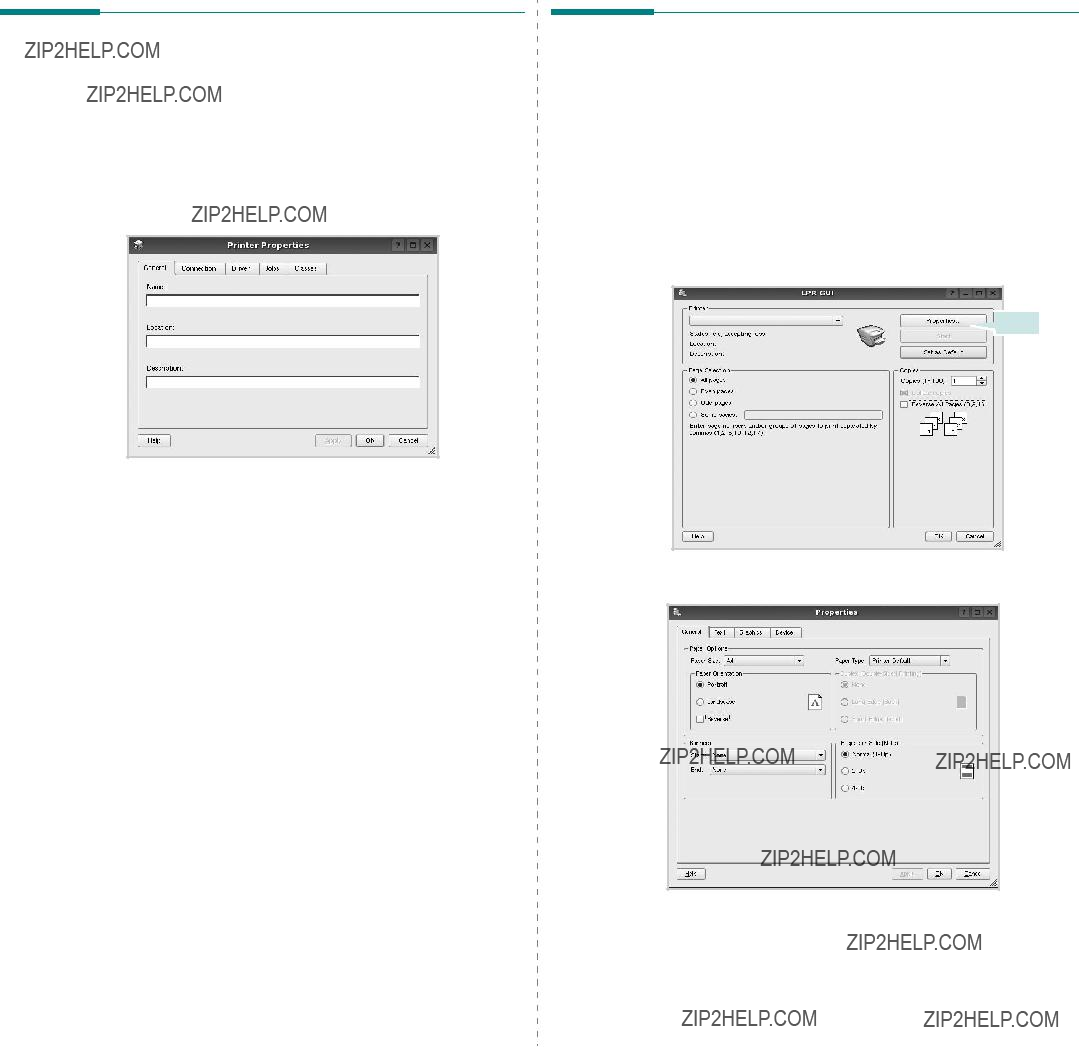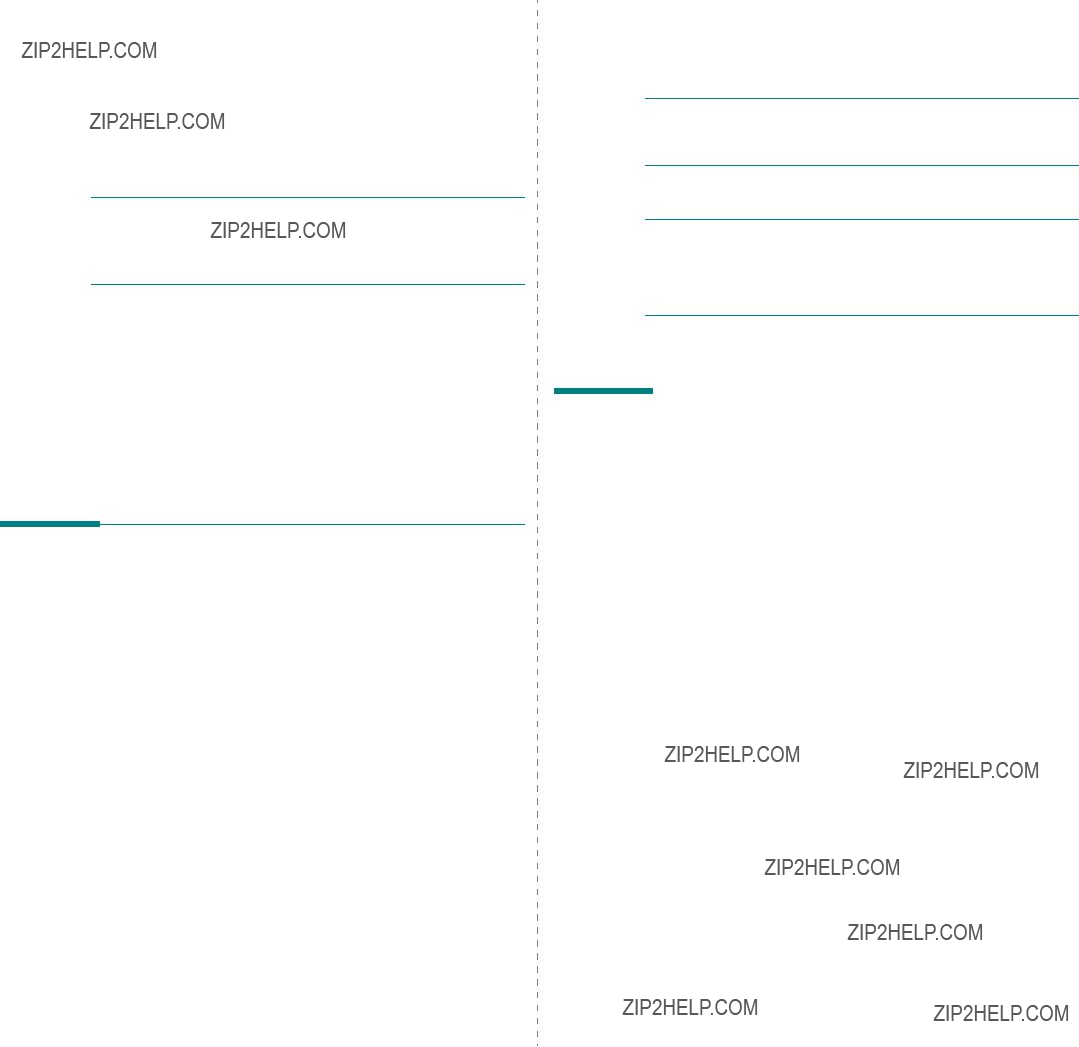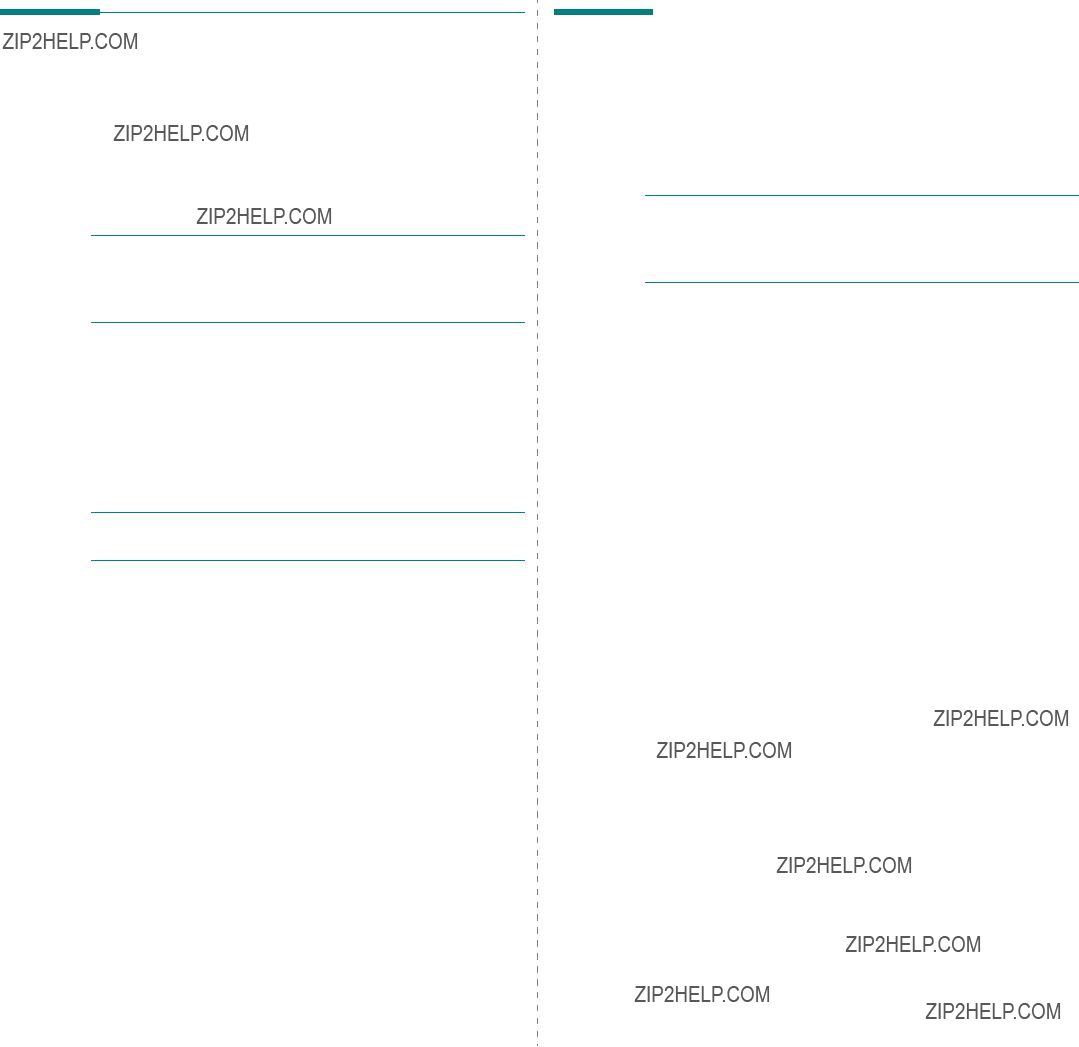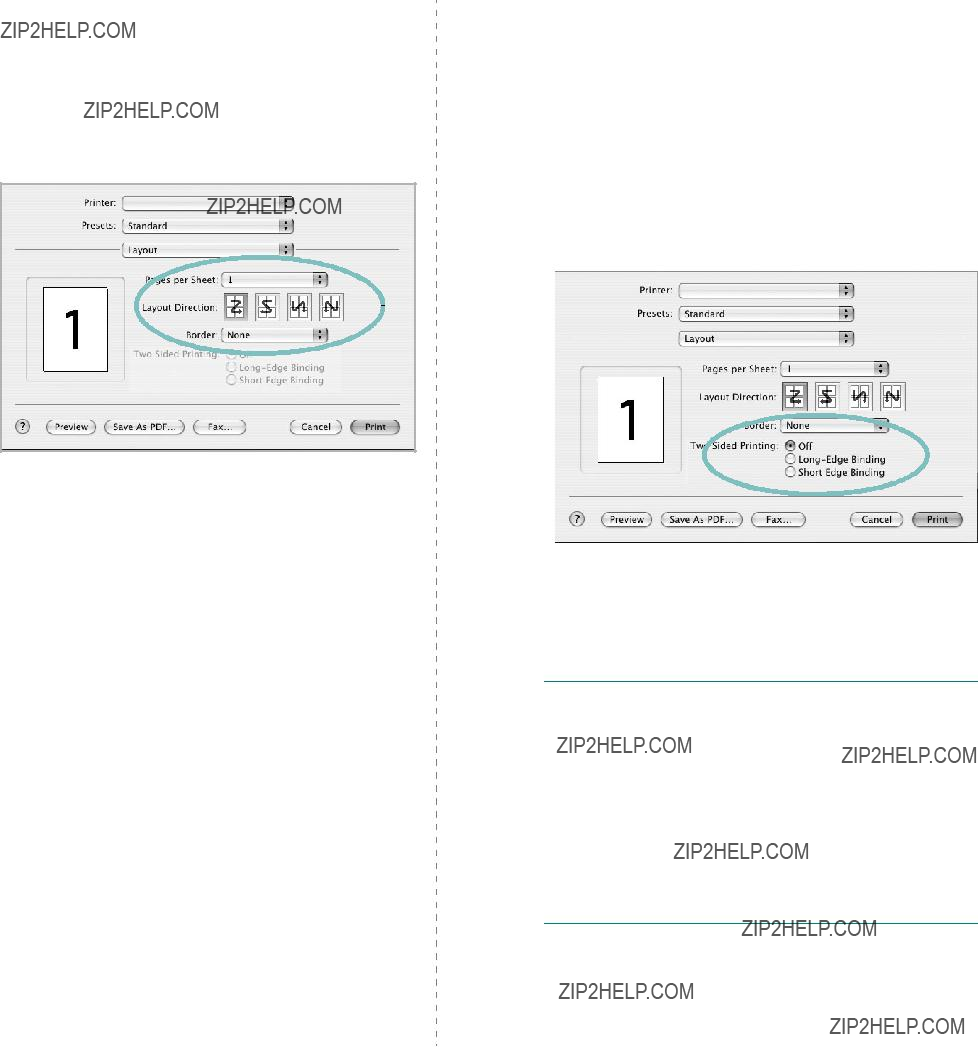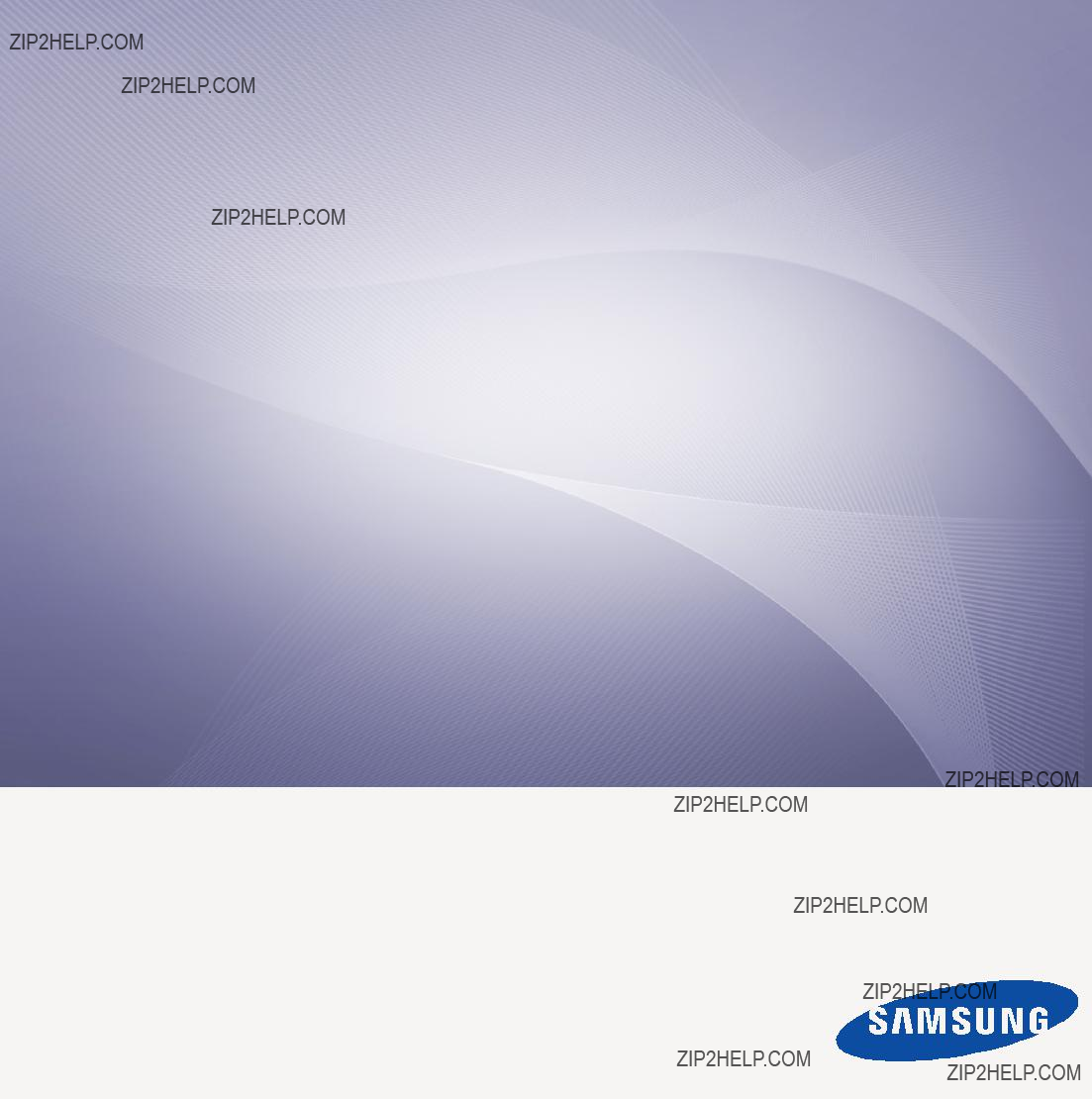
Multi Functional Printer
User???s Guide
imagine the possibilities
Thank you for purchasing a Samsung product. To receive a more complete service, please register your product at

Multi Functional Printer
User???s Guide
imagine the possibilities
Thank you for purchasing a Samsung product. To receive a more complete service, please register your product at

features of your new laser product
Your new machine is equipped with a number of special features that improve the quality of the documents you print. With the machine, you can:
SPECIAL FEATURES
Print with excellent quality and speed
???You can print in a full range of colors using cyan, magenta, yellow, and black.
???You can print with a resolution of up to 2400 x 600 dpi. See
Software section.
Expand your machine???s capacity

 ??? Your machine has an extra memory slot to expand their memory. (Page 91)
??? Your machine has an extra memory slot to expand their memory. (Page 91)
???Zoran IPS Emulation* compatible with PostScript 3 (PS)
enables PS printing.
.
???Your machine prints
Handle many different types of printable material
???The
???The
Create professional documents
???Print Watermarks. You can customize your documents with words, such as ???Confidential???. See Software section.
???Print Posters. The text and pictures of each page of your document are magnified and printed across the sheet of paper and can then be taped together to form a poster. See
Software section.
???You can use preprinted forms and letterhead with plain paper. See Software section.
 * Zoran IPS Emulation compatible with PostScript 3
* Zoran IPS Emulation compatible with PostScript 3
?? Copyright
* 136 PS3 fonts
Contains UFST and MicroType from Monotype Imaging Inc.
Print in various environments
???You can print with Windows 2000 and Windows XP/2003/
Vista as well as Linux and Macintosh systems.
???Your machine is equipped with a USB interface and a network interface.
Copy originals in several formats
??? Your machine can print multiple image copies from the original document on a single page.
??? There are special functions to erase catalog and newspaper background.
???The print quality and image size may be adjusted and enhanced at the same time.
Scan the originals and send it right away
??? Scan in color and use the precise compressions of JPEG, TIFF and PDF formats.
??? Quickly scan and send files to multiple destinations using Networks scanning.
Set a specific time to transmit a Fax
??? You can specify a certain time to transmit the fax and also
send the fax to several stored destinations.
??? After the transmission, the machine may print out the fax reports according to the setting.
2_Features of your new laser product
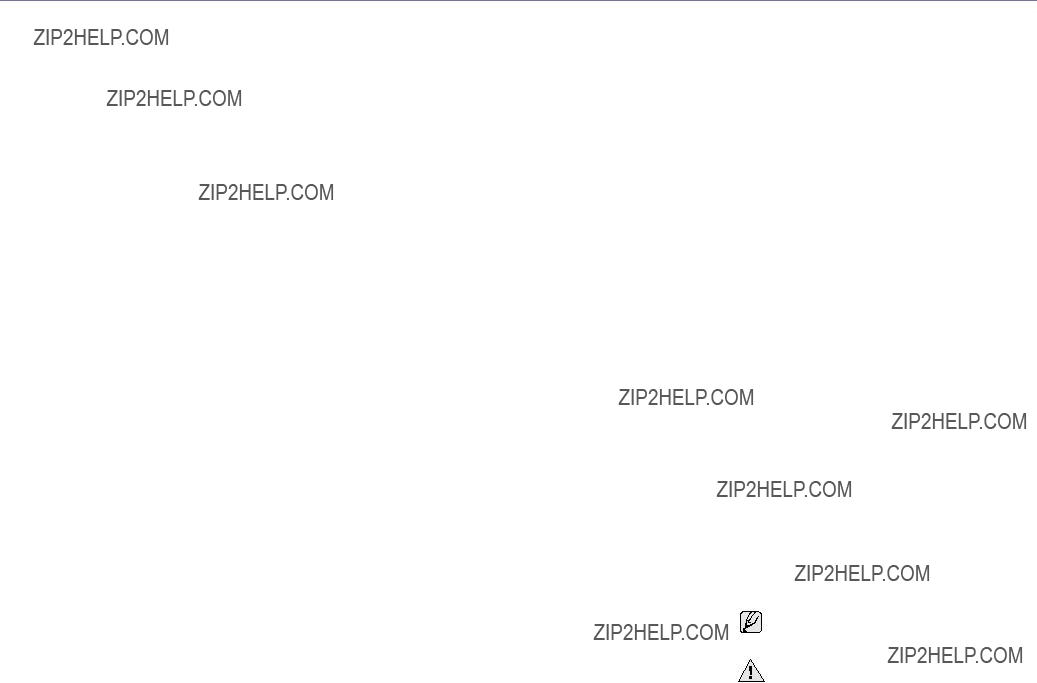
FEATURES BY MODELS
The machine is designed to support all of your document needs ??? from printing and copying, to more advanced networking solutions for your business. Basic features of this machine include:
ABOUT THIS USER???S GUIDE
This user???s guide provides information about basic understanding of the machine as well as detailed explanation on each step during the actual usage. Both novice users and professional users can refer to this guide for installing and using the machine.
Some terms in this guide are used interchangeably, as below:
???Document is synonymous with original.
???Paper is synonymous with media, or print media. Following table offers the conventions of this guide:
Features of your new laser product_3
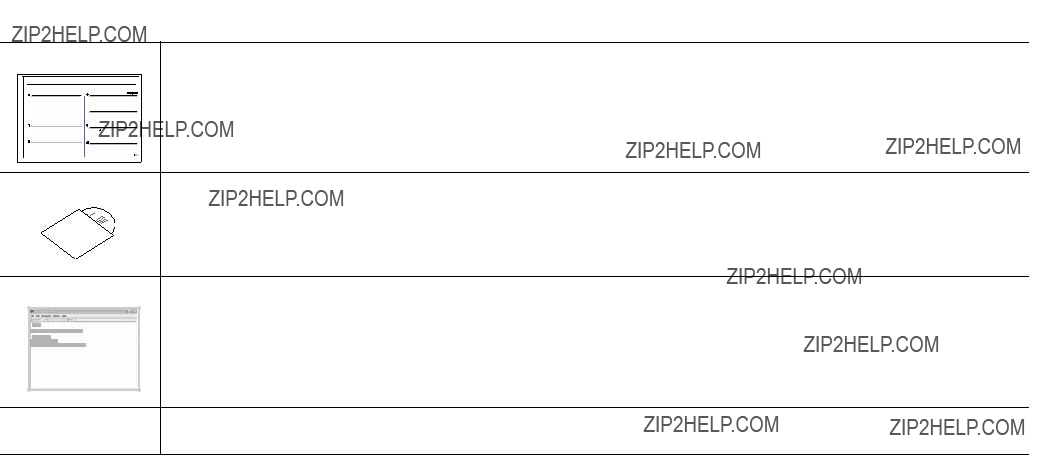
FINDING MORE INFORMATION
You can find information for setting up and using your machine from the following resources, either as a
Quick Install Guide Provides information on setting up your machine and this requires that you follow the instructions in the guide to prepare the machine.
Online User???s Guide Provides you with
This user???s guide also contains a Software section to provide you with information on how to print documents with your machine in various operating systems, and how to use the included software utilities.
Printer Driver Help Provides you with help information on printer driver properties and instructions for setting up the properties for printing. To access a printer driver help screen, click Help from the printer properties dialog box.
Samsung website If you have Internet access, you can get help, support, printer drivers, manuals, and order information from the Samsung website,
4_Features of your new laser product

safety information
IMPORTANT SAFETY SYMBOLS AND PRECAUTIONS
What the icons and signs in this user???s guide mean:
Hazards or unsafe practices that may result in severe personal injury or death.
WARNING
CAUTION
CAUTION
Hazards or unsafe practices that may result in minor personal injury or property damage.
To reduce the risk of fire, explosion, electric shock, or personal injury when using your laser MFP, follow these basic safety precautions:
Do NOT attempt.
Do NOT disassemble.
Do NOT touch.
Follow directions explicitly.
Unplug the power plug from the wall socket.
Make sure the MFP is grounded to prevent electric shock.
Call the service center for help.
These warning signs are here to prevent injury to you and others. Follow them explicitly. After reading this section, keep it in a safe place for future reference.
1.Read and understand all instructions.
2.Use common sense whenever operating electrical appliances.
3.Follow all warnings and instructions marked on the machine and in the literature accompanying the machine.
4.If an operating instruction appears to conflict with safety information, heed the safety information. You may have misunderstood the operating instruction. If you cannot resolve the conflict, contact your sales or service representative for assistance.
5.Unplug the machine from the AC wall socket and/or telephone jack before cleaning. Do not use liquid or aerosol cleaners. Use only a damp cloth for cleaning.
6.Do not place the machine on an unstable cart, stand or table. It may fall, causing serious damage.
7.Your machine should never be placed on, near or over a radiator, heater, air conditioner or ventilation duct.
8.Do not allow anything to rest on the power. Do not locate your machine where the cords will be abused by persons walking on them.
9.Do not overload wall outlets and extension cords. This can diminish performance, and may result in the risk of fire or electric shock.
10. Do not allow pets to chew on the AC power, telephone or PC interface cords.
11.Never push objects of any kind into the machine through case or cabinet openings. They may touch dangerous voltage points, creating a risk of fire or shock. Never spill liquid of any kind onto or into the machine.
12. To reduce the risk of electric shock, do not disassemble the machine. Take it to a qualified service technician when repair work is required. Opening or removing covers may expose you to dangerous voltages or other risks. Incorrect reassembly could cause electric shock when the unit is subsequently used.
Safety information_5

13. Unplug the machine from the telephone jack, PC and AC wall outlet and refer servicing to qualified service personnel under the following conditions:
???When any part of the power cord, plug or connecting cable is damaged or frayed.
???If liquid has been spilled into the machine.
???If the machine has been exposed to rain or water.
???If the machine does not operate properly after instructions have been followed.
???If the machine has been dropped, or the cabinet appears damaged.
???If the machine exhibits a sudden and distinct change in performance.
14.Adjust only those controls covered by the operating instructions. Improper adjustment of other controls may result in damage, and may require extensive work by a qualified service technician to restore the machine to normal operation.
15.Avoid using this machine during a lightning storm. There may be a remote risk of electric shock from lightning. If possible, unplug the
AC power and telephone cord for the duration of the lightning storm.
16.The Power cord supplied with your machine should be used for safe operation. If you are using a cord which is longer than 2 m with 110 V machine, then it should be 16 AWGa or bigger.
17.Use only No.26 AWG or larger telephone line cord.
18.SAVE THESE INSTRUCTIONS
19.This machine can be operated only in the country you have purchased. (Due to different voltage, frequency, telecommunication configuration and etc)
a.AWG: American Wire Gauge
LASER SAFETY STATEMENT
The printer is certified in the U.S. to conform to the requirements of DHHS 21 CFR, chapter 1 Subchapter J for Class I(1) laser products, and elsewhere is certified as a Class I laser product conforming to the requirements of IEC 825.
Class I laser products are not considered to be hazardous. The laser system and printer are designed so there is never any human access to laser radiation above a Class I level during normal operation, user maintenance or prescribed service condition.
WARNING
Never operate or service the printer with the protective cover removed from Laser/Scanner assembly. The reflected beam, although invisible, can damage your eyes.
When using this product, these basic safety precautions should always be followed to reduce risk of fire, electric shock, and injury to persons:
6_Safety information
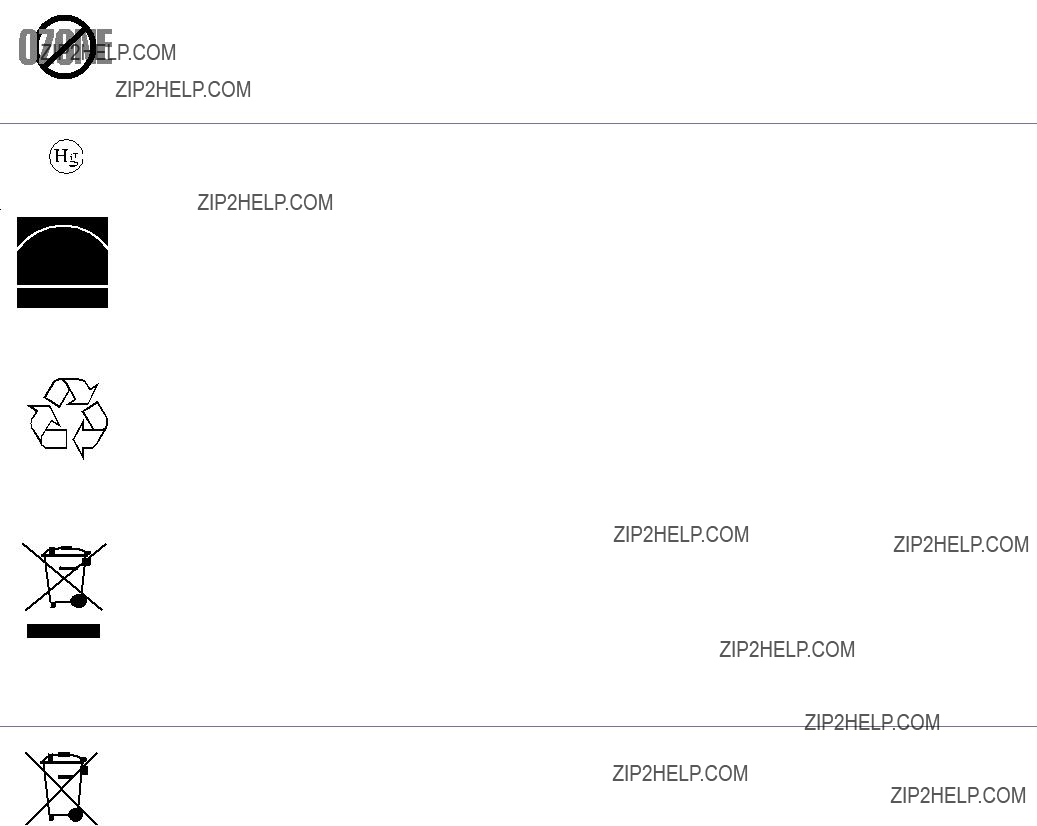
OZONE SAFETY
During normal operation, this machine produces ozone. The ozone produced does not present a hazard to the operator. However, it is advisable that the machine be operated in a well ventilated area.
If you need additional information about ozone, request your nearest Samsung dealer.
MERCURY SAFETY
Contains Mercury, Dispose According to Local, State or Federal Laws. (U.S.A only)
POWER SAVER
This printer contains advanced energy conservation technology that reduces power consumption when it is not in active use. When the printer does not receive data for an extended period of time, power consumption is automatically lowered. ENERGY STAR and the ENERGY STAR mark are registered U.S. marks.
For more information on the ENERGY STAR program see http://www.energystar.gov
RECYCLING
Recycle or dispose of the packaging material for this product in an environmentally responsible manner.
CORRECT DISPOSAL OF THIS PRODUCT (WASTE ELECTRICAL & ELECTRONIC EQUIPMENT)
(Applicable in the European Union and other European countries with separate collection systems)
This marking on the product, accessories or literature indicates that the product and its electronic accessories (e.g. charger, headset, USB cable) should not be disposed of with other household waste at the end of their working life. To prevent possible harm to the environment or human health from uncontrolled waste disposal, please separate these items from other types of waste and recycle them responsibly to promote the sustainable reuse of material resources. Household users should contact either the retailer where they purchased this product, or their local government office, for details of where and how they can take these items for environmentally safe recycling. Business users should contact their supplier and check the terms and conditions of the purchase contract. This product and its electronic accessories should not be mixed with other commercial wastes for disposal.
CORRECT DISPOSAL OF BATTERIES IN THIS PRODUCT
(Applicable in the European Union and other European countries with separate battery return systems)
This marking on the battery, manual or packaging indicates that the batteries in this product should not be disposed of with other household waste at the end of their working life. Where marked, the chemical symbols Hg, Cd or Pb indicate that the battery contains mercury, cadmium or lead above the reference levels in EC Directive 2006/66. If batteries are not properly disposed of, these substances can cause harm to human health or the environment.
To protect natural resources and to promote material reuse, please separate batteries from other types of waste and recycle them through your local, free battery return system.
Safety information_7

RADIO FREQUENCY EMISSIONS
FCC Information to the User
This device complies with Part 15 of the FCC Rules. Operation is subject to the following two conditions:
???This device may not cause harmful interference, and
???This device must accept any interference received, including interference that may cause undesired operation.
This equipment has been tested and found to comply with the limits for a Class A digital device, pursuant to Part 15 of the FCC Rules. These limits are designed to provide reasonable protection against harmful interference in a residential installation. This equipment generates, uses and can radiate radio frequency energy and, if not installed and used in accordance with the instructions, may cause harmful interference to radio communications. However, there is no guarantee that interference will not occur in a particular installation. If this equipment does cause harmful interference to radio or television reception, which can be determined by turning the equipment off and on, the user is encouraged to try to correct the interference by one or more of the following measures:
???Reorient or relocate the receiving antenna.
???Increase the separation between the equipment and receiver.
???Connect the equipment into an outlet on a circuit different from that to which the receiver is connected.
???Consult the dealer or experienced radio TV technician for help.
Change or modifications not expressly approved by the manufacturer responsible for compliance could void the user's authority to oper- ate the equipment.
Canadian Radio Interference Regulations
This digital apparatus does not exceed the Class A limits for radio noise emissions from digital apparatus as set out in the
Cet appareil num??rique respecte les limites de bruits radio??lectriques applicables aux appareils num??riques de Classe A prescrites dans la norme sur le mat??riel brouilleur: ???Appareils Num??riques???,
UNITED STATES OF AMERICA
Federal Communications Commission (FCC)
Intentional emitter per FCC Part 15
Low power, Radio LAN type devices (radio frequency (RF) wireless communication devices), operating in the 2.4 GHz/5 GHz Band, may be present (embedded) in your printer system. This section is only applicable if these devices are present. Refer to the system label to verify the presence of wireless devices.
Wireless devices that may be in your system are only qualified for use in the United States of America if an FCC ID number is on the system label.
The FCC has set a general guideline of 20 cm (8 inches) separation between the device and the body, for use of a wireless device near the body (this does not include extremities). This device should be used more than 20 cm (8 inches) from the body when wireless devices are on. The power output of the wireless device (or devices), which may be embedded in your printer, is well below the RF exposure limits as set by the FCC.
This transmitter must not be collocated or operation in conjunction with any other antenna or transmitter.
Operation of this device is subject to the following two conditions:(1) This device may not cause harmful interference, and(2) this device must accept any interference received, including interference that may cause undesired operation of the device.
Wireless devices are not user serviceable. Do not modify them in any way. Modification to a wireless device will void the authorization to use it. Contact manufacturer for service.
FCC Statement for Wireless LAN use:
While installing and operating this transmitter and antenna combination the radio frequency exposure limit of 1mW/cm2 may be exceeded at distances close to the antenna installed. Therefore, the user must maintain a minimum distance of 20cm from the antenna at all times. This device cannot be colocated with another transmitter and transmitting antenna.
8_Safety information
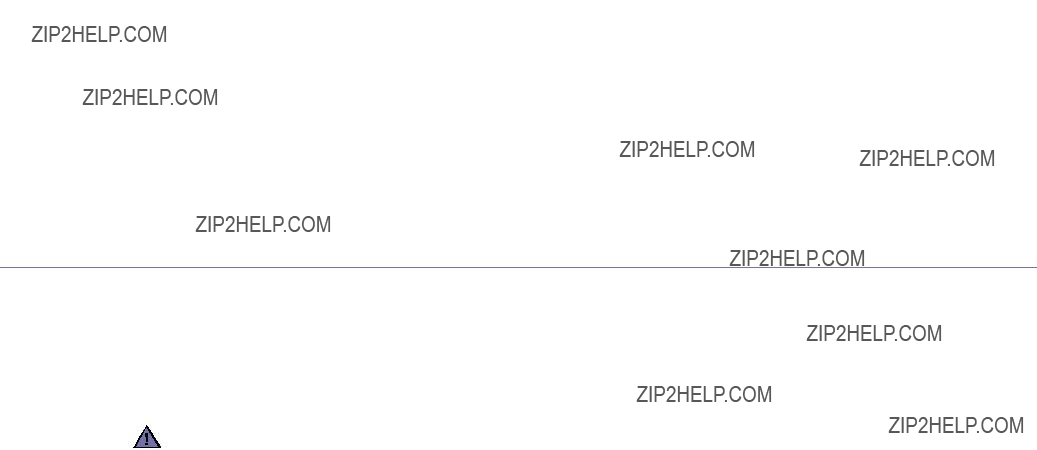
FAX BRANDING
The Telephone Consumer Protection Act of 1991 makes it unlawful for any person to use a computer or other electronic device to send any message via a telephone facsimile machine unless such message clearly contains in a margin at the top or bottom of each transmitted page or on the first page of the transmission the following information:
(1)the date and time of transmission
(2)identification of either business, business entity or individual sending the message; and
(3)telephone number of either the sending machine, business, business entity or individual.
The Telephone Company may make changes in its communications facilities, equipment operations or procedures where such action is reasonably required in the operation of its business and is not inconsistent with the rules and regulations in FCC Part 68. If such changes can be reasonably expected to render any customer terminal equipment incompatible with telephone company communications facilities, or require modification or alteration of such terminal equipment, or otherwise materially affect its use or performance, the customer shall be given adequate notice in writing, to allow the customer an opportunity to maintain uninterrupted service
RINGER EQUIVALENCE NUMBER
The Ringer Equivalence Number and FCC Registration Number for this machine may be found on the label located on the bottom or rear of the machine. In some instances you may need to provide these numbers to the telephone company.
The Ringer Equivalence Number (REN) is a measure of the electrical load placed on the telephone line, and is useful for determining whether you have ???overloaded??? the line. Installing several types of equipment on the same telephone line may result in problems making and receiving telephone calls, especially ringing when your line is called. The sum of all Ringer Equivalence Numbers of the equipment on your telephone line should be less than five in order to assure proper service from the telephone company. In some cases, a sum of five may not be usable on your line. If any of your telephone equipment is not operating properly, you should immediately remove it from your telephone line, as it may cause harm to the telephone network.
FCC Regulations state that changes or modifications to this equipment not expressly approved by the manufacturer could void the user???s authority to operate this equipment. In the event that terminal equipment causes harm to the telephone network, the telephone company should notify the customer that service may be stopped. However, where prior notice is impractical, the company may temporarily cease service, providing that they:
a)promptly notify the customer.
b)give the customer an opportunity to correct the equipment problem.
c)inform the customer of the right to bring a complaint to the Federal Communication Commission pursuant to procedures set out in FCC Rules and Regulations Subpart E of Part 68.
You should also know that:
???Your machine is not designed to be connected to a digital PBX system.
???If you intend to use a computer modem or fax modem on the same phone line as your machine, you may experience transmission and reception problems with all the equipment. It is recommended that no other equipment, except for a regular telephone, share the line with your machine.
???If your area experiences a high incidence of lightning or power surges, we recommend that you install surge protectors for both the power and the telephone lines. Surge protectors can be purchased from your dealer or telephone and electronic specialty stores.
???When programming emergency numbers and/or making test calls to emergency numbers, use a
???This machine may not be used on coin service or party lines.
???This machine provides magnetic coupling to hearing aids.
You may safely connect this equipment to the telephone network by means of a standard modular jack, USOC
Safety information_9

REPLACING THE FITTED PLUG (FOR UK ONLY)
Important
The mains lead for this machine is fitted with a standard (BS 1363) 13 amp plug and has a 13 amp fuse. When you change or examine the fuse, you must
The 13 amp plug is the most widely used type in the UK and should be suitable. However, some buildings (mainly old ones) do not have normal 13 amp plug sockets. You need to buy a suitable plug adaptor. Do not remove the moulded plug.
If you cut off the moulded plug, get rid of it straight away.
You cannot rewire the plug and you may receive an electric shock if you plug it into a socket.
Important warning:
You must earth this machine.
The wires in the mains lead have the following color code:
???Green and Yellow: Earth
???Blue: Neutral
???Brown: Live
If the wires in the mains lead do not match the colors marked in your plug, do the following:
You must connect the green and yellow wire to the pin marked by the letter ???E??? or by the safety ???Earth symbol??? or colored green and yellow or green.
You must connect the blue wire to the pin which is marked with the letter ???N??? or colored black. You must connect the brown wire to the pin which is marked with the letter ???L??? or colored red. You must have a 13 amp fuse in the plug, adaptor, or at the distribution board.
DECLARATION OF CONFORMITY (EUROPEAN COUNTRIES)
Approvals and Certifications
The CE marking applied to this product symbolizes Samsung Electronics Co., Ltd. Declaration of Conformity with the following applicable 93/ 68/EEC Directives of the European Union as of the dates indicated:
January 1, 1995: Council Directive 73/23/EEC Approximation of the laws of the member states related to low voltage equipment.
January 1, 1996: Council Directive 89/336/EEC (92/31/EEC), approximation of the laws of the Member States related to electromagnetic compatibility.
March 9, 1999: Council Directive 1999/5/EC on radio equipment and telecommunications terminal equipment and the mutual recognition of their conformity. A full declaration, defining the relevant Directives and referenced standards can be obtained from your Samsung Electronics Co., Ltd. representative.
EC Certification
Certification to 1999/5/EC Radio Equipment & Telecommunications Terminal Equipment Directive (FAX)
This Samsung product has been
In the event of problems, you should contact the Euro QA Lab of Samsung Electronics Co., Ltd. in the first instance.
The product has been tested against TBR21. To assist in the use and application of terminal equipment which complies with this standard, the European Telecommunication Standards Institute (ETSI) has issued an advisory document (EG 201 121) which contains notes and additional requirements to ensure network compatibility of TBR21 terminals. The product has been designed against, and is fully compliant with, all of the relevant advisory notes contained in this document.
10_Safety information
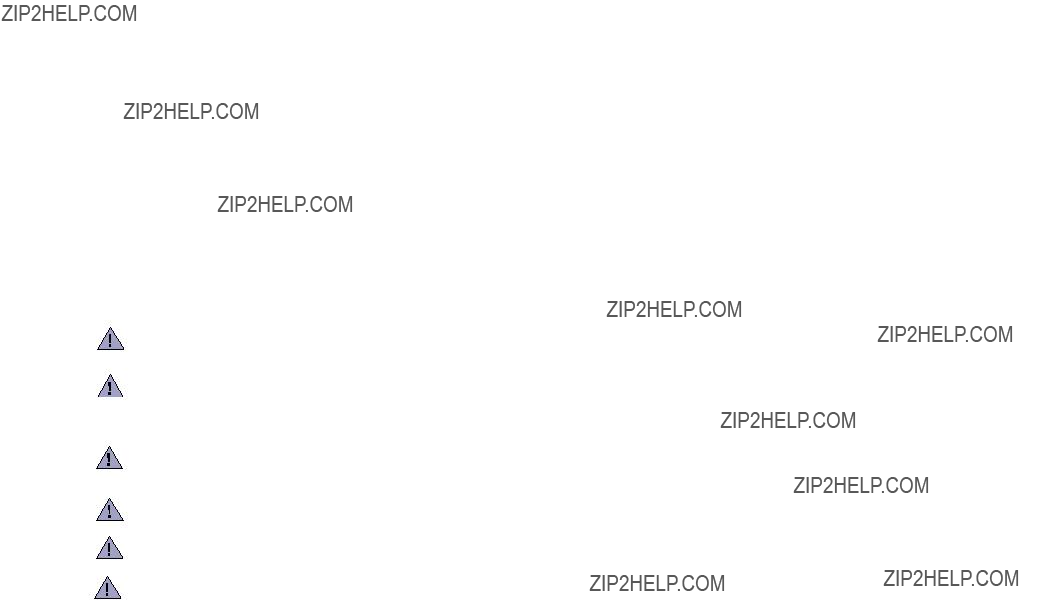
European Radio Approval Information
(for products fitted with
Low power, Radio LAN type devices (radio frequency (RF) wireless communication devices), operating in the 2.4 GHz/5 GHz band, may be present (embedded) in your printer system which is intended for home or office use. This section is only applicable if these devices are present. Refer to the system label to verify the presence of wireless devices.
Wireless devices that may be in your system are only qualified for use in the European Union or associated areas if a CE mark with 
 a Notified Body Registration Number and the Alert Symbol is on the system label.
a Notified Body Registration Number and the Alert Symbol is on the system label.
The power output of the wireless device or devices that may be embedded in you printer is well below the RF exposure limits as set by the European Commission through the R&TTE directive.
European States qualified under wireless approvals:
European States with restrictions on use:
REGULATORY COMPLIANCE STATEMENTS
Wireless Guidance
Low power, Radio LAN type devices (radio frequency (RF) wireless communication devices), operating in the 2.4 GHz/5 GHz Band, may be present (embedded) in your printer system. The following section is a general overview of considerations while operating a wireless device.
Additional limitations, cautions, and concerns for specific countries are listed in the specific country sections (or country group sections). The wireless devices in your system are only qualified for use in the countries identified by the Radio Approval Marks on the system rating label. If the country you will be using the wireless device in, is not listed, contact your local Radio Approval agency for requirements. Wireless devices are closely regulated and use may not be allowed.
The power output of the wireless device or devices that may be embedded in your printer is well below the RF exposure limits as known at this time. Because the wireless devices (which may be embedded into your printer) emit less energy than is allowed in radio frequency safety standards and recommendations, manufacturer believes these devices are safe for use. Regardless of the power levels, care should be taken to minimize human contact during normal operation.
As a general guideline, a separation of 20 cm (8 inches) between the wireless device and the body, for use of a wireless device near the body (this does not include extremities) is typical. This device should be used more than 20 cm (8 inches) from the body when wireless devices are on and transmitting.
This transmitter must not be collocated or operation in conjunction with any other antenna or transmitter.
Some circumstances require restrictions on wireless devices. Examples of common restrictions are listed below:
Radio frequency wireless communication can interfere with equipment on commercial aircraft. Current aviation regulations require wireless devices to be turned off while traveling in an airplane. IEEE 802.11 (also known as wireless Ethernet) and Bluetooth communication devices are examples of devices that provide wireless communication.
In environments where the risk of interference to other devices or services is harmful or perceived as harmful, the option to use a wireless device may be restricted or eliminated. Airports, Hospitals, and Oxygen or flammable gas laden atmospheres are limited examples where use of wireless devices may be restricted or eliminated. When in environments where you are uncertain of the sanction to use wireless devices, ask the applicable authority for authorization prior to use or turning on the wireless device.
Every country has different restrictions on the use of wireless devices. Since your system is equipped with a wireless device, when traveling between countries with your system, check with the local Radio Approval authorities prior to any move or trip for any restrictions on the use of a wireless device in the destination country.
If your system came equipped with an internal embedded wireless device, do not operate the wireless device unless all covers and shields are in place and the system is fully assembled.
Wireless devices are not user serviceable. Do not modify them in any way. Modification to a wireless device will void the authorization to use it. Contact manufacturer for service.
Only use drivers approved for the country in which the device will be used. See the manufacturer System Restoration Kit, or contact manufacturer Technical Support for additional information.
Safety information_11

OPENSSL LICENSE
Copyright (c)
Redistribution and use in source and binary forms, with or without modification, are permitted provided that the following conditions are met:
1.Redistributions of source code must retain the above copyright notice, this list of conditions and the following disclaimer.
2.Redistributions in binary form must reproduce the above copyright notice, this list of conditions and the following disclaimer in the documentation and/or other materials provided with the distribution.
3.All advertising materials mentioning features or use of this software must display the following acknowledgment: "This product includes software developed by the OpenSSL Project for use in the OpenSSL Toolkit. (http://www.openssl.org/)"
4.The names "OpenSSL Toolkit" and "OpenSSL Project" must not be used to endorse or promote products derived from this software without
5.prior written permission. For written permission, please contact
6.Products derived from this software may not be called "OpenSSL" nor may "OpenSSL" appear in their names without prior written permission of the OpenSSL Project.
7.Redistributions of any form whatsoever must retain the following acknowledgment: "This product includes software developed by the OpenSSL Project for use in the OpenSSL Toolkit (http://www.openssl.org/)"
THIS SOFTWARE IS PROVIDED BY THE OpenSSL PROJECT ``AS IS'' AND ANY EXPRESSED OR IMPLIED WARRANTIES, INCLUDING, BUT
NOT LIMITED TO, THE IMPLIED WARRANTIES OF MERCHANTABILITY AND FITNESS FOR A PARTICULAR PURPOSE ARE DISCLAIMED. IN NO EVENT SHALL THE OpenSSL PROJECT OR ITS CONTRIBUTORS BE LIABLE FOR ANY DIRECT, INDIRECT, INCIDENTAL, SPECIAL,
EXEMPLARY, OR CONSEQUENTIAL DAMAGES (INCLUDING, BUT NOT LIMITED TO, PROCUREMENT OF SUBSTITUTE GOODS OR
SERVICES; LOSS OF USE, DATA, OR PROFITS; OR BUSINESS INTERRUPTION) HOWEVER CAUSED AND ON ANY THEORY OF LIABILITY,
WHETHER IN CONTRACT, STRICT LIABILITY, OR TORT (INCLUDING NEGLIGENCE OR OTHERWISE) ARISING IN ANY WAY OUT OF THE
USE OF THIS SOFTWARE, EVEN IF ADVISED OF THE POSSIBILITY OF SUCH DAMAGE.
This product includes cryptographic software written by Eric Young(eay@cryptsoft.com). This product includes software written by Tim Hudson (tjh@cryptsoft.com).
ORIGINAL SSLEAY LICENSE
Copyright (C)
This package is an SSL implementation written by Eric Young (eay@cryptsoft.com). The implementation was written so as to conform with Netscapes SSL.
This library is free for commercial and
Redistribution and use in source and binary forms, with or without modification, are permitted provided that the following conditions are met:
1.Redistributions of source code must retain the copyright notice, this list of conditions and the following disclaimer.
2.Redistributions in binary form must reproduce the above copyright notice, this list of conditions and the following disclaimer in the documentation and/or other materials provided with the distribution.
3.All advertising materials mentioning features or use of this software must display the following acknowledgement: "This product includes cryptographic software written by Eric Young (eay@cryptsoft.com)" The word 'cryptographic' can be left out if the rouines from the library being used are not cryptographic
4.If you include any Windows specific code (or a derivative thereof) from the apps directory (application code) you must include an acknowledgement: "This product includes software written by Tim Hudson (tjh@cryptsoft.com)"
THIS SOFTWARE IS PROVIDED BY ERIC YOUNG ``AS IS'' AND ANY EXPRESS OR IMPLIED WARRANTIES, INCLUDING, BUT NOT LIMITED
TO, THE IMPLIED WARRANTIES OF MERCHANTABILITY AND FITNESS FOR A PARTICULAR PURPOSE ARE DISCLAIMED. IN NO EVENT
SHALL THE AUTHOR OR CONTRIBUTORS BE LIABLE FOR ANY DIRECT, INDIRECT, INCIDENTAL, SPECIAL, EXEMPLARY, OR
CONSEQUENTIAL DAMAGES (INCLUDING, BUT NOT LIMITED TO, PROCUREMENT OF SUBSTITUTE GOODS OR SERVICES; LOSS OF USE,
DATA, OR PROFITS; OR BUSINESS INTERRUPTION) HOWEVER CAUSED AND ON ANY THEORY OF LIABILITY, WHETHER IN CONTRACT,
STRICT LIABILITY, OR TORT (INCLUDING NEGLIGENCE OR OTHERWISE) ARISING IN ANY WAY OUT OF THE USE OF THIS SOFTWARE,
EVEN IF ADVISED OF THE POSSIBILITY OF SUCH DAMAGE.
The licence and distribution terms for any publically available version or derivative of this code cannot be changed. i.e. this code cannot simply be copied and put under another distribution licence [including the GNU Public Licence.]
12_Safety information

Safety information_13

contents
19
25Supported operating environments
26Configuring network protocol via the machine
27Linux
28Changing the display language
29Entering characters using the number keypad
34Specifications on print media
35Media sizes supported in each mode
35Guidelines for special print media
36Changing the size of the paper in the paper tray
36Loading paper in the tray 1 or optional tray
37Loading paper in the
14_Contents

contents
38For A4- or
38Setting the paper size and type
40Changing the scan size settings
40Changing the default copy settings
42 Printing on both sides of paper
44 Scanning from the control panel
44Setting scan information in Samsung Scan Manager.
44Scanning to application programs
45Scanning by a network connection
45Preparing for network scanning
47Changing the settings for each scan job
47Changing the default scan settings
47printing scan confirmation report automatically
48Registering speed email numbers
48Configuring group email numbers
48Retrieving global email addresses from the LDAP server
Contents_15

contents
52Sending faxes on both sides of paper
53Receiving automatically in Fax mode
53Receiving manually in Tel mode
53Receiving manually using an extension telephone
53Receiving automatically in Ans/Fax mode
53Receiving faxes using DRPD mode
53Receiving in secure receiving mode
53Activating secure receiving mode
54Sending a fax to multiple destinations
56Changing the fax setup options
57Changing the default document settings
57Printing sent fax report automatically
59 Plugging in a USB memory device
59 Scanning to a USB memory device
59Scanning
60 Printing from a USB memory device
60To print a document from a USB memory device:
61Formatting a USB memory device
16_Contents

contents
67Clearing the Toner Empty message
68Replacing the paper transfer belt
69Replacing the DADF (or ADF) rubber pad
70Managing your machine from the website
70To access SyncThru??? Web Service:
70Checking the machine???s serial number
71Tips for avoiding paper jams
78Understanding display messages
86Samsung Scan Manager problems
93Precautions to take when installing accessories
94Activating the added memory in the PS printer properties
94Using a wireless network interface card
94Installing a wireless network interface card
95Configuring basic network settings
95Selecting the authentication type
96Restoring default values for wireless networking
97Setting the hard disk in the printer properties
97Printing with the optional hard disk
98File Policy
Contents_17

contents
SPECIFICATIONS 99 General specifications 100 Printer specifications 99 100 Scanner specifications
102
106
CONTACT SAMSUNG WORLDWIDE
108
18_Contents

introduction
These are the main components of your machine:
???Acknowledging the status of the toner cartridge
PRINTER OVERVIEW
Front view
a.
Rear view
a.
b.External device interface for Samsung and third party solutions. (CLX- 6240FX only).
Introduction_ 19
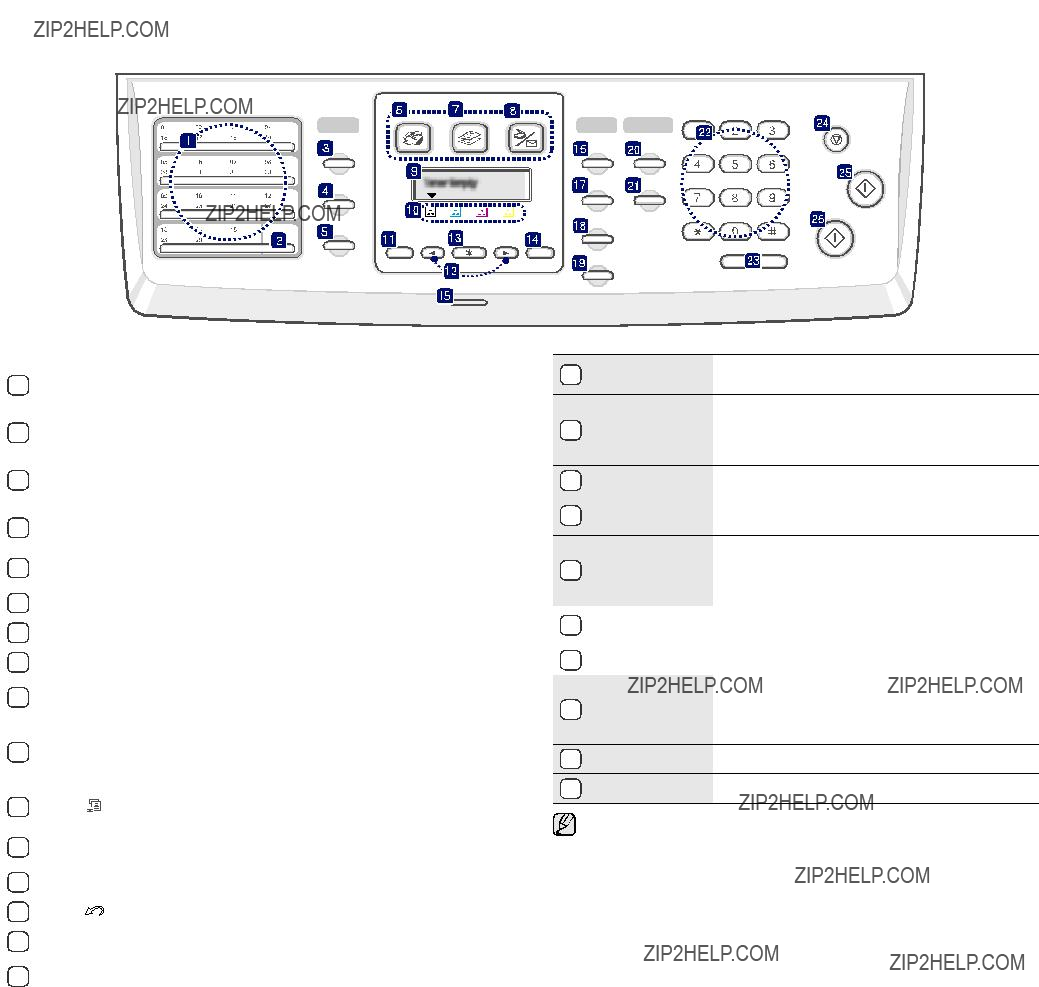
CONTROL PANEL OVERVIEW
You can copy both sides of the ID Card like a
18 ID Copy driver???s license to a single side of paper. See page 40.
Allows you to directly print files stored on a USB
21 USB Print Memory device when it is inserted into the USB memory port on the front of your machine. See
page 59.
Stops an operation at any time. In ready mode,
24 Stop/Clear clears/cancels the copy options, such as the darkness, the document type setting, the copy
size, and the number of copies.
25Color Start Starts a job in Color mode.
26Black Start Starts a job in Black and White mode.
??? All illustrations on this user???s guide may differ from your machine depending on its options or models.
???The surface of the output tray may become hot if you print a large number of pages at once. Make sure that you do not touch the surface, and do not allow children near it.
20 _Introduction

Stops an operation at any time. In ready mode,
18 Stop/Clear clears/cancels the copy options, such as the resolution, the document type setting, the copy
size, and the number of copies.
??? All illustrations on this user???s guide may differ from your machine depending on its options or models.
???The surface of the output tray may become hot if you print a large number of pages at once. Make sure that you do not touch the surface, and do not allow children near it.
Introduction_ 21

UNDERSTANDING THE STATUS LED
The color of the Status LED indicates the machine's current status.
Always check the message on the display to solve the problem. The instruction in the Troubleshooting section will guide you to operate the machine properly. See "Understanding display messages" on page 78 for more information.
ACKNOWLEDGING THE STATUS OF THE
TONER CARTRIDGE
The status of toner cartridges is indicated by the Status LED and the LCD display. If the toner cartridge is low or needs to be replaced, the Status LED turns red and the display shows the message. However the arrow mark shows which color toner is of concern or may be installed with a new cartridge.
Example:
The above example shows the black cartridges status indicated by arrows. Check the message to find out what the problem is and how to solve it. See page 78 to browse the detailed information on error messages.
22 _Introduction
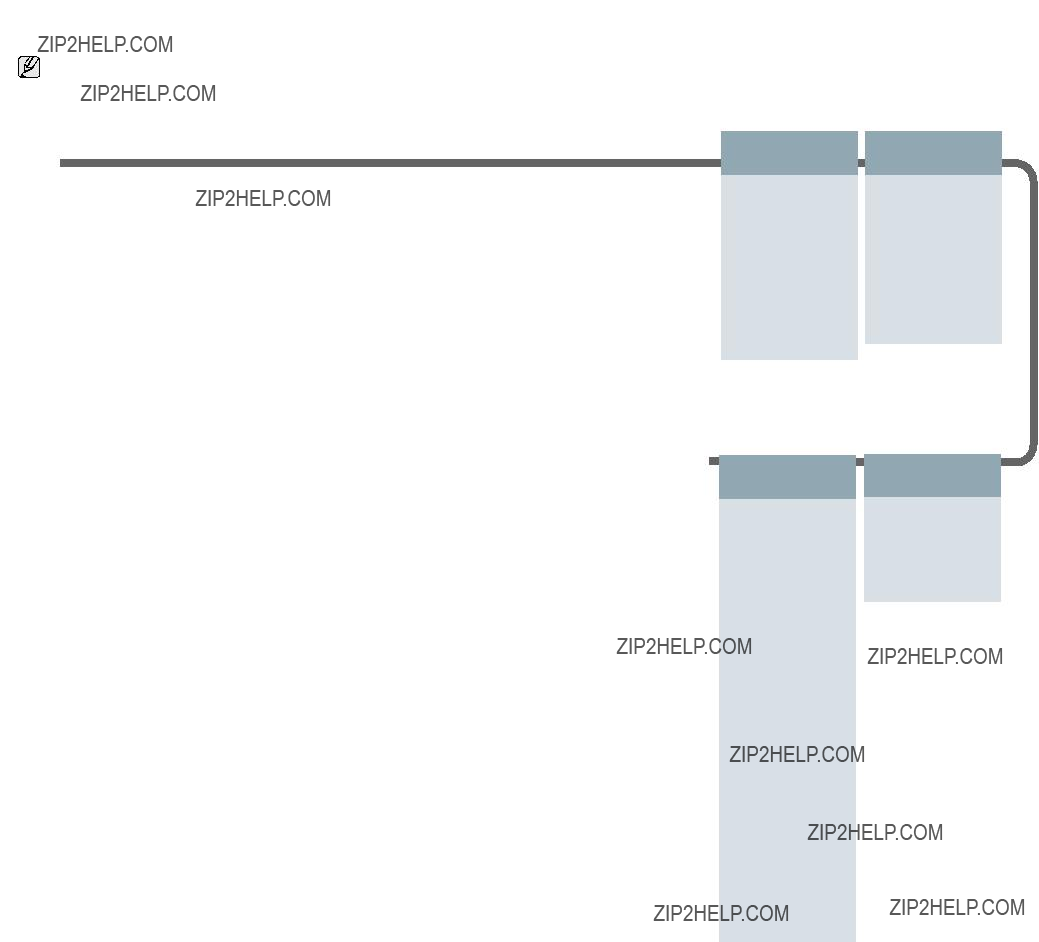
MENU OVERVIEW
The control panel provides access to various menus to set up the machine or use the machine???s functions. These menus can be accessed by pressing Menu ( ). Refer to the following diagram.
). Refer to the following diagram.
Some menus may not appear in the display depending on options or models. If so, it is not applicable to your machine.
.
Scan Feature
USB Memory
Scan Size
Original Type
Resolution
Scan Color
Scan Format
Scan Size
Original Type
Resolution
Scan Color
System Setup
Machine Setup
Machine ID
Machine Fax No.
Date & Time
Clock Mode
Form Menu
Select Form
Language
Default Mode
Power Save
Scan PWR Save
Timeout
Job Timeout
Altitude Adj.
Auto Continue
Net Accounting
Import Setting
Export Setting
Paper Setup
Paper Size
Paper Type
Paper Source
Sound/Volume
Key Sound
Alarm Sound
Speaker
Ringer
Scan Feature
(Continued)
FTP
Scan Size
Original Type
Resolution
Scan Color
SMB
Scan Size
Original Type
Resolution
Scan Color
Scan Setup
Change Default
USB Memory
FTP
SMB
Send Report
Introduction_ 23

SUPPLIED SOFTWARE
You must install the printer and scanner software using the supplied CD after you have set up your machine and connected it to your computer. CD provides you with the following software.
Macintosh ??? Printer driver: Use this driver to take full advantage of your printer???s features.
???Postscript Printer Description (PPD) file: Use this file to run your machine from a Macintosh computer and print documents.
???Scanner driver: TWAIN driver is available for scanning documents on your machine.
???Smart Panel: This program allows you to monitor the machine???s status and alerts you when an error occurs during printing.
a.Allows you to edit a scanned image in many ways using a powerful image editor and to send the image by email. You can also open another image editor program, like Adobe Photoshop, from SmarThru. For details, refer to the onscreen help supplied on the SmarThru program.
PRINTER DRIVER FEATURES
Your printer drivers support the following standard features:
???Paper orientation, size, source and media type selection
???Number of copies
In addition, you can use various special printing features. The following table shows a general overview of features supported by your printer drivers:
Printer driver
a.This feature is not supported MAC OS X 10.3.
PostScript driver
a.This feature is not supported MAC OS X 10.3.
24 _Introduction
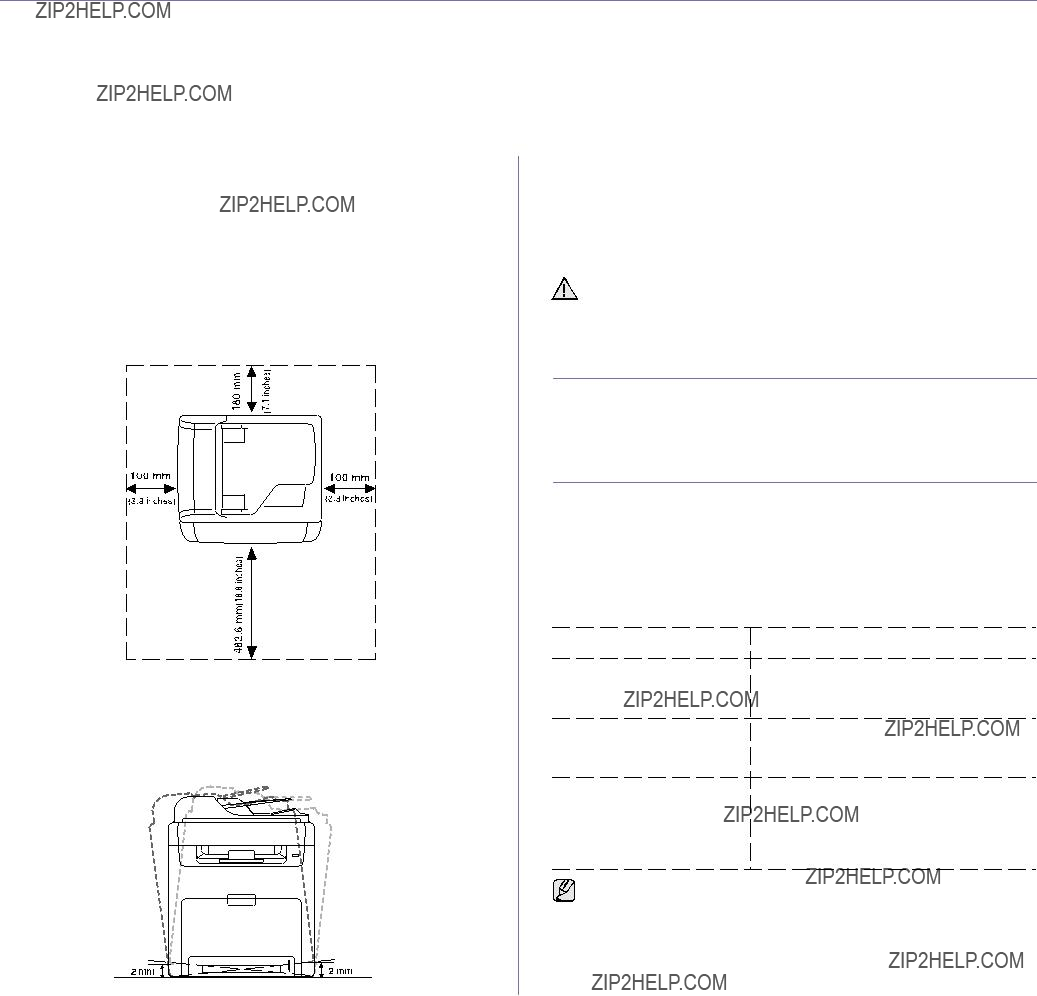
getting started
This chapter gives you
This chapter includes:
SETTING UP THE HARDWARE
This section shows the steps to set up the hardware which is explained in the Quick Install Guide. Make sure you read Quick Install Guide and complete following steps.
1.Select a stable location.
Select a level, stable place with adequate space for air circulation. Allow extra space to open covers and trays.
The area should be
Printing is suitable for altitudes under 1,000 m (3,281 ft). Refer to the altitude setting to optimize your printing. See "Altitude adjustment" on page 28 for more information.
Place the machine on a flat, stable surface so that there is no incline greater than 2 mm (0.08 inch). Otherwise, printing quality may be affected.
2.Unpack the machine and check all the enclosed items.
3.Remove the tape holding the machine tightly.
4.Install the toner cartridge.
5.Load paper. (See "Loading paper" on page 36.)
6.Make sure that all the cables are connected to the machine.
7.Turn the machine on.
When you move the machine, do not tilt or turn it upside down. Otherwise, the inside of the machine may be contaminated by toner, which can cause damage to the machine or bad print quality.
PRINTING A DEMO PAGE
Print a demo page to make sure that the machine is operating correctly. To print a demo page:
In ready mode, press and hold the OK button for about 2 seconds.
SETTING UP THE NETWORK
You need to set up the network protocols on the machine to use it as your network printer. You can set up the basic network settings through the machine's control panel.
Supported operating environments
The following table shows the network environments supported by the machine:
If you want to set up DHCP network protocol, go to http:// developer.apple.com/networking/bonjour/download/, select the Bonjour program that is appropriate for your computer operating system and install the program. This program will allow you to set network parameters automatically. Follow the instructions in the installation window. This program does not support Linux.
Getting started_ 25

Configuring network protocol via the machine
You can set up TCP/IP network parameters, follow the steps listed below.
1.Make sure your machine is connected to the network with an
2.Make sure you have turned on the machine.
3.Press Menu ( ) on the control panel, until you see Network on the bottom line of the display.
) on the control panel, until you see Network on the bottom line of the display.
4.Press OK to access the menu.
5.Press the left/right arrow until TCP/IP displays.
6.Press OK.
7.Press the left/right arrow until Static displays.
8.Press OK.
9.Press the left/right arrow until IP Address displays.
10.Press OK.
Enter a byte between 0 and 255 using the number keypad and press the left/right arrow to move between bytes.
Repeat this to complete the address from the 1st byte to the 4th byte.
11.When you have finished, press OK.
Repeat steps 9 and 10 to configure the other TCP/IP parameters: subnet mask and gateway address.
Contact the network administrator if you are not sure how to configure.
You can also set up the network settings through the network administration programs.
???SyncThru??? Web Admin Service:
internet access. Download this program from http:// solution.samsungprinter.com.
???SyncThru??? Web Service: Web server embedded on your network print server, which allows you to:
-Configure the network parameters necessary for the machine to connect to various network environments.
-Customize machine settings.
???SetIP: Utility program allowing you to select a network interface and manually configure the IP addresses for use with the TCP/IP protocol.
Using the SetIP program
This program is for the network IP setting using the MAC address which is the hardware serial number of the network printer card or interface. Especially, it is for the network administrator to set several network IPs at the same time.
Installing the program
1.Insert the driver CD provided along with your machine. When the driver CD runs automatically, close the window.
2.Start Windows Explorer and open the X drive. (X represents your CD- ROM drive.)
3.Double click Application > SetIP.
4.Open the folder of the language you plan to use.
5.Double click Setup.exe to install this program.
6.Follow the instructions in the window and complete the installation.
Starting the program
1.From the Windows Start menu, select All Programs > Samsung Network Printer Utilities > SetIP.
2.Select the name of your printer and click  .
.
 If you cannot find your printer name, click
If you cannot find your printer name, click  to refresh the list.
to refresh the list.
3.Enter the network card's MAC address, IP address, subnet mask, default gateway, and then click Apply.
If you do not know the network card's MAC address, print the machine's network information report. (See "Printing reports" on page 62.)
4.Click OK to confirm the settings.
5.Click Exit to close the SetIP program.
SYSTEM REQUIREMENTS
Before you begin, ensure that your system meets the following requirements:
Windows
Your machine supports the following Windows operating systems.
??? Internet Explorer 5.0 or higher is the minimum requirement for all Windows operating systems.
???Users who have an administrator right can install the software.
???Windows Terminal Services is compatable with this machine.
Macintosh
26 _Getting started

Linux
??? It is necessary to claim swap partition of 300 MB or larger for working with large scanned images.
???The Linux scanner driver supports the optical resolution at maximum.
INSTALLING THE SOFTWARE
You have to install the machine software for printing. The software includes drivers, applications, and other user friendly programs.
??? The following procedure is for when the machine is being used as a network machine. If you want to connect a machine with a USB cable, refer to Software section.
???The following procedure is based on the Windows XP operating system. The procedure and popup window which appear during the installation may differ depending on the operating system, the printer feature, or the interface in use.
1.Connect the network cable to your machine.
2.Make sure that the network setup for your machine is completed. (See "Setting up the network" on page 25.) All applications should be closed on your computer before beginning installation.
3.Insert the Printer Software
The
If the installation window does not appear, click Start > Run. Type X:\Setup.exe, replacing ???X??? with the letter which represents your drive and click OK.
If you use Windows Vista, click Start > All Programs > Accessories >
Run, and type X:\Setup.exe.
If the AutoPlay window appears in Windows Vista, click Run Setup.exe in Install or run program field, and click Continue in the User Account Control window.
4. Click Next.
??? If necessary, select a language from the
5.Select Typical installation for a network printer, and then click Next.
6.The list of machines available on the network appears. Select the printer you want to install from the list and then click Next.
???If you do not see your machine on the list, click Update to refresh the list, or select Add TCP/IP Port to add your machine to the network. To add the machine to the network, enter the port name and the IP address for the machine.
To verify your machine???s IP address or the MAC address, print a Network Configuration page. (See "Printing reports" on page 62.)
???To find a shared network printer (UNC Path), select Shared Printer [UNC] and enter the shared name manually or find a shared printer
Getting started_ 27

by clicking the Browse button.
If you are not sure of the IP address, contact your network administrator or print network information. (See "Printing reports" on page 62.)
7.After the installation is finished, a window appears asking you to print a test page and to register yourself as a user of Samsung machines in order to receive information from Samsung. If you so desire, select the corresponding checkbox(es) and click Finish.
MACHINE'S BASIC SETTINGS
After installation is complete, you may want to set the machine's default settings. Refer to the next section if you would like to set or change values.
Altitude adjustment
The print quality is affected by atmospheric pressure, which is determined by the height of the machine above sea level. The following information will guide you on how to set your machine to the best print quality or best quality of print.
Before you set the altitude value, find the altitude where you are using the machine.
??? If your machine does not work properly after the installation, try
0
1 Normal
2 High 1
3 High 2
4 High 3
to reinstall the printer driver. See Software section.
???During the printer driver installation process, the driver installer detects the location information for your operating system and sets the default paper size for your machine. If you use a different Windows location, you must change the paper size to match the paper you usually use. Go to printer properties to change the paper size after installation is complete.
1.Ensure that you have installed the printer driver with the provided Printer Software CD.
2.
You can also click Smart Panel on the status bar in Mac OS X.
3.Click Printer Setting.
4.Click Setting > Altitude Adjustment. Select the appropriate value from the dropdown list, and then click Apply.
If your machine is connected to a network, SyncThru Web Service screen appears automatically. Click Machine Settings >
Setup (or Machine Setup) > Altitude adj.. Select the appropriate altitude value, and then click Apply.
Changing the display language
To change the language that appears on the control panel, follow these steps:
1.Press Menu (  ) until System Setup appears on the bottom line of the display and press OK.
) until System Setup appears on the bottom line of the display and press OK.
2.Press OK when Machine Setup appears.
3.Press the left/right arrow until Language appears and press OK.
4.Press the left/right arrow until the language you want appears and press
OK.
5.Press Stop/Clear to return to ready mode.
28 _Getting started
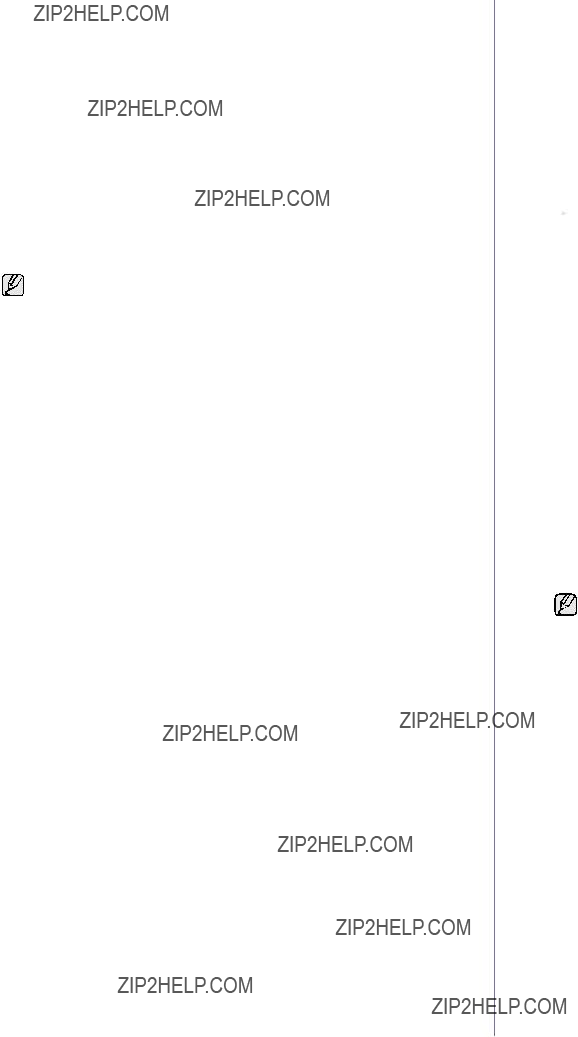
Setting the date and time
The current date and time are shown on the display when your machine is on and ready to work. For the
1.Press Menu ( ) until System Setup appears on the bottom line of the display and press OK.
) until System Setup appears on the bottom line of the display and press OK.
2.Press OK when Machine Setup appears.
3.Press the left/right arrow until Date & Time appears and press OK.
4.Enter the correct time and date using the number keypad.
Month = 01 to 12
Minute = 00 to 59
The date format may differ from country to country
You can also use the left/right arrow to move the cursor under the digit you want to correct and enter a new number.
5.To select AM or PM for
When the cursor is not under the AM or PM indicator, pressing the *or #
button immediately moves the cursor to the indicator.
You can change the clock mode to
6.Press OK to save the time and date.
When you enter a wrong number, Out of Range appears and the machine does not proceed to the next step. If this happens, simply reenter the correct number.
7.Press Stop/Clear to return to ready mode.
Changing the clock mode
You can set your machine to display the current time using either a
1.Press Menu ( ) until System Setup appears on the bottom line of the display and press OK.
) until System Setup appears on the bottom line of the display and press OK.
2.Press OK when Machine Setup appears.
3.Press the left/right arrow until Clock Mode appears and press OK.
4.Press the left/right arrow to select the other mode and press OK.
5.Press Stop/Clear to return to ready mode.
Changing the default mode
Your machine is preset to Fax mode. You can switch this default mode between Fax mode and Copy mode.
1.Press Menu ( ) until System Setup appears on the bottom line of the display and press OK.
) until System Setup appears on the bottom line of the display and press OK.
2.Press OK when Machine Setup appears.
3.Press the left/right arrow until Default Mode appears and press OK.
4.Press the left/right arrow until the default mode you want appears and press OK.
5.Press Stop/Clear to return to ready mode.
Setting sounds
You can control the following sounds:
???Key Sound: Turns the key sound on or off. With this option set to On, a tone sounds each time a key is pressed.
???Alarm Sound: Turns the alarm sound on or off. With this option set to On, an alarm tone sounds when an error occurs or fax communication ends.
???Speaker
 You can adjust the volume level using On Hook Dial.
You can adjust the volume level using On Hook Dial.
???Ringer
High.
Speaker, ringer, key sound, and alarm sound
1.Press Menu ( ) until System Setup appears on the bottom line of the display and press OK.
) until System Setup appears on the bottom line of the display and press OK.
2.Press the left/right arrow until Sound/Volume appears and press
OK.
3.Press the left/right arrow until the sound option you want appears and press OK.
4.Press the left/right arrow until the desired status or volume for the sound you have selected appears and press OK.
5.If necessary, repeat steps 3 through 5 to set other sounds.
6.Press Stop/Clear to return to ready mode.
Speaker volume
1.Press On Hook Dial. A dial tone sounds from the speaker.
2.Press the left/right arrow until you hear the volume you want.
3.Press Stop/Clear to save the change and return to ready mode.
You can adjust the speaker volume only when the telephone line is connected.
Entering characters using the number keypad
As you perform various tasks, you may need to enter names and numbers. For example, when you set up your machine, you enter your name or your company???s name, and the fax number. When you store fax numbers or email addresses in memory, you may also enter the corresponding names.
Entering alphanumeric characters
1.When you are prompted to enter a letter, locate the button labeled with the character you want. Press the button until the correct letter appears on the display.
For example, to enter the letter O, press 6, labeled with MNO. Each time you press 6, the display shows a different letter, M, N, O, m, n, o and finally 6.
You can enter special characters, such as space, plus sign, and etc. For details, see the below section.
2.To enter additional letters, repeat step 1.
If the next letter is printed on the same button, move the cursor by pressing the right left/right arrow button and then press the button labeled with the letter you want. The cursor will move to the right and the next letter will appear on the display.
You can enter a space by pressing 1 twice.
3.When you have finished entering letters, press OK.
Getting started_ 29

Keypad letters and numbers
Correcting numbers or names
If you make a mistake while entering a number or name, press the left left/right arrow button to delete the last digit or character. Then enter the correct number or character.
Inserting a pause
With some telephone systems, you must dial an access code (9, for example) and listen for a second dial tone. In such cases, you must insert a pause in the telephone number. You can insert a pause while you are setting up speed buttons or speed dial numbers.
To insert a pause, press Redial/Pause at the appropriate place while entering the telephone number. A - appears on the display at the corresponding location.
Using the save modes
Power Save mode
Power Save mode allows your machine to reduce power consumption when it is not in actual use. You can turn this mode on and select a length of time for which the machine waits after a job is printed before it switches to a reduced power state.
1.Press Menu ( ) until System Setup appears on the bottom line of the display and press OK.
) until System Setup appears on the bottom line of the display and press OK.
2.Press OK when Machine Setup appears.
3.Press the left/right arrow until Power Save appears and press OK.
4.Press the left/right arrow until the time setting you want appears and press OK.
5.Press Stop/Clear to return to ready mode.
Scan Power Save mode
Scan Power Save mode allows you to save power by turning off the scan lamp. The scan lamp under the scanner glass automatically turns off when it is not in actual use to reduce power consumption and extend the life of the lamp. The lamp automatically wakes up after some warm- up time when you start scanning.
You can set the length of time for which the scan lamp waits after a scan job is completed before it switches to the power save mode.
1.Press Menu ( ) until System Setup appears on the bottom line of the display and press OK.
) until System Setup appears on the bottom line of the display and press OK.
2.Press OK when Machine Setup appears.
3.Press the left/right arrow until Scan PWR Save appears and press
OK.
4.Press the left/right arrow until the time setting you want appears and press OK.
5.Press Stop/Clear to return to ready mode.
Setting print job timeout
You can set the amount of time a single print job is active before it must print.The machine handles incoming data as a single job if it comes in within the specified time. When an error occurs while processing data from the computer and the data flow stops, the machine waits the specified time and then cancels printing if data flow does not resume.
1.Press Menu ( ) until System Setup appears on the bottom line of the display and press OK.
) until System Setup appears on the bottom line of the display and press OK.
2.Press OK when Machine Setup appears.
3.Press the left/right arrow until Job Timeout appears and press OK.
4.Press the left/right arrow until the time setting you want appears and press OK.
5.Press Stop/Clear to return to ready mode.
Auto continue
This is the option to set the machine to continue printing or not, in case the paper size you have set and the paper within the tray mismatches.
1.Press Menu ( ) until System Setup appears on the bottom line of the display and press OK.
) until System Setup appears on the bottom line of the display and press OK.
2.Press OK when Machine Setup appears.
3.Press the left/right arrow until Auto Continue appears and press OK.
4.Press the left/right arrow until the binding option you want appears.
???On: Automatically prints after set time passes, when the paper size mismatches the tray paper size.
???Off: Waits until you press Black Start or Color Start on the control panel, when the paper size mismatches the tray paper size.
5.Press OK to save your selection.
6.Press Stop/Clear to return to ready mode.
Net accounting
Net Accounting function limits the number of use for fax, printer, copy and scan. First, user need to install Net account
SyncThru??? Web Admin Service.
If you are not registered, request Administrator for a registration. (See page
26)
1.Press Menu ( ) until System Setup appears on the bottom line of the display and press OK.
) until System Setup appears on the bottom line of the display and press OK.
2.Press OK when Machine Setup appears.
3.Press the left/right arrow until Net Accounting appears and press OK.
4.Press the left/right arrow until the option you want appears and press
OK.
???Protect: Select the option for which you want to enable or disable
Net Accounting.
???Chg.Password: The access password code can be changed.
5.Press Stop/Clear to return to ready mode.
30 _Getting started

Changing the font setting
Your machine has preset the font for your region or country.
If you want to change the font or set the font for special condition such as the DOS environment, you can change the font setting as follows:
1.Ensure that you have installed the printer driver from the provided software CD.
2.
3.Click Printer Setting.
4.Click Emulation.
5.Confirm if PCL is selected in Emulation Setting.
6.Click Setting.
7.Select your preferred font in the Symbol set list.
8.Click Apply.
Following information shows the proper font list for corresponding languages.
???Russian: CP866, ISO 8859/5 Latin Cyrillic
???Hebrew: Hebrew 15Q,
???Greek: ISO 8859/7 Latin Greek,
???Arabic & Farsi: HP
???OCR :
Getting started_ 31

loading originals and print media
This chapter introduces you how to load originals and print media into your machine.
This chapter includes:
???Changing the size of the paper in the paper tray
LOADING ORIGINALS
You can use the scanner glass or DADF (or ADF) to load an original for copying, scanning, and sending a fax.
On the scanner glass
Make sure that no originals are in the DADF (or ADF). If an original is detected in the DADF (or ADF), the machine gives it priority over the original on the scanner glass. To get the best scan quality, especially for colored or
1. Lift and open the scanner lid.
???Adjusting the output support
???Setting the paper size and type
2.Place the original face down on the scanner glass and align it with the registration guide at the top left corner of the glass.
3. Close the scanner lid.
??? Leaving the scanner lid open while copying may affect copy quality and toner consumption.
???Dust on the scanner glass may cause black spots on the printout. Always keep it clean.
???If you are copying a page from a book or magazine, lift the scanner lid until its hinges are caught by the stopper and then close the lid. If the book or magazine is thicker than 30 mm, start copying with the lid open.
In the DADF (or ADF)
Using the DADF (or ADF), you can load up to 50 sheets of paper (75 g/m2, 20 lb bond) for one job.
When you use the DADF (or ADF):
???In the ADF: Do not load paper smaller than 142 x 148 mm (5.6 x
5.8inches) or larger than 216 x 356 mm (8.5 x 14 inches).
???In the DADF: Do not load paper smaller than 148 x 148 mm (5.8 x
5.8inches) or larger than 216 x 356 mm (8.5 x 14 inches).
???Do not attempt to load the following types of paper: -
- coated paper
- onion skin or thin paper
- wrinkled or creased paper - curled or rolled paper
- torn paper
???Remove all staples and paper clips before loading.
???Make sure any glue, ink, or correction fluid on the paper is completely dry before loading.
???Do not load originals that include different sizes or weights of paper.
32 _Loading originals and print media

???Do not load booklets, pamphlets, transparencies, or documents having other unusual characteristics.
1.Flex or fan the edge of the paper stack to separate the pages before loading originals.
2.Load the original face up into the DADF (or ADF). Make sure that the bottom of the original stack matches the paper size marked on the document input tray.
3. Adjust the document width guides to the paper size.
Dust on the DADF (or ADF) glass may cause black lines on the printout. Always keep it clean.
SELECTING PRINT MEDIA
You can print on a variety of print media, such as plain paper, envelopes, labels, and transparencies. Always use print media that meet the guidelines for use with your machine. Print media that does not meet the guidelines outlined in this user???s guide may cause the following problems:
???Poor print quality
???Increased paper jams
???Premature wear on the machine.
Properties, such as weight, composition, grain, and moisture content, are important factors that affect the machine???s performance and the output quality. When you choose print materials, consider the following:
???The type, size and weight of the print media for your machine are described later in this section.
???Desired outcome: The print media you choose should be appropriate for your project.
???Brightness: Some print media are whiter than others and produce sharper, more vibrant images.
???Surface smoothness: The smoothness of the print media affects how crisp the printing looks on the paper.
??? Some print media may meet all of the guidelines in this section and still not produce satisfactory results. This may be the result of improper handling, unacceptable temperature and humidity levels, or other variables over which Samsung has no control.
???Before purchasing large quantities of print media, ensure that it meets the requirements specified in this user???s guide.
Using print media that does not meet these specifications may cause problems, requiring repairs. Such repairs are not covered by Samsung???s warranty or service agreements.
Loading originals and print media_ 33
Specifications on print media
a.If media weight is over 105 g/m2 (28 lb bond), use the
b.Maximum capacity may differ depending on media weight, thickness, and environmental conditions.
34 _Loading originals and print media

Media sizes supported in each mode
a.
b.75 to 105 g/m2 (20~28 lb bond) only
Guidelines for special print media
Loading originals and print media_ 35

CHANGING THE SIZE OF THE PAPER IN THE
PAPER TRAY
To load longer sizes of paper, such as
1 Tray extend lever
2 Paper length guide
3 Paper width guide
1.Adjust the paper length guide to the desired paper length. It is preset to Letter or A4 size depending on the country.
2.After inserting paper into the tray, while pinching the paper width guide as shown, move it toward the stack of paper until it lightly touches the side of the stack. Do not press the guide too tightly to the edge of the paper; the guide may bend the paper.
When you use
3.Press and hold the green lever on the back of the tray, when you are holding the lever, extend the tray to the corresponding position.
4. Load the paper into the tray.
5.Place the tray into the machine.
6.Set the paper size from your computer.
??? Do not push the paper width guides far enough to cause the materials to warp.
???If you do not adjust the paper width guides, it may cause paper jams.
LOADING PAPER
Loading paper in the tray 1 or optional tray
Load the print media you use for the majority of your print jobs in the tray 1.
The tray 1 can hold a maximum of 250 sheets of 75 g/m2 (20 lb bond) plain paper.
You can purchase an optional tray and attach it below the standard tray to load an additional 500 sheets of paper. (See "" on page 91.)
Using photographic paper or coated paper may cause problems, requiring repairs. Such repairs are not covered by Samsung???s warranty or service agreements.
1.To load paper, pull and open the paper tray and place paper with the side you want to print facing up.
2.After loading paper, set the paper type and size for the tray 1. See
Software section for
??? If you experience problems with paper feed, place one sheet at a time in the
???You can load previously printed paper. The printed side should be facing down with an uncurled edge at the front. If you experience problems with paper feed, turn the paper around. Note that print quality is not guaranteed.
36 _Loading originals and print media

Loading paper in the
The
Tips on using the
???Load only one size of print media at a time in the
???To prevent paper jams, do not add paper when there is still paper in the
???Print media should be loaded face down with the top edge going into the
???Always load only the specified print media to avoid paper jams and print quality problems. (See "Selecting print media" on page 33.)
???Flatten any curl on postcards, envelopes, and labels before loading them into the
1.Hold the handle of
2. Load the paper.
??? If you want to load the used paper, place the paper with the printed side facing down.
???If you are using paper, flex or fan the edge of the paper stack to separate the pages before loading.
3.Squeeze the
Depending on the media type you are using, keep the following loading guidelines:
???Envelopes: Flap side down and with the stamp area on the top left side.
???Labels: Print side up and top short edge entering the machine first.
???Preprinted paper: Design side up with the top edge toward the machine.
???Card stock: Print side up and the short edge entering the machine first.
???Previously printed paper: Previously printed side down with an uncurled edge toward the machine.
4.After loading paper, set the paper type and size for the
The settings made from the printer driver override the settings on the control panel.
5. After printing, close the
Loading originals and print media_ 37

ADJUSTING THE OUTPUT SUPPORT
The printed pages stack on the output tray, and the output support will help the printed pages to align. For the output support to correctly align the
pages, you need to pull it out appropriately depending on the paper size.
1 Output support
2 Extension
??? If the output support is incorrectly adjusted, printed pages may be
???If you continuously print many pages, the surface of the output tray may become hot. Be careful not to touch the surface, and especially keep out of children???s reach.
For
Pull out the output support to the location indicated LTR as shown, and unfold the extension.
For A4- or
Pull out the output support to the location indicated A4, LGL as shown, and unfold the extension.
SETTING THE PAPER SIZE AND TYPE
After loading paper in the paper tray, you need to set the paper size and type using the control panel buttons. These settings will apply to Copy and Fax modes. For
1.Press Menu (  ) until System Setup appears on the bottom line of the display and press OK.
) until System Setup appears on the bottom line of the display and press OK.
2.Press the left/right arrow until Paper Setup appears and press OK.
3.Press OK when Paper Size appears.
4.Press the left/right arrow until the paper tray you want appears and press OK.
5.Press the left/right arrow until the paper size you are using appears and press OK.
6.Press Back ( ) to return to the upper level.
) to return to the upper level.
7.Press the left/right arrow until Paper Type appears and press OK.
8.Press the left/right arrow until the paper type you are using appears and press OK.
9.Press Stop/Clear to return to ready mode.
If you want to use special sized paper such as a billing paper, select Custom in the Paper tab in the printer propeties. See Software section.
38 _Loading originals and print media

copying
This chapter gives you
SELECTING THE PAPER TRAY
After loading the print media for copy output, you must select the paper tray you will use for copy jobs.
1.Press Menu ( ) until System Setup appears on the bottom line of the display and press OK.
) until System Setup appears on the bottom line of the display and press OK.
2.Press the left/right arrow until Paper Setup appears and press OK.
3.Press the left/right arrow until Paper Source appears and press OK.
4.Press OK when Copy Tray appears.
5.Press the left/right arrow until the paper tray you want appears and press OK.
6.Press Stop/Clear to return to ready mode.
COPYING
1.Press Copy.
Ready to Copy appears on the top line of the display.
2.Load originals face up into the DADF (or ADF), or place a single original face down on the scanner glass.
For details about loading an original, see page 32.
3.Enter the number of copies using the number keypad, if necessary.
4.If you want to customize the copy settings including copy size, darkness, and original type, by using the control panel buttons. See page 39.
If necessary, you can use special copy features, such as poster copying, 2- or
5.Press Color Start to begin color copying.
Or, press Black Start to begin black and white copying.
You can cancel the copy job during an operation. Press Stop/Clear, and the copying will stop.
CHANGING THE SETTINGS FOR EACH COPY
Your machine provides default settings for copying so that you can quickly and easily make a copy. However, if you want to change the options for each copy, use the copy function buttons on the control panel.
If you press Stop/Clear while setting the copy options, all of the options you have set for the current copy job will be canceled and returned to their default status. Or, they will automatically return to their default status after the machine completes the copy in progress.
Darkness
If you have an original containing faint markings and dark images, you can adjust the brightness to make a copy that is easier to read.
To adjust the darkness of copies, press Darkness. Each time you press the button, the following modes are available:
???Lightest: Works well with darker print.
???Light: Works well with dark print.
???Normal: Works well with standard typed or printed originals.
???Dark: Works well with light print.
???Darkest: Works well with lighter print or faint pencil markings.
Original Type
The original type setting is used to improve the copy quality by selecting the document type for the current copy job.
To select the document type, press Original Type. Each time you press the button, the following modes are available:
???Text: Use for originals containing mostly text.
???Text/Photo: Use for originals with mixed text and photographs.
???Photo: Use when the originals are photographs.
???Magazine: Use when the originals are magazines.
Reduced or enlarged copy
By using the Reduce/Enlarge button, you can reduce or enlarge the size of a copied image from 25% to 400% when you copy original documents from the scanner glass, or from 25% to 100% from the DADF (or ADF).
To select from the predefined copy sizes:
1.Press Reduce/Enlarge.
2.Press Reduce/Enlarge or the left/right arrow until the size setting you want appears and press OK.
To scale the copy by directly entering the scale rate:
1.Press Reduce/Enlarge.
2.Press Reduce/Enlarge or the left/right arrow until Custom appears and press OK.
3.Enter the scale rate and press OK to save the selection.
When you make a reduced copy, black lines may appear at the bottom of your copy.
Copying_ 39
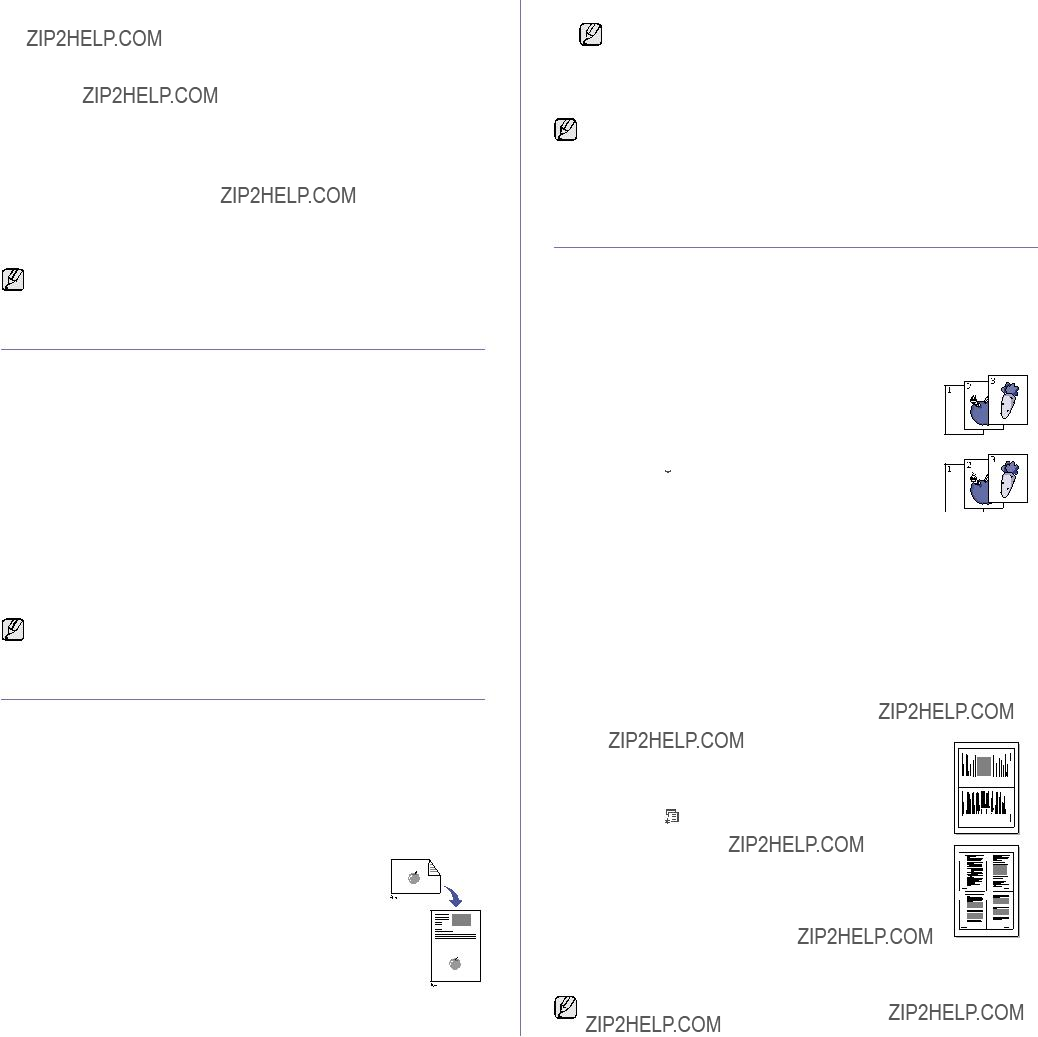
CHANGING THE SCAN SIZE SETTINGS
You can adjust the scan size for the original paper. For example, if you scan a
1.Press Copy.
2.Press Menu ( ) until Copy Setup appears on the bottom line of the display and press OK.
) until Copy Setup appears on the bottom line of the display and press OK.
3.Press OK when Scan Size appears.
4.Press the left/right arrow until the setting you want appears and press
OK.
5.Press Stop/Clear to return to ready mode.
After using this option, the machine automatically resumes to the default setting.
CHANGING THE DEFAULT COPY SETTINGS
The copy options, including darkness, original type, copy size, and number of copies, can be set to those most frequently used. When you copy a document, the default settings are used unless they have been changed by using the corresponding buttons on the control panel.
1.Press Copy.
2.Press Menu ( ) until Copy Setup appears on the bottom line of the display and press OK.
) until Copy Setup appears on the bottom line of the display and press OK.
3.Press OK when Change Default appears.
4.Press the left/right arrow until the setup option you want appears and press OK.
5.Press the left/right arrow until the setting you want appears and press
OK.
6.Repeat steps 4 through 5, as needed.
7.Press Stop/Clear to return to ready mode.
While you are setting copy options, pressing Stop/Clear cancels the changed settings and restores the defaults.
ID CARD COPYING
Your machine can print
When you copy using this feature, the machine prints one side of the original on the upper half of the paper and the other side on the lower half without reducing the size of the original. This feature is helpful for copying a
This copy feature is available only when you place originals on the scanner glass.
1. Press ID Copy.
2. Place a single original face down on the scanner glass. For details about loading an original, see page 32.
3. Place Front Side and Press[Start] appears on the display.
4. Press Color Start or Black Start.
Your machine begins scanning the front side and shows Place Back Side and Press[Start]
5. Open the scanner lid and turn the original over.
If you press Stop/Clear or if no buttons are pressed for approximately 30 seconds, the machine cancels the copy job and returns to ready mode.
6.Press Color Start to begin color copying.
Or, press Black Start to begin black and white copying
If the original is larger than the printable area, some portions may not be printed.
If you press Stop/Clear or if no buttons are pressed for approximately 30 seconds, the machine cancels the copy job and returns to ready mode.
USING SPECIAL COPY FEATURES
You can use the following copy features:
Collation
You can set the machine to sort the copy job. For example, if you make 2 copies of a 3 page original, one complete 3 page document will print followed by a second complete document.
1. Press Copy.
2. Load originals face up into the DADF (or ADF), or place a single original face down on the scanner glass.
For details about loading an original, see page 32.
3. Enter the number of copies using the number keypad.
4. Press Menu ( ) until Copy Feature appears on the bottom line of the display and press OK.
) until Copy Feature appears on the bottom line of the display and press OK.
5. Press OK when Copy Collation appears.
6.Press the left/right arrow to select the color mode you want.
There are two types of mode as following:
???
???
7.Press OK to begin copying.
One complete document will print followed by the second complete document.
Your machine can print 2 or 4 original images reduced to fit onto one sheet of paper.
There are two types of mode as following:
???
???
6.Press OK to begin copying.
You cannot adjust the copy size using the Reduce/Enlarge button for making a 2- or
40 _Copying

Poster copying
Your machine can print an image onto 9 sheets of paper (3x3). You can paste the printed pages together to make one
This copy feature is available only when you place originals on the scanner glass.
1. Press Copy.
2. Place a single original face down on the scanner glass. For details about loading an original, see page 32.
3. Press Menu ( ) until Copy Feature appears on the bottom line of the display and press OK.
) until Copy Feature appears on the bottom line of the display and press OK.
4. Press the left/right arrow until Poster Copy appears and press OK.
5. Press the left/right arrow to select the color mode you want.
There are two types of mode as following:
???
???
6.Press OK to begin copying.
Your original is divided into 9 portions. Each portion is scanned and printed one by one in the following order:
Clone copying
Your machine can print multiple image copies from the original document on a single page. The number of images is automatically determined by the original image and paper size.
This copy feature is available only when you place originals on the scanner glass.
1. Press Copy.
2. Place a single original face down on the scanner glass. For details about loading an original, see page 32.
3. Press Menu ( ) until Copy Feature appears on the bottom line of the display and press OK.
) until Copy Feature appears on the bottom line of the display and press OK.
4. Press the left/right arrow until Clone Copy appears and press OK.
5.Press the left/right arrow to select the color mode you want.
There are two types of mode as following:
???
???
6.Press OK to begin copying.
You cannot adjust the copy size using the Reduce/Enlarge button while making a clone copy.
Adjusting background images
You can set the machine to print an image without its background. This copy feature removes the background color and can be helpful when copying an original containing color in the background, such as a newspaper or a catalog.
1.Press Copy.
2.Load originals face up into the DADF (or ADF), or place a single original face down on the scanner glass.
For details about loading an original, see page 32.
3.Press Menu ( ) until Copy Feature appears on the bottom line of the display and press OK.
) until Copy Feature appears on the bottom line of the display and press OK.
4.Press the left/right arrow until Adjust Bkgd. appears and press OK.
5.Press the left/right arrow until the binding option you want appears.
???Off: Does not use this feature.
???Auto: Optimizes the background.
???Enhance Lev. 1~2: The higher the number is, the more vivid the background is.
???Erase Lev. 1~4: The higher the number is, the lighter the background is.
6.Press OK to begin copying.
7.Press Stop/Clear to return to ready mode.
Book copying
The Book Copy feature allows you to copy an entire book. If the book is too thick, lift the cover until its hinges are caught by the stopper and then close the cover. If the book or magazine is thicker than 30 mm, start copying with the cover open.
1. Press Copy.
2. Place a single original face down on the scanner glass. For details about loading an original, see page 32.
3. Press Menu (  ) until Copy Feature appears on the bottom line of the display and press OK.
) until Copy Feature appears on the bottom line of the display and press OK.
4. Press OK when Book Copy appears.
5. Press the left/right arrow until the binding option you want appears.
???Off: Does not use this feature.
???Left Page: Use this option to print left page of the book.
???Right Page: Use this option to print right page of the book.
???Both Page: Use this option to print both pages of the book.
6.Press the left/right arrow to select the color mode you want. There are two types of mode as following:
???
???
7.Press OK to begin copying.
Margin shift
The Margin Shift feature allows you to create a binding edge for the document. The image can be adjusted up or down on the page and/or shifted to the right or left.
The Margin Shift feature can either be used for Scan glass or DADF (or ADF) depending on the set up.
1. Press Copy.
2. Load originals face up into the DADF (or ADF), or place a single original face down on the scanner glass.
For details about loading an original, see page 32.
3. Press Menu ( ) until Copy Feature appears on the bottom line of the display and press OK.
) until Copy Feature appears on the bottom line of the display and press OK.
4.Press OK when Margin Shift appears.
5.Press the left/right arrow until the binding option you want appears.
???Off: This feature is disabled.
???Auto Center: Automatically copy in the center of the paper.
Copying_ 41

???Custom Margin: Enter the left, right, top, bottom margin using Number keypad.
6.Press the left/right arrow to select Yes.
7.Press OK to begin copying.
8.Press Stop/Clear to return to ready mode.
Edge erase
Edge erase allows you to erase sports, drill holes, fold creases and staple marks along any of the four edges of a document.
The Edge Erase feature can either be used for scan glass or DADF (or ADF) depending on the set up.
1. Press Copy.
2. Load originals face up into the DADF (or ADF), or place a single original face down on the scanner glass.
For details about loading an original, see page 32.
3. Press Menu ( ) until Copy Feature appears on the bottom line of the display and press OK.
) until Copy Feature appears on the bottom line of the display and press OK.
4.Press OK when Edge Erase appears.
5.Press the left/right arrow until the binding option you want appears.
???Off: Does not set the binding option.
???Small Original. Erases the edge of the original if it is small.
???Hole Punch. Erases the marks of bookbinding holes.
???Book Center. Erases the middle part of the paper which is black and horizontal, when you copy a book.
???Border Erase. Erases the certain amount of the edge of the printout.
6.Press OK to begin copying.
7.Press Stop/Clear to return to ready mode.
Gray enhance copying
When you copy the original in gray scale, use this feature for the better quality of
1.Press Copy.
2.Load originals face up into the DADF (or ADF), or place a single original face down on the scanner glass.
For details about loading an original, see page 32.
3.Press Menu ( ) until Copy Feature appears on the bottom line of the display and press OK.
) until Copy Feature appears on the bottom line of the display and press OK.
4.Press OK when Gray Enhance appears.
5.Press the left/right arrow to select On.
6.Press OK to begin copying.
7.Press Stop/Clear to return to ready mode.
PRINTING ON BOTH SIDES OF PAPER
By using the Duplex button on your machine, you can set the machine to print documents on both sides of paper.
1.Press Copy.
2.Press Duplex.
3.Press the left/right arrow until the binding option you want appears.
??? Off: Copys in Normal mode.
???
When Original Type is set in Photo,
???
When Original Type is set in Photo,
???2
???2
???2
4.Press OK to save your selection.
If the mode is enabled, the Duplex button is backlit.
SETTING COPY TIMEOUT
You can set the time the machine waits before it restores the default copy settings, if you do not start copying after changing them on the control panel.
1.Press Menu (  ) until System Setup appears on the bottom line of the display and press OK.
) until System Setup appears on the bottom line of the display and press OK.
2.Press OK when Machine Setup appears.
3.Press the left/right arrow until Timeout appears and press OK.
42 _Copying

4.Press the left/right arrow until the time setting you want appears.
Selecting Off means that the machine does not restore the default settings until you press Black Start or Color Start to begin copying, or
Stop/Clear to cancel.
5.Press OK to save your selection.
6.Press Stop/Clear to return to ready mode.
Copying_ 43

scanning
Scanning with your machine lets you turn pictures and text into digital files that can be stored on your computer.
This chapter includes:
???Scanning from the control panel
???Scanning by a network connection
???Changing the settings for each scan job
The maximum resolution that can be achieved depends upon various factors, including computer speed, available disk space, memory, the size of the image being scanned, and bit depth settings. Thus, depending on your system and what you are scanning, you may not be able to scan at certain resolutions, especially using enhanced resolution.
SCANNING BASICS
You can scan the originals with your machine via an USB cable or the network.
???Samsung Scan Manager: You just walk to the machine with the originals and scan them from the control panel then, the scanned data will be stored in the connected computers My Documents folder. When the setup installation is completed, then you have installed the Samsung Scan Manager on your computer already. This feature can be used via the local connection or the network connection. See next section.
???TWAIN: TWAIN is the one of preset imaging applications. Scanning an image launches the selected application, enabling you to control the scanning process. See the Software section. This feature can be used via the local connection or the network connection. See Software section.
???Samsung SmarThru Office : This feature is the accompanying software for your machine. You can use this program to scan images or documents, and this feature can be used via the local connection or the network connection. See Software section.
???WIA: WIA stands for Windows Images Acquisition. To use this feature your computer must be connected directly with the machine via an USB cable. See Software section.
???Email: You can send the scanned image as an attachment to an email. See page 46.
???FTP: You can scan an image and upload it to an FTP server. See page 47.
???SMB: You can scan an image and send it to a shared folder on an SMB server. See page 47.
???Changing the default scan settings
???Scan on both sides of paper
SCANNING FROM THE CONTROL PANEL
Your machine offers you to scan from the control panel and easily send the scanned document to connected computer's My Documents folder. In order to use this function, your machine and computer must be connect by USB cable or by network.
Also, with the offered Samsung Scan Manager program, scanned documents can be opened with the program you have setup previously. Such as Microsoft Paint, Email, SmarThru Office, OCR can be added to application program. See "Setting scan information in Samsung Scan Manager." on page 44.
Scanned images can be saved as BMP, JEPG, TIFF, PDF files.
Setting scan information in Samsung Scan Manager.
You can find out about Samsung Scan Manager program information and installed scan driver's condition. Also, you can change scan settings and add or delete the folders where scanned documents to computer are save in
Samsung Scan Manager program.
Samsung Scan Manager program can only be used in the Window and Macintosh system. If you use the Macintosh, See Software section.
1.Press Start>Control Panel> Samsung Scan Manager.
Samsung Scan Manager Administration appears.
You can open Samsung Scan Manager by pressing the Smart Panel icon's right in the window task bar.
2.Select the appropriate machine from the Samsung Scan Manager.
3.Press Scan Property.
4.Set Scan Button allows you to change the saving destination and scan settings, add or delete application program and format files.
You can change the scanning machine by using Change Port. (Local or Network)
5.Press OK after setting is done.
Scanning to application programs
1.Make sure that your machine and computer are turned on and properly connected to each other.
2.Load originals face up into the DADF (or ADF), or place a single original face down on the scanner glass.
For details about loading an original, see page 32.
3.Press Scan/Email.
Ready to Scan appears on the top line of the display.
4.Press the left/right arrow until Scan to PC appears on the bottom line of the display and press OK.
5.Press the left/right arrow until the option you want appears and press
OK.
44 _Scanning

6.Depending on the port connection, different massages appear. Check the following messages and move on to the next step.
???Scan Destination: Connected by USB. Move to step 7.
???ID: Connected by Network and user is registered. Move to step 6.
???WLocal PC X: Choosing USB or Network to scan. If connected by USB, move to step 5. If connected by Network, move to step 6.
???Not Available: Neither connected by USB nor Network. Check the port connection.
7.Press the left/right arrow until the port you want appears on the display.
8.Enter the registered user ID and PIN and click OK.
??? ID is the same ID as the registered ID for Samsung Scan Manager.
???PIN is the 4 digit number registered for Samsung Scan Manager.
9.From Scan Destination, press the left/right arrow until the application program you want appears, then press OK.
Default setting is My Documents.
To add or delete the folder where the scanned file is saved, add or delete the application program in Samsung Scan Manager>Set Scan Button.
10.To scan from the default setting, press Color Start or Black Start. Press the left/right button until the setting you want appears then press OK.
11.Scanning begins.
??? Scanned image is saved in computer's My Documents> My Pictures>Samsung folder.
???You can use Tawin driver to scan quickly in Samsung Scan Manager program.
???You can also scan by pressing Window's Start>Control Panel> Samsung Scan Manager>Quick Scan.
SCANNING BY A NETWORK CONNECTION
If you have connected your machine to a network and set up the network parameters correctly, you can scan and send images over the network.
Preparing for network scanning
Before using your machine???s network scanning features, you need to configure the following settings, depending on your scan destination:
???Register as an authorized user for scanning to email, FTP, or SMB
???Set up the SMTP server for scanning to email
???Set up the FTP servers for scanning to FTP
???Set up the SMB servers for scanning to SMB
User authentication for network scanning
To send an email, FTP, SMB or Network, you must register authorized local or network users using SyncThru??? Web Service.
???If user authentication has been activated, only authorized local users or on the DB server (SMB, LDAP, Kerberos) can send scanned data to the network (email, FTP, SMB, Network).
???For network scanning using the authentication feature, you must register the network or local authentication configuration using the SyncThru??? Web Service.
???User authentication has 3 options: none (Default), network authentication, and local authentication.
Registering local authorized users
1.Enter your machine???s IP address as the URL in a browser and click Go to access the web site of your machine.
2.Click Machine Settings.
3.Select Local Authentication on the General Setup of the User Authentication web page.
4.Click Add.
5.Select an index number corresponding to the location for storing the entry, from 1 to 50.
6.Enter your name, auth ID, password,
You need to enter the registered user ID and password in the machine when you start scanning to email from the control panel.
7.Click Apply.
Register authorized network users
1.Enter your machine???s IP address as the URL in a browser and click Go to access the web site of your machine.
2.Click Machine Settings.
3.Select Network Authentication on the General Setup of User Authentication web page.
4.Click Apply and OK.
5.Select the Authentication Type that you prefer.
6.Configure the values for each feature, as follows.
7.Click Apply.
Network user authenticated by Kerberos
1.Enter the realm used for Kerberos login.
2.Select IP Address or Host Name.
3.Enter the IP address in dotted decimal notation or as a host name.
4.Enter the server port number, from 1 to 65535. The default port number is 88.
5.You can add a backup domain as a previous step.
6.Click Apply.
Network user authorized by SMB
1.Enter the domain that is used for SMB login.
2.Select IP Address or Host Name.
3.Enter the IP address in dotted decimal notation or as a host name.
4.Enter the server port number, from 1 to 65535. The default port number is 139.
5.You can add a backup domain as a previous step.
6.Click Apply.
User can add up to 6 alternate domains.
Network authorized user by LDAP
1.Enter your machine???s IP address as the URL in a browser and click Go to access the web site of your machine.
2.Click Machine Settings and LDAP Server Setup.
3.Select IP Address or Host Name.
4.Enter the IP address in dotted decimal notation or as a host name.
5.Enter the server port number, from 1 to 65535. The default port number is 389.
6.Enter Search Root Directory, the top search level of the LDAP directory tree.
7.Select Authentication method. Two options for LDAP server login. Anonymous:This is used to bind with null password and login ID
Scanning_ 45

(Password and login ID are grayed out in SWS).
Simple: This is used to bind with the login ID and password in SWS.
8.Check the box next to Append Root to Base DN.
9.Select Match User???s Login ID to the following LDAP attribute
(options are CN, UID, or UserPrincipalName).
10.Enter your login name, password, maximum number of search results and search timeout.
LDAP Referral: LDAP client will search referral server if the LDAP server has no data to reply to query and if the LDAP server has a referral server.
11.Select Serach Name Order that you desire.
12.Check the box next to "From:" Field Security Options.
This option is only provided if you have selected the Network authentication option in the user authentication setting. You may check this option if you want to search for information in a default email address group.
13. Click Apply.
Setting up an
To scan and send an image as an email attachment, you need to set up network parameters using SyncThru??? Web Service.
1.Enter your machine???s IP address as the URL in a browser and click Go to access the web site of your machine.
2.Click Machine Settings and
3.Select IP Address or Host Name.
4.Enter the IP address in dotted decimal notation or as a host name.
5.Enter the server port number, from 1 to 65535. The default port number is 25.
6.Check the box next to SMTP Requires Authentication to require authentication.
7.Enter the SMTP server login name and password.
8.Click Apply.
If the authentication method of SMTP server is POP3beforeSMTP, check the box next to SMTP Requires POP3 Before SMTP Authentication.
a.Enter the IP address in dotted decimal notation or as a host name.
b.Enter the server port number, from 1 to 65535. The default port number is 25.
Setting up an FTP server
To use an FTP server, you need to set up parameters to access the FTP servers using SyncThru??? Web Service.
1.Enter your machine???s IP address as the URL in a browser and click Go to access the web site of your machine.
2.Click Machine Settings and FTP Setup.
3.Click Server List.
4.Click Add.
5.Select the index number, from 1 to 20.
6.Enter a name in Alias for the Setup for the corresponding Server List entry. This name will be displayed on your machine.
7.Select IP Address or Host Name.
8.Enter the server address in dotted decimal notation or a host name.
9.Enter the server port number, from 1 to 65535. The default port number is 21.
10.Check the box next to Anonymous if you want the FTP server to permit access to unauthorized persons. It is unchecked by default.
11.Enter the login name and password.
12.Enter the Scan File Folder under FTP directory for saving the scanned image.
13.Click Apply.
Setting up an SMB server
To use an SMB server, you need to set up parameters for access to SMB servers using SyncThru??? Web Service.
1.Enter your machine???s IP address as the URL in a browser and click Go to access the web site of your machine.
2.Click Machine Settings and SMB Setup.
3.Click Server List.
4.Click Add.
5.Select the index number, from 1 to 20.
6.Enter a name in Alias for the Setup for the corresponding Server List entry. This name will be displayed on your machine.
7.Select IP Address or Host Name.
8.Enter the server address in dotted decimal notation or a host name.
9.Enter the server port number, from 1 to 65535. The default port number is 139.
10.Enter the Share name of the server.
11.Check the box next to Anonymous if you want to permit unauthorized persons to access the SMB server. This box is unchecked by default.
12.Enter the login name and password.
13.Enter the domain name of the SMB server.
14.Enter the Scan File Folder under shared folder for storing the scanned image.
15.Click Apply.
Scanning to Email
You can scan and send an image as an email attachment. You first need to set up your email account in SyncThru??? Web Service. See page 46.
Before scanning, you can set the scan options for your scan job. See page 47.
1.Make sure that your machine is connected to a network.
2.Load originals face up into the DADF (or ADF), or place a single original face down on the scanner glass.
For details about loading an original, see page 32.
3.Press Scan/Email.
4.Press the left/right arrow until Scan to Email appears on the bottom line of the display and press OK.
5.Enter the recipient???s email address and press OK.
If you have set up Address Book, you can use a speed button or a speed email or group email number to retrieve an address from memory. See page 48.
6.To enter additional addresses, press OK when Yes appears and repeat step 5.
To continue to the next step, press the left/right arrow to select No and press OK.
7.If the display asks if you want to send the email to your account, press the left/right arrow to select Yes or No and press OK.
This prompt does not appear if you have activated the Send To Self option in the email account setup.
8. Enter an email subject and press OK.
46 _Scanning
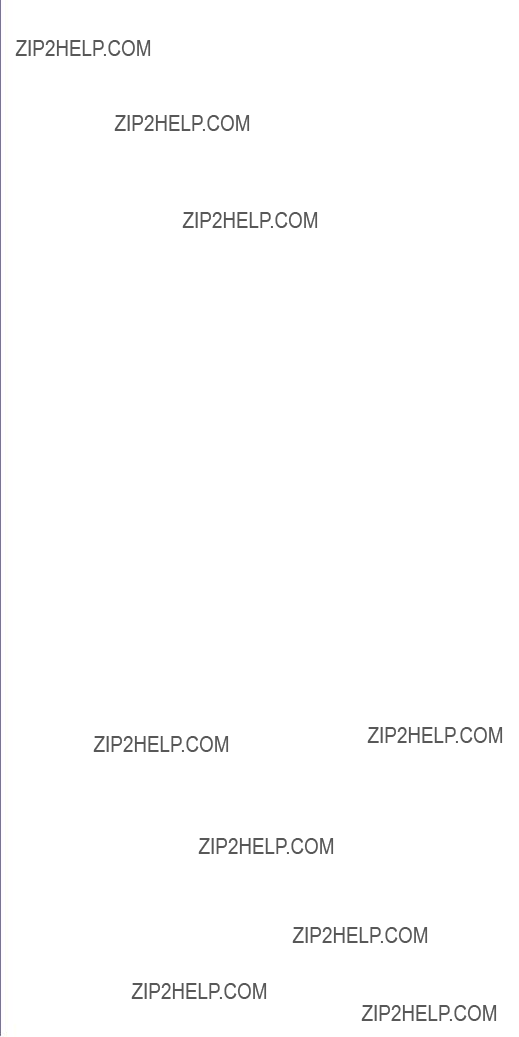
9.Press the left/right arrow until the file format you want appears and press
OK or Start.
The machine begins scanning and then sends the email.
10.If the machine asks if you want to log off your account, press the left/ right arrow to select Yes or No and press OK.
11.Press Stop/Clear to return to ready mode.
Scanning to an FTP server
You can scan an image and then upload it to an FTP server. You need to set up parameters for access to FTP servers from SyncThru??? Web Service. See page 46.
Before scanning, you can set the scan options for your scan job. See page 47.
1.Make sure that your machine is connected to a network.
2.Load originals face up into the DADF (or ADF) or place a single original on the scanner glass.
For details about loading an original, see page 32.
3.Press Scan/Email.
4.Press the left/right arrow until Scan to FTP appears on the bottom line of the display and press OK.
5.Enter the user ID and press OK.
6.Enter the password and press OK.
7.Press the left/right arrow until the FTP server you want appears and press OK or Start.
8.Press the left/right arrow until the file type you want appears and press
OK or Start.
The machine begins scanning and then sends the file to the specified server.
Scanning to an SMB server
You can scan an image and then send it to an SMB server. You need to set up parameters for access to SMB servers from SyncThru??? Web Service. See page 46.
Before scanning, you can set the scan options for your scan job. See page 47.
1.Make sure that your machine is connected to a network.
2.Load originals face up into the DADF (or ADF) or place a single original on the scanner glass.
For details about loading an original, see page 32.
3.Press Scan/Email.
4.Press the left/right arrow until Scan to SMB appears on the bottom line of the display and press OK.
5.Enter the user ID and press OK.
6.Enter the password and press OK.
7.Press the left/right arrow until the SMB server you want appears and press OK or Start.
8.Press the left/right arrow until the file format you want appears and press
OK or Start.
The machine begins scanning and then sends the file to the specified server.
CHANGING THE SETTINGS FOR EACH SCAN JOB
Your machine provides you with the following setting options to allow you to customize your scan jobs.
???Scan Size: Sets the image size.
???Original Type: Sets the original document???s type.
???Resolution: Sets the image resolution.
???Scan Color: Sets the color mode.
???Scan Format: Sets the file format in which the image is to be saved. If you select TIFF or PDF, you can select to scan multiple pages.
Depending on the selected scan type, this option may not appear. To customize the settings before starting a scan job:
1.Press Scan/Email.
2.Press Menu ( ) until Scan Feature appears on the bottom line of the display and press OK.
) until Scan Feature appears on the bottom line of the display and press OK.
3.Press the left/right arrow until the scan type you want appears and press
OK.
4.Press the left/right arrow until the scan setting option you want appears and press OK.
5.Press the left/right arrow until the desired status appears and press OK.
6.Repeat steps 4 and 5 to set other setting options.
7.When you have finished, press Stop/Clear to return to ready mode.
CHANGING THE DEFAULT SCAN SETTINGS
To avoid having to customize the scan settings for each job, you can set up default scan settings for each scan type.
1.Press Scan/Email.
2.Press Menu ( ) until Scan Setup appears on the bottom line of the display and press OK.
) until Scan Setup appears on the bottom line of the display and press OK.
3.Press OK when Change Default appears.
4.Press the left/right arrow until the scan type you want appears and press OK.
5.Press the left/right arrow until the scan setting option you want appears and press OK.
6.Press the left/right arrow until the desired status appears and press OK.
7.Repeat steps 5 and 6 to change other settings.
8.To change the default settings for other scan types, press Back ( ) and repeat from step 4.
) and repeat from step 4.
9.Press Stop/Clear to return to ready mode.
PRINTING SCAN CONFIRMATION REPORT
AUTOMATICALLY
You can set your machine to print a confirmation report showing whether a transmission was successful, how many pages were sent, and more. The report shows the job of scanning and sending it via SMB and FTP.
1.Press Scan/Email.
2.Press Menu ( ) until Scan Setup appears on the bottom line of the display and press OK.
) until Scan Setup appears on the bottom line of the display and press OK.
3.Press OK when Send Report appears.
4.Press the left/right arrow until the scan setting option you want appears and press OK.
???
???On: The report is printed whether a job successfully completed or failed.
???Off: No report is printed after completing a job.
Scanning_ 47

5. Press Stop/Clear to return to ready mode.
SETTING UP ADDRESS BOOK
You can set up Address Book with the email addresses you use frequently via SyncThru??? Web Service and then easily and quickly enter email addresses by entering the location numbers assigned to them in Address Book.
Registering speed email numbers
1.Enter your machine???s IP address as the URL in a browser and click Go to access the web site of your machine.
2.Click Machine Settings and
3.Click Individual Address Book and Add.
4.Select a location number and enter the user name and
5.Click Apply.
You can also click Import and obtain your address book from your computer.
Configuring group email numbers
Enter your machine???s IP address as the URL in a browser and click Go to access the web site of your machine.
1.Click Machine Settings and
2.Click Group Address Book and Add.
3.Select a group number and enter the group name you want.
4.Select speed email numbers that will be included in the group.
5.Click Apply.
Retrieving global email addresses from the LDAP server
You can use not only local addresses stored in your machine's memory but also ones in the LDAP server. To use the global addresses, configure the LDAP server first via SyncThru??? Web Service as following:
1.Enter your machine???s IP address as the URL in a browser and click Go to access the web site of your machine.
2.Click Machine Settings, LDAP Server Setup.
3.Select IP Address or Host Name.
4.Enter the IP address in dotted decimal notation or as a host name.
5.Enter the server port number, from 1 to 65535. The default port number is 389.
6.Enter Search Root Directory. The top search level of the LDAP directory tree
7.Select Authentication method. Method of LDAP server login.
Anonymous: This is used to bind with NULL password and login ID (Password and login ID are grayed in SWS).
Simple: This is used to bind with the login ID and password in SWS.
8.Put a check mark of Append Root to Base DN for adding Base DN to login name.
9.Enter your login name, password, maximum number of search results and search timeout.
LDAP Referral: LDAP client will search referral server in case LDAP server has no data to reply of query and LDAP server has any referral server.
10.Select Serach Name Order that you want.
11.Put a check mark of "From:" Field Security Options.
12. Click Add.
Using Address Book entries
To retrieve an email address, use the following ways:
Speed email numbers
When you are prompted to enter a destination address while sending an email, enter the speed email number at which you stored the address you want.
???For a
???For a two- or
If you are an
You can also search through memory for an entry by pressing Address Book. See page 48.
Group email numbers
To use a group email entry, you need to search for and select it from memory.
When you are prompted to enter a destination address while sending an email, press Address Book. See page 48
Global email addresses
To use a global email addresses in the LDAP server, you need to search for and select it from memory.
When you are prompted to enter a destination address while sending an email, press Address Book. See page 48.
Searching Address Book for an entry
There are two ways to search for an address in memory. You can either scan from A to Z sequentially or search by entering the first letters of the name associated with the address.
Searching sequentially through memory
1.If necessary, press Scan/Email.
2.Press Address Book until Search & Send appears on the bottom line of the display and press OK.
3.Press the left/right arrow until the number category you want appears and press OK.
4.Press OK when All appears.
5.Press the left/right arrow until the name and address you want appears. You can search upwards or downwards through the entire memory in alphabetical order.
Searching with a particular first letter
1.If necessary, press Scan/Email.
2.Press Address Book until Search & Send appears on the bottom line of the display and press OK.
3.Press the left/right arrow until the number category you want appears and press OK.
4.Press the left/right arrow until ID appears and press OK.
5.Enter the first few letters of the name you want and press OK.
6.Press the left/right arrow until the name you want appears and press
OK.
48 _Scanning
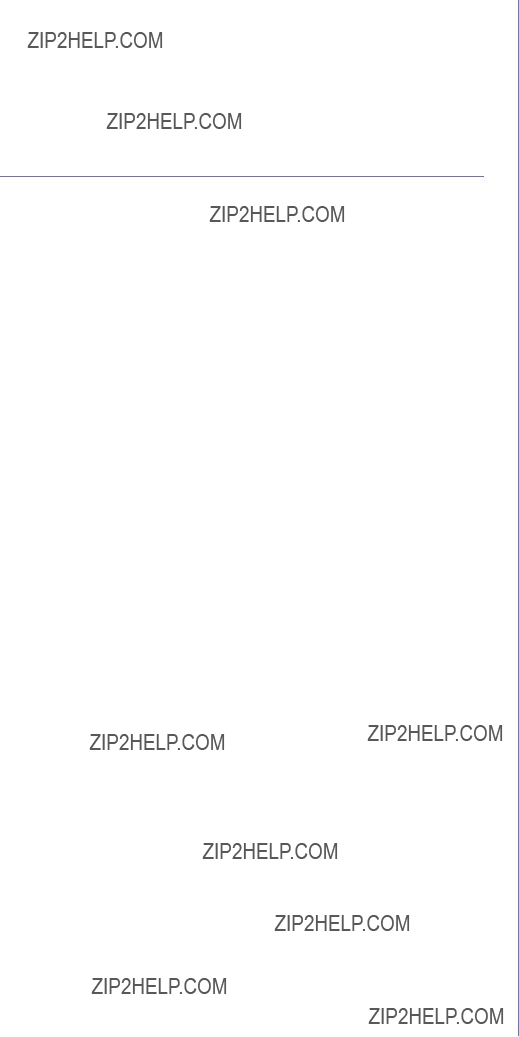
Printing Address Book
You can check your Address Book settings by printing a list.
1.Press Address Book until Print appears on the bottom line of the display.
2.Press OK.
A list showing your speed button settings, and the speed/group email entries print out.
SCAN ON BOTH SIDES OF PAPER
By using the Duplex button on your machine, you can set the machine to scan on both sides of paper.
1.Press Duplex.
2.Press the left/right arrow until the binding option you want appears.
???Off: Scans in Normal mode.
???2 Side: Scans both sides of the original.
???2
3.Press OK to save your selection.
If the mode is enabled, the Duplex button is backlit.
Scanning_ 49

basic printing
This chapter explains common printing tasks.
PRINTING A DOCUMENT
Your machine allows you to print from various Windows, Macintosh, or Linux applications. The exact steps for printing a document may vary depending on the application you use.
For details about printing, see the Software section.
CANCELING A PRINT JOB
If the print job is waiting in a print queue or print spooler, such as the printer group in Windows, delete the job as follows:
1. Click the Windows Start menu.
2. For Windows 2000, select Settings and then Printers. For Windows XP/2003, select Printers and Faxes.
For Windows Vista, select Control Panel > Hardware and Sound >
Printers.
3.
4. From the Document menu, select Cancel.
You can also access this window by simply
You can also cancel the current job by pressing Stop/Clear on the control panel.
50 _Basic printing

faxing
The fax feature is available only on the
This chapter includes:
You cannot use this machine as a fax machine via the internet phone.
We recommend you to use traditional analog phone services (PSTN: public switched telephone network) when connecting telephone lines to use Fax. If you use other Internet services (DSL, ISDN, VolP), you can improve the connection quality by using the
1Line port
2Micro filter
3DSL modem / Telephone line
SENDING A FAX
Setting the fax header
In some countries, you are required by law to indicate your fax number on any fax you send. The Machine ID, containing your telephone number and name or company name, will be printed at the top of each page sent from your machine.
1.Press Menu ( ) until System Setup appears on the bottom line of the display and press OK.
) until System Setup appears on the bottom line of the display and press OK.
2.Press OK when Machine Setup appears.
3.Press OK when Machine ID appears.
4.Enter your name or the company name using the number keypad. You can enter alphanumeric characters using the number keypad, and include special symbols by pressing the 0 button. For details on how to enter alphanumeric characters, see page 29.
5.Press OK to save the ID.
6.Press the left/right arrow until Machine Fax No. appears and press OK.
7.Enter your fax number using the number keypad and press OK.
8.Press Stop/Clear to return to ready mode.
Adjusting the document settings
Before starting a fax, change the following settings according to your original???s status to get the best quality.
Resolution
The default document settings produce good results when using typical
???Fax setup
quality, or contain photographs, you can adjust the resolution to produce a higher quality Fax.
1.Press Resolution.
2.Press Resolution or the left/right arrow until the option you want appears.
3.Press OK to save your selection.
Recommended resolution settings for different original document types are described in the table below:
The resolution setting is applied to the current fax job. To change the default setting, see page 57.
Darkness
You can select the default contrast mode to fax your originals lighter or darker.
1.Press Fax.
2.Press Menu ( ) , and then OK when Fax Feature appears on the bottom line of the display.
) , and then OK when Fax Feature appears on the bottom line of the display.
3.Press OK when Darkness appears.
4.Press the left/right arrow until the option you want appears and press
OK.
5.Press Stop/Clear to return to ready mode.
The darkness setting is applied to the current fax job. To change the default setting, see page 57.
Faxing_ 51

Sending a fax automatically
1.Press Fax.
2.Load originals face up into the DADF (or ADF), or place a single original face down on the scanner glass.
For details about loading an original, see page 32. Ready to Fax appears on the top line of the display.
3.Adjust the resolution and the darkness to suit your fax needs.
4.Enter the receiving fax machine???s number.
You can use speed buttons, speed dial numbers, or group dial numbers. For details about storing and searching for a number, see page 57.
5.Press Color Start or Black Start.
6.If an original is placed on the scanner glass, select Yes to add another page. Load another original and press OK.
7.When you have finished, select No at the Another Page? prompt. After the number is dialed, the machine begins sending the fax when the receiving fax machine answers.
When you want to cancel a fax job, press Stop/Clear at any time while sending.
Sending a fax manually
1.Press Fax.
2.Load originals face up into the DADF (or ADF), or place a single original face down on the scanner glass.
For details about loading an original, see page 32.
3.Adjust the resolution and the darkness to suit your fax needs. See page 51.
4.Press On Hook Dial. You hear a dial tone.
5.Enter the receiving fax machine???s number.
You can use speed buttons, speed dial numbers, or group dial numbers. For details about storing and searching for a number, see page 57.
6.Press Color Start or Black Start when you hear a
When you want to cancel a fax job, press Stop/Clear at any time while sending.
Confirming a transmission
When the last page of your original has been sent successfully, the machine beeps and returns to ready mode.
When something goes wrong while sending your fax, an error message appears on the display. For a list of error messages and their meanings, see page 78. If you receive an error message, press Stop/Clear to clear the message and try to send the fax again.
You can set your machine to print a confirmation report automatically each time sending a fax is completed. For further details, see page 56.
Automatic redialing
When the number you have dialed is busy or there is no answer when you send a fax, the machine automatically redials the number every three minutes, up to seven times according to the factory default settings.
When the display shows Retry Redial?, press OK to redial the number without waiting. To cancel the automatic redialing, press Stop/Clear.
To change the time interval between redials and the number of redial attempts. See page 56.
Redialing the last number
To redial the number you called last:
1.Press Redial/Pause.
2.When an original is loaded in the DADF (or ADF), the machine automatically begins to send.
If an original is placed on the scanner glass, select Yes to add another page. Load another original and press OK. When you have finished, select No at the Another Page? prompt.
Sending faxes on both sides of paper
You can set the machine to send faxes on both sides of paper. (CLX- 6210FX,
1.Press Fax.
2.Press Duplex.
3.Press the left/right arrow until the binding option you want appears.
???Off: Send faxes in Normal mode.
???2 Side: Send faxes on both sides of the original.
???2
4.Press OK to save your selection.
If the mode is enabled, the Duplex button is backlit.
RECEIVING A FAX
Selecting the paper tray
After loading the print media for fax output, you have to select the paper tray you will use for the fax reception.
1.Press Menu ( ) until System Setup appears on the bottom line of the display and press OK.
) until System Setup appears on the bottom line of the display and press OK.
2.Press the left/right arrow until Paper Setup appears and press OK.
3.Press the left/right arrow until Paper Source appears and press OK.
4.Press the left/right arrow until Fax Tray appears and press OK.
5.Press the left/right arrow until the paper tray you want appears and press OK.
6.Press Stop/Clear to return to ready mode.
Changing receiving modes
1.Press Fax.
2.Press Menu ( ) until Fax Setup appears on the bottom line of the display and press OK.
) until Fax Setup appears on the bottom line of the display and press OK.
3.Press the left/right arrow until Receiving appears and press OK.
4.Press OK when Receive Mode appears.
5.Press the left/right arrow until the fax reception mode you want appears.
???In Fax mode, the machine answers an incoming fax call and immediately goes into the fax reception mode.
???In Tel mode, you can receive a fax by pressing On Hook Dial and then Color Start or Black Start. You can also pick up the handset of the extension phone and then press the remote receive code. See page 53.
???In Ans/Fax mode, an answering machine attached to your machine answers an incoming call, and the caller can leave a message on the answering machine. If the fax machine senses a fax tone on the line, the machine automatically switches to Fax mode to receive the fax. See page 53.
???In DRPD mode, you can receive a call using the Distinctive Ring
52 _Faxing
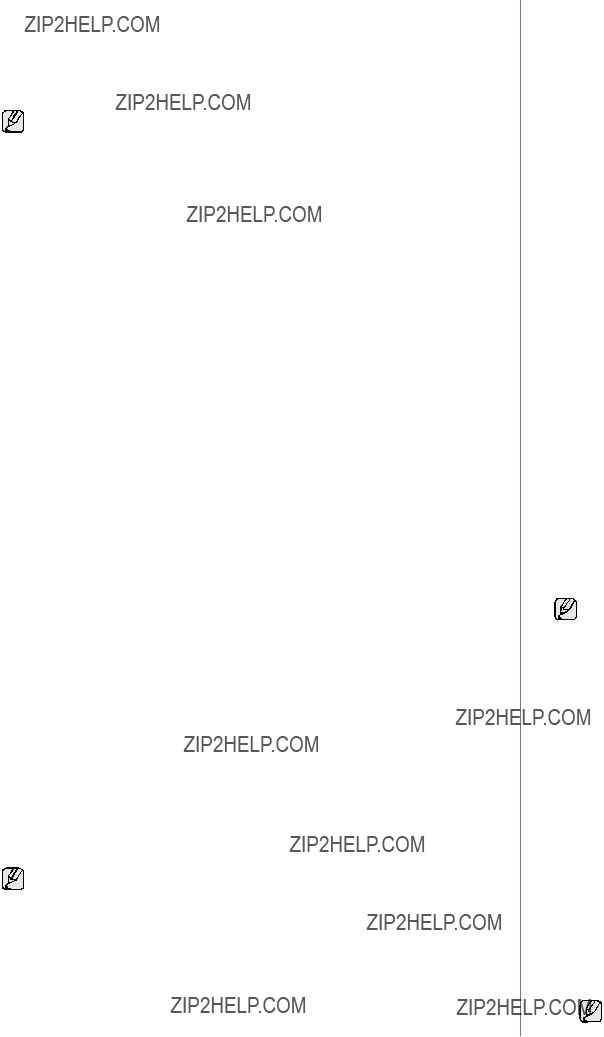
Pattern Detection (DRPD) feature. Distinctive Ring is a telephone company service which enables an user to use a single telephone line to answer several different telephone numbers. For further details, see page 53.
6.Press OK to save your selection.
7.Press Stop/Clear to return to ready mode.
??? When the memory is full, the printer can no longer receive any incoming fax. Secure free memory to resume by removing data stored in the memory.
???To use the Ans/Fax mode, attach an answering machine to the EXT socket on the back of your machine.
???If you do not want other people to view your received documents, you can use secure receiving mode. In this mode, all of the received faxes are stored in memory. For further details, see page 53.
Receiving automatically in Fax mode
Your machine is preset to Fax mode at the factory. When you receive a fax, the machine answers the call on a specified number of rings and automatically receives the fax.
To change the number of rings, see page 56.
Receiving manually in Tel mode
You can receive a fax call by pressing On Hook Dial and then pressing Black Start or Color Start when you hear a fax tone from the remote machine.
The machine begins receiving a fax and returns to ready mode when the reception is completed.
Receiving manually using an extension telephone
This features works best when you are using an extension telephone connected to the EXT socket on the back of your machine. You can receive a fax from someone you are talking to on the extension telephone without going to the fax machine.
When you receive a call on the extension phone and hear fax tones, press the keys *9* on the extension phone. The machine receives the fax.
Press the buttons slowly in sequence. If you still hear the fax tone from the remote machine, try pressing *9* once again.
*9* is the remote receive code preset at the factory. The first and the last asterisks are fixed, but you can change the middle number to whatever you wish. For details about changing the code, see page 56.
Receiving automatically in Ans/Fax mode
To use this mode, you must attach an answering machine to the EXT socket on the back of your machine.
If the caller leaves a message, the answering machine stores the message as it would normally. If your machine detects a fax tone on the line, it automatically starts to receive the fax.
??? If you have set your machine to Ans/Fax mode and your answering machine is switched off, or no answering machine is connected to EXT socket, your machine automatically goes into Fax mode after a predefined number of rings.
???If your answering machine has a
???If you are in Tel mode (manual reception) when the answering machine is connected to your machine, you must switch off the answering machine, or the outgoing message from the answering machine will interrupt your phone conversation.
Receiving faxes using DRPD mode
Distinctive Ring is a telephone company service which enables an user to use a single telephone line to answer several different telephone numbers. The particular number someone uses to call you is identified by different ringing patterns, which consist of various combinations of long and short ringing sounds. This feature is often used by answering services who answer telephones for many different clients and need to know which number someone is calling in on to properly answer the phone.
Using the Distinctive Ring Pattern Detection (DRPD) feature, your fax machine can learn the ring pattern you designate to be answered by the fax machine. Unless you change it, this ringing pattern will continue to be recognized and answered as a fax call, and all other ringing patterns will be forwarded to the extension telephone or answering machine plugged into the EXT socket. You can easily suspend or change DRPD at any time.
Before using the DRPD option, Distinctive Ring service must be installed on your telephone line by the telephone company. To set up DRPD, you will need another telephone line at your location, or someone available to dial your fax number from outside.
To set up the DRPD mode:
1.Press Fax.
2.Press Menu ( ) until Fax Setup appears on the bottom line of the display and press OK.
) until Fax Setup appears on the bottom line of the display and press OK.
3.Press the left/right arrow until Receiving appears and press OK.
4.Press the left/right arrow until DRPD Mode appears and press OK. Waiting Ring appears on the display.
5.Call your fax number from another telephone. It is not necessary to place the call from a fax machine.
6.When your machine begins to ring, do not answer the call. The machine requires several rings to learn the pattern.
When the machine completes learning, the display shows Completed DRPD Setup. If the DRPD setup fails, Error DRPD Ring appears. Press OK when DRPD Mode appears and start over from step 4.
7.Press Stop/Clear to return to ready mode.
??? DRPD must be set up again if you
???After DRPD has been set up, call your fax number again to verify that the machine answers with a fax tone. Then have a call placed to a different number assigned to that same line to be sure the call is forwarded to the extension telephone or answering machine plugged into the EXT socket.
Receiving in secure receiving mode
You may need to prevent your received faxes from being accessed by unauthorized people. You can turn on secure receiving mode to restrict printing of received faxes when the machine is unattended. In secure receiving mode, all incoming faxes go into memory. When the mode is deactivated, any stored faxes are printed.
Activating secure receiving mode
1.Press Fax.
2.Press Menu ( ) and then press OK when Fax Feature appears on the bottom line of the display.
) and then press OK when Fax Feature appears on the bottom line of the display.
3.Press the left/right arrow until Secure Receive appears and press OK.
4.Press the left/right arrow until On appears and press OK.
5.Enter a
You can activate secure receiving mode without setting a password, but cannot protect your faxes.
Faxing_ 53
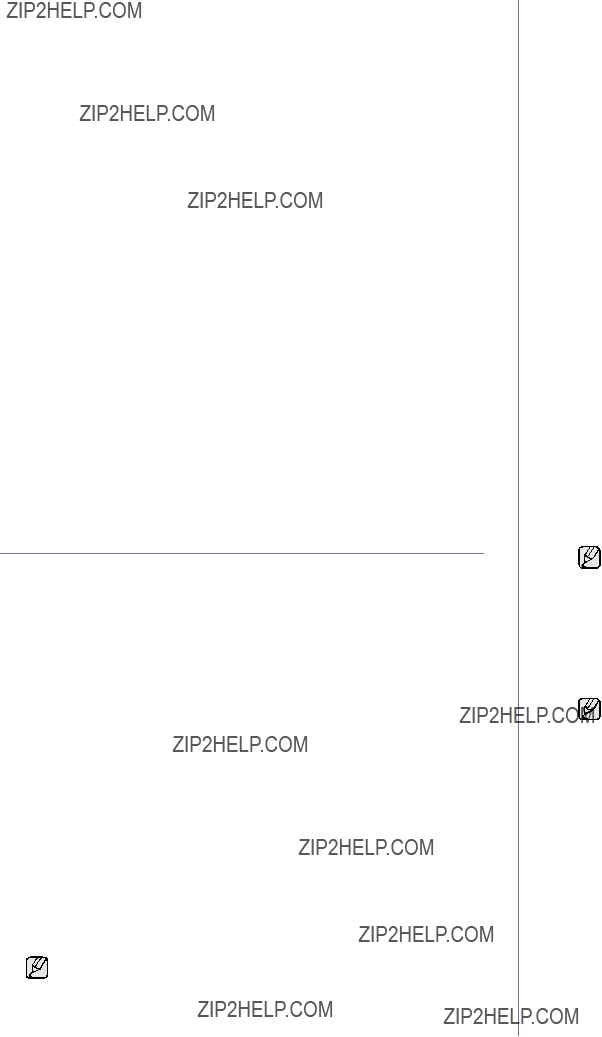
6.
7.Press Stop/Clear to return to ready mode.
When a fax is received in secure receiving mode, your machine stores it in memory and shows Secure Receive to let you know that there is a fax received.
Printing received faxes
1.Access the Secure Receive menu by following steps 1 through 3 in ???Activating secure receiving mode.???
2.Press the left/right arrow until Print appears and press OK.
3.Enter the
The machine prints all of the faxes stored in memory.
Deactivating secure receiving mode
1.Access the Secure Receive menu by following steps 1 through 3 in ???Activating secure receiving mode.???
2.Press the left/right arrow until Off appears and press OK.
3.Enter the
The mode is deactivated and the machine prints all faxes stored in memory.
4.Press Stop/Clear to return to ready mode.
Receiving faxes in memory
Since your machine is a
Also, your machine receives faxes and stores them in its memory when there is no paper in the tray or no toner in the installed toner cartridge.
OTHER WAYS TO FAX
Sending a fax to multiple destinations
You can use the Multiple Send feature, which allows you to send a fax to multiple locations. Originals are automatically stored in memory and sent to a remote station. After transmission, the originals are automatically erased from memory. You cannot send a color fax using this feature.
1.Press Fax.
2.Load originals face up into the DADF (or ADF), or place a single original face down on the scanner glass.
For details about loading an original, see page 32.
3.Adjust the document resolution and darkness to suit your fax needs. See page 51.
4.Press Menu ( ) until Fax Feature appears on the bottom line of the display and press OK.
) until Fax Feature appears on the bottom line of the display and press OK.
5.Press the left/right arrow until Multi Send appears and press OK.
6.Enter the number of the first receiving fax machine and press OK.
You can use speed buttons, speed dial numbers. You can enter Group Dial Number using Address Book Button. For details, see page 57.
7.Enter the second fax number and press OK.
The display asks you to enter another fax number to send the document.
8.To enter more fax numbers, press OK when Yes appears and repeat steps 6 and 7. You can add up to 10 destinations.
Once you entered a group dial number, you cannot enter another group dial numbers anymore.
9.When you have finished entering fax numbers, press the left/right arrow to select No at the Another No.? prompt and press OK.
The original is scanned into memory before transmission. The display shows memory capacity and the number of pages being stored in memory.
10.If an original is placed on the scanner glass, select Yes to add another pages. Load another original and press OK.
When you have finished, select No at the Another Page? prompt. The machine begins sending the fax to the numbers you entered in the order in which you entered them.
Sending a delayed fax
You can set your machine to send a fax at a later time when you will not be present. You cannot send a color fax using this feature.
1.Press Fax.
2.Load originals face up into the DADF (or ADF), or place a single original face down on the scanner glass.
For details about loading an original, see page 32.
3.Adjust the document resolution and darkness to suit your fax needs. See page 51.
4.Press Menu ( ) until Fax Feature appears on the bottom line of the display and press OK.
) until Fax Feature appears on the bottom line of the display and press OK.
5.Press the left/right arrow until Delay Send appears and press OK.
6.Enter the number of the receiving machine using the number keypad.
You can use speed buttons, speed dial numbers. You can enter Group Dial Number using Address Book Button.For details, see page 57.
7.Press OK to confirm the number. The display asks you to enter another fax number to which to send the document.
8.To enter more fax numbers, press OK when Yes appears and repeat steps 6 and 7. You can add up to 10 destinations.
Once you entered a group dial number, you cannot enter another group dial numbers anymore.
9.When you have finished entering fax numbers, press the left/right arrow to select No at the Another No.? prompt and press OK.
10.Enter the job name you want and press OK.
For details on how to enter alphanumeric characters, see page 29. If you do not want to assign a name, skip this step.
11.Enter the time using the number keypad and press OK, or Black Start.
If you set a time earlier than the current time, the fax will be sent at that time on the following day.
The original is scanned into memory before transmission. The display shows memory capacity and the number of pages being stored in memory.
12.If an original is placed on the scanner glass, select Yes to add another page. Load another original and press OK.
When you have finished, select No at the Another Page? prompt. The machine returns to ready mode. The display reminds you that you are in ready mode and that a delayed fax is set.
Adding pages to a delayed fax
You can add pages to the delayed transmissions previously reserved in your machine???s memory.
1.Load the originals to be added and adjust document settings.
2.Press Menu ( ) until Fax Feature appears on the bottom line of the display and press OK.
) until Fax Feature appears on the bottom line of the display and press OK.
3.Press OK when Add Page appears.
54 _Faxing

4.Press the left/right arrow until the fax job you want appears and press OK.
The machine scans the original into memory and shows the total number of pages and the number of the added pages.
Canceling a delayed fax
1.Press Menu ( ) until Fax Feature appears on the bottom line of the display and press OK.
) until Fax Feature appears on the bottom line of the display and press OK.
2.Press the left/right arrow until Cancel Job appears and press OK.
3.Press the left/right arrow until the fax job you want appears and press OK.
4.Press OK when Yes appears.
The selected fax is deleted from memory.
Sending a priority fax
Using the Priority Fax feature, a high priority fax can be sent ahead of reserved operations. The original is scanned into memory and immediately transmitted when the current operation is finished. In addition, priority transmission will interrupt a Multiple Send operation between stations (i.e., when the transmission to station A ends, before transmission to station B begins) or between redial attempts.
1.Press Fax.
2.Load originals face up into the DADF (or ADF), or place a single original face down on the scanner glass.
For details about loading an original, see page 32.
3.Adjust the document resolution and darkness to suit your fax needs. See page 51.
4.Press Menu ( ) until Fax Feature appears on the bottom line of the display and press OK.
) until Fax Feature appears on the bottom line of the display and press OK.
5.Press the left/right arrow until Priority Send appears and press OK.
6.Enter the number of the receiving machine.
You can use speed buttons, speed dial numbers, or group dial numbers. For details, see page 57.
7.Press OK to confirm the number.
8.Enter the job name you want and press OK.
The original is scanned into memory before transmission. The display shows memory capacity and the number of pages being stored in memory.
9.If an original is placed on the scanner glass, select Yes to add another page. Load another original and press OK.
When you have finished, select No at the Another Page? prompt. The machine shows the number being dialed and begins sending the fax.
Forwarding faxes
You can forward your incoming and outgoing faxes to another fax machine or email address.
Forwarding sent faxes to another fax machine
You can set the machine to send copies of all outgoing faxes to a specified destination, in addition to the fax numbers you entered.
1.Press Fax.
2.Press Menu ( ) until Fax Feature appears on the bottom line of the display and press OK.
) until Fax Feature appears on the bottom line of the display and press OK.
3.Press the left/right arrow until Forward appears and press OK.
4.Press OK when Fax appears.
5.Press the left/right arrow until Send Forward appears and press OK.
6.Press the left/right arrow to select On and press OK.
7.Enter the number of the fax machine to which faxes are to be sent and press OK.
8.Press Stop/Clear to return to ready mode.
Subsequent sent faxes will be forwarded to the specified fax machine.
Forwarding sent faxes to email address
You can set the machine to send copies of all outgoing faxes to a specified destination, in addition to the email address you entered.
1.Press Fax.
2.Press Menu ( ) until Fax Feature appears on the bottom line of the display and press OK.
) until Fax Feature appears on the bottom line of the display and press OK.
3.Press the left/right arrow until Forward appears and press OK.
4.Press the left/right arrow until
5.Press the left/right arrow until Send Forward appears and press OK.
6.Press the left/right arrow to select On and press OK.
7.Enter your email address and press OK.
8.Enter the email address to which faxes are to be sent and press OK.
9.Press Stop/Clear to return to ready mode.
Subsequent sent faxes will be forwarded to the specified email address.
Forwarding received faxes to another fax machine
You can set your machine to forward incoming faxes to another fax number during a specified time period. When a fax arrives at your machine, it is stored in memory. Then, the machine dials the fax number that you have specified and sends the fax.
1.Press Fax.
2.Press Menu ( ) until Fax Feature appears on the bottom line of the display and press OK.
) until Fax Feature appears on the bottom line of the display and press OK.
3.Press the left/right arrow until Forward appears and press OK.
4.Press OK when Fax appears.
5.Press the left/right arrow until Rcv. Forward appears and press OK.
6.Press the left/right arrow until Forward appears and press OK.
To set the machine to print out a fax when fax forwarding has been completed, select Forward&Print.
7.Enter the number of the fax machine to which faxes are to be sent and press OK.
8.Enter the starting time and press OK.
9.Enter the ending time and press OK.
10.Press Stop/Clear to return to ready mode.
Subsequent received faxes will be forwarded to the specified fax machine.
Forwarding received faxes to email address
You can set your machine to forward incoming faxes to the email address you entered.
1.Press Fax.
2.Press Menu ( ) until Fax Feature appears on the bottom line of the display and press OK.
) until Fax Feature appears on the bottom line of the display and press OK.
3.Press the left/right arrow until Forward appears and press OK.
4.Press the left/right arrow until
5.Press the left/right arrow until Rcv. Forward appears and press OK.
6.Press the left/right arrow until Forward appears and press OK.
To set the machine to print out a fax when fax forwarding has been completed, select Forward&Print.
7.Enter your email address and press OK.
8.Enter the email address to which faxes are to be sent and press OK.
Faxing_ 55

9.Press Stop/Clear to return to ready mode.
Subsequent sent faxes will be forwarded to the specified email address.
FAX SETUP
Changing the fax setup options
Your machine provides you with various
To change the fax setup options:
1.Press Fax.
2.Press Menu ( ) until Fax Setup appears on the bottom line of the display and press OK.
) until Fax Setup appears on the bottom line of the display and press OK.
3.Press the left/right arrow to select Sending or Receiving and press OK.
4.Press the left/right arrow until the menu item you want appears and press OK.
5.Press the left/right arrow until the desired status appears or enter the value for the option you have selected, and press OK.
6.If necessary, repeat steps 4 through 5.
7.Press Stop/Clear to return to ready mode.
Sending options
Receiving options
Receive Mode You can select the default fax receiving mode. For details on receiving faxes in each mode, see page 52.
Ring to Answer You can specify the number of times the machine rings before answering an incoming call.
Stamp RCV This option allows the machine to automatically
Nameprint the page number, and the date and time of reception at the bottom of each page of a
received fax.
Rcv Start Code This code allows you to initiate fax reception from an extension phone plugged into the EXT socket on the back of the machine. If you pick up the extension phone and hear fax tones, enter the code. It is preset to *9* at the factory.
Auto Reduction When receiving a fax containing pages as long as or longer than the paper loaded in the paper tray, the machine can reduce the size of the original to fit the size of the paper loaded in the machine.
Turn on this feature if you want to automatically reduce an incoming page.
With this feature set to Off, the machine cannot reduce the original to fit onto one page. The original will be divided and printed in actual size on two or more pages.
Discard Size When receiving a fax containing pages as long as or longer than the paper in your machine, you can set the machine to discard a specific length from the end of the received fax. The machine will print the received fax on one or more sheets of paper, minus the data that would have been on the specified discard segment.
When the received fax contains pages larger than the paper in your machine, and Auto Reduction has been turned on, the machine will reduce the fax to fit on the existing paper, and nothing will be discarded.
56 _Faxing

Changing the default document settings
The fax options, including resolution and darkness, can be set to the most frequently used modes. When you send a fax, the default settings are used if they are not changed by using the corresponding button and menu.
1.Press Fax.
2.Press Menu ( ) until Fax Setup appears on the bottom line of the display and press OK.
) until Fax Setup appears on the bottom line of the display and press OK.
3.Press the left/right arrow until Change Default appears and press OK.
4.Press OK when Resolution appears.
5.Press the left/right arrow until the resolution you want appears and press
OK.
6.Press the left/right arrow until Darkness appears and press OK.
7.Press the left/right arrow until the darkness you want appears and press
OK.
8.Press Stop/Clear to return to ready mode.
Printing sent fax report automatically
You can set the machine to print a report with detailed information about the previous 50 communication operations, including time and dates.
1.Press Fax.
2.Press Menu ( ) until Fax Setup appears on the bottom line of the display and press OK.
) until Fax Setup appears on the bottom line of the display and press OK.
3.Press the left/right arrow until Auto Report appears and press OK.
4.Press the left/right arrow until On appears and press OK.
5.Press Stop/Clear to return to ready mode.
Setting up Address Book
You can set up Address Book with the fax numbers you use most frequently. Your machine provides you with the following features for setting
up Address Book:
???Speed buttons
???Speed/Group dial numbers
Before beginning to store fax numbers, make sure that your machine is in Fax mode.
Speed buttons
The 15 speed buttons on the control panel lets you store
There are two ways to assign numbers to speed buttons. Examine the procedures below and use the appropriate way which you prefer:
Registering after pressing a speed button
1.Press Fax.
2.Press one of the speed buttons.
3.Press OK when Yes appears.
4.Enter the name you want and press OK.
For details on how to enter alphanumeric characters, see page 29.
5.Enter the fax number you want to store and press OK.
Registering after entering a number first
1.Press Fax.
2.Enter the fax number you want to store.
3.Press one of the speed buttons.
4.Press OK when Yes appears.
If you press a speed button already assigned, the display asks if you want to overwrite. Press OK to confirm Yes and continue. To start over with another speed button, select No.
5.Enter the name you want and press OK.
For details on how to enter alphanumeric characters, see page 29.
6.Press OK to confirm the number.
Using speed buttons
When you are prompted to enter a fax number while sending a fax:
???To retrieve a number from speed buttons 1 to 15, press the corresponding speed button and press OK.
???To retrieve a number from speed buttons 16 to 30, press Shift and then the corresponding speed button, and press OK.
Speed dial numbers
You can store up to 240
Registering a speed dial number
1.Press Fax.
2.Press Address Book until New & Edit appears on the bottom line of the display and press OK.
3.Press OK when Speed Dial appears.
4.Enter a speed dial number between 0 and 239 and press OK.
If an entry is already stored in the number you choose, the display shows the name to allow you to change it. To start over with another speed dial number, press Back ( ).
).
5.Enter the name you want and press OK.
For details on how to enter alphanumeric characters, see page 29.
6.Enter the fax number you want and press OK.
Faxing_ 57

7. Press Stop/Clear to return to ready mode.
Editing speed dial numbers
1.Press Address Book until New & Edit appears on the bottom line of the display and press OK.
2.Press OK when Speed Dial appears.
3.Enter the speed dial number you want to edit and press OK.
4.Change the name and press OK.
5.Change the fax number and press OK.
6.Press Stop/Clear to return to ready mode.
Using speed dial numbers
When you are prompted to enter a destination number while sending a fax, enter the speed dial number at which you stored the number you want.
???For a
???For a two- or
You can also search through memory for an entry by pressing Address Book. See page 58.
Group dial numbers
If you frequently send the same document to several destinations, you can group these destinations and set them under a group dial number. You can then use a group dial number to send a document to all of the destinations within the group. You can set up to 200 (0 through 199) group dial numbers using the destination???s existing speed dial numbers.
Registering a group dial number
1.Press Fax.
2.Press Address Book until New & Edit appears on the bottom line of the display and press OK.
3.Press the left/right arrow until Group Dial appears and press OK.
4.Enter a group dial number between 0 and 199 and press OK.
5.Enter a speed dial number and press OK.
6.Press OK when speed dial information appears correctly.
7.Press OK when Yes appears.
8.Repeat steps 5 and 6 to include other speed dial numbers into the group.
9.When you have finished, press the left/right arrow to select No at the Another No.? prompt and press OK.
10.Press Stop/Clear to return to ready mode.
Editing a group dial number
You can delete a specific entry from a group or add a new number to the selected group.
1.Press Address Book until New & Edit appears on the bottom line of the display and press OK.
2.Press the left/right arrow until Group Dial appears and press OK.
3.Enter the group dial number you want to edit and press OK.
4.Enter the speed dial number you want to add or delete and press
OK.
If you entered a new speed dial number, Add? appears.
If you enter a speed dial number stored in the group, Delete? appears.
5.Press OK to add or delete the number.
6.Press OK when Yes appears to add or delete more numbers and repeat steps 4 and 5.
7.When you have finished, press the left/right arrow to select No at the Another No.? prompt and press OK.
8. Press Stop/Clear to return to ready mode.
Using group dial numbers
To use a group dial entry, you need to search for and select it from memory.
When you are prompted to enter a fax number while sending a fax, press Address Book. See below.
Searching Address Book for an entry
There are two ways to search for a number in memory. You can either scan from A to Z sequentially, or you can search by entering the first letters of the name associated with the number.
Searching sequentially through the memory
1.If necessary, press Fax.
2.Press Address Book until Search & Dial appears on the bottom line of the display and press OK.
3.Press the left/right arrow until the number category you want appears and press OK.
4.Press OK when All appears.
5.Press the left/right arrow until the name and number you want appears. You can search upwards or downwards through the entire memory in alphabetical order.
Searching with a particular first letter
1.If necessary, press Fax.
2.Press Address Book until Search & Dial appears on the bottom line of the display and press OK.
3.Press the left/right arrow until the number category you want appears and press OK.
4.Press the left/right arrow until ID appears and press OK.
5.Enter the first few letters of the name you want and press OK.
6.Press the left/right arrow until the name you want appears and press
OK.
Deleting a Address Book entry
You can delete entries in Address Book one by one.
1.Press Address Book until Delete appears on the bottom line of the display and press OK.
2.Press the left/right arrow until the number category you want appears and press OK.
3.Press the left/right arrow until the searching method you want appears and press OK.
Select Search All to search for an entry by scanning through all entries in Address Book.
Select Search ID to search for an entry by the first few letters of the name.
4.Press the left/right arrow until the name you want appears and press
OK.
Or, enter the first letters and press OK. Press the left/right arrow until the name you want appears and press OK.
5.Press OK.
6.Press OK when Yes appears to confirm the deletion.
7.Press Stop/Clear to return to ready mode.
Printing Address Book
1. You can check your Address Book settings by printing a list.
1.Press Address Book until Print appears on the bottom line of the display.
2.Press OK. A list showing your speed button settings, and speed dial and group dial entries prints out.
58 _Faxing

using USB flash memory
This chapter explains how to use a USB memory device with your machine.
This chapter includes:
???Plugging in a USB memory device
???Scanning to a USB memory device
ABOUT USB MEMORY
USB memory devices are available with a variety of memory capacities to give you more room for storing documents, presentations, downloaded music and videos, high resolution photographs, or whatever other files you want to store or move.
You can do the following on your machine using a USB memory device:
???Scan documents and save them on a USB memory device.
???Print data stored on a USB memory device.
???Back up Address Book/ Phone Book entries and the system settings of your machine.
???Restore backup files to the machine???s memory.
???Format the USB memory device.
???Check the available memory space.
PLUGGING IN A USB MEMORY DEVICE
The USB memory port on the front of your machine is designed for USB V1.1 and USB V2.0 memory devices. Your machine supports USB memory devices with FAT16/FAT32 and sector size of 512 bytes.
Check your USB memory device???s file system from your dealer.
You must use only an authorized USB memory device with an A plug type connector.
Use only a metal/shielded USB memory device.
???Printing from a USB memory device
Insert a USB memory device into the USB memory port on the front of your machine.
???Do not remove the USB memory device while the machine is in operation, or writing to or reading from USB memory. The machine warranty does not cover damage caused by use???s misuse.
???If your USB memory device has certain features, such as security settings and password settings, your machine may not automatically detect it. For details about these features, see the device???s User???s Guide.
SCANNING TO A USB MEMORY DEVICE
You can scan a document and save the scanned image onto a USB memory device. There are two ways of doing this: you can scan to the device using the default settings, or you can customize your own scan settings.
Scanning
1.Insert a USB memory device into the USB memory port on your machine.
2.Load originals face up into the DADF (or ADF), or place a single original face down on the scanner glass.
For details about loading an original, see page 32.
3.Press Scan/Email.
4.Press OK when Scan to USB appears on the bottom line of the display.
5.Press OK, Color Start or Black Start when USB appears.
Regardless of the button you press, the color mode is decided as customized. See ???Customizing Scan to USB??? on page 60.
Your machine begins scanning the original, and then asks if you want to scan another page.
Using USB flash memory_ 59
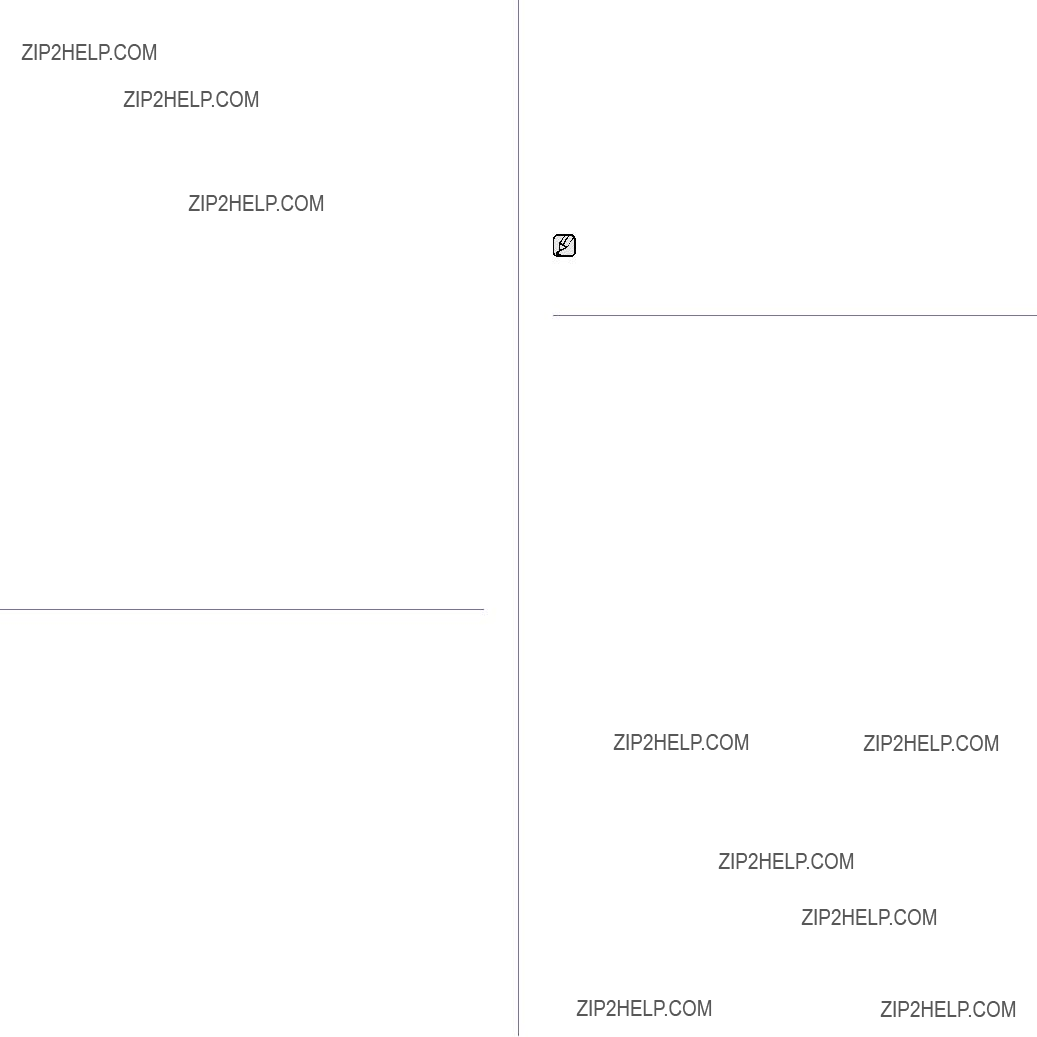
6.Press OK when Yes appears to scan more pages. Load an original and press Color Start or Black Start.
Regardless of the button you press, the color mode is decided as customized. See ???Customizing Scan to USB??? on page 60. Otherwise, press the left/right arrow to select No and press OK.
After scanning is complete, you can remove the USB memory device from the machine.
Customizing Scan to USB
You can specify image size, file format, or color mode for each scanning to USB job.
1.Press Scan/Email.
2.Press Menu ( ) until Scan Feature appears on the bottom line of the display and press OK.
) until Scan Feature appears on the bottom line of the display and press OK.
3.Press OK when USB Memory appears.
4.Press the left/right arrow until the setting option you want appears and press OK.
You can set the following options:
???Scan Size: Sets the image size.
???Original Type: Sets the original document???s type.
???Resolution: Sets the image resolution.
???Scan Color: Sets the color mode. If you select Mono in this option, you cannot select JPEG in Scan Format.
???Scan Format: Sets the file format in which the image is to be saved. When you select TIFF or PDF, you can select to scan multiple pages. If you select JPEG in this option, you cannot select Mono in
Scan Color.
5.Press the left/right arrow until the desired status appears and press OK.
6.Repeat steps 4 and 5 to set other setting options.
7.When you have finished, press Stop/Clear to return to ready mode.
You can change the default scan settings. For details, see page 47.
PRINTING FROM A USB MEMORY DEVICE
You can directly print files stored on a USB memory device. You can print TIFF, BMP, JPEG, PDF, and PRN files.
Direct Print option supported file types:
???PRN: Samsung PCL 6 compatible.
???PRN files can be created by selecting the Print to file check box when you print a document. The document will be saved as a PRN file, rather than printed on paper. Only PRN files created in this fashion can be printed directly from USB memory. See the Software Section to learn how to create a PRN file.
???BMP: BMP Uncompressed
???TIFF: TIFF 6.0 Baseline
???JPEG: JPEG Baseline
???PDF: PDF 1.4 and below
To print a document from a USB memory device:
1.Insert a USB memory device into the USB memory port on your machine. If one has already been inserted, press USB Print.
Your machine automatically detects the device and reads data stored on it.
2.Press the left/right arrow until the folder or file you want appears and press OK.
If you see D in the front of a folder name, there are one or more files or folders in the selected folder.
3.If you selected a file, skip to the next step.
If you selected a folder, press the left/right arrow until the file you want appears.
4.Press the left/right arrow to select the number of copies to be printed or enter the number.
5.Press OK, Color Start or Black Start to start printing the selected file. There are two types of mode as following:
???OK or Color Start: Color print
???Black Start: Black and White print
After printing the file, the display asks if you want to print another job.
6.Press OK when Yes appears to print another job, and repeat from step 2. Otherwise, press the left/right arrow to select No and press OK.
7.Press Stop/Clear to return to ready mode.
Can choose paper size and tray when printing. See "Setting the paper size and type" on page 38.
BACKING UP DATA
Data in the machine???s memory can be accidentally erased due to power failure or storage failure. Backup helps you protect your Address Book entries and the system settings by storing them as backup files on a USB memory device.
Backing up data
1.Insert the USB memory device into the USB memory port on your machine.
2.Press Menu ( ) until System Setup appears on the bottom line of the display and press OK.
) until System Setup appears on the bottom line of the display and press OK.
3.Press OK when Machine Setup appears.
4.Press the left/right arrow until Export Setting appears and press OK.
5.Press the left/right arrow until the option you want appears.
???Address Book: Backs up all Address Book entries.
???Setup Data: Backs up all system settings.
6.Press OK to begin backing up the data. The data is backed up to the USB memory.
7.Press Stop/Clear to return to ready mode.
Restoring data
1.Insert the USB memory device on which the backup data is stored in to the USB memory port.
2.Press Menu ( ) until System Setup appears on the bottom line of the display and press OK.
) until System Setup appears on the bottom line of the display and press OK.
3.Press OK when Machine Setup appears.
4.Press the left/right arrow until Import Setting appears and press OK.
5.Press the left/right arrow until the data type you want appears and press
OK.
6.Press the left/right arrow until the file containing the data you want to restore appears and press OK.
7.Press OK when Yes appears to restore the backup file to the machine.
8.Press Stop/Clear to return to ready mode.
60 _Using USB flash memory

MANAGING USB MEMORY
You can delete image files stored on a USB memory device one by one or all at once by reformatting the device.
After deleting files or reformatting a USB memory device, files cannot be restored. Therefore, confirm that you no longer need the data before deleting it.
Deleting an image file
1.Insert the USB memory device into the USB memory port on your machine.
2.Press Scan/Email.
3.Press OK when Scan to USB appears on the bottom line of the display.
4.Press the left/right arrow until File Manage appears and press OK.
5.Press OK when Delete appears.
6.Press the left/right arrow until the folder or file you want appears and press OK.
If you see D in the front of a folder name, there are one or more files or folders in the selected folder.
If you selected a file, the display shows the size of the file for about 2 seconds. Go to the next step.
If you selected a folder, press the left/right arrow until the file you want to delete appears and press OK.
7.Press OK when Yes appears to confirm your selection.
8.Press Stop/Clear to return to ready mode.
Formatting a USB memory device
1.Insert the USB memory device into the USB memory port on your machine.
2.Press Scan/Email.
3.Press OK when Scan to USB appears on the bottom line of the display.
4.Press the left/right arrow until File Manage appears and press OK.
5.Press the left/right arrow until Format appears and press OK.
6.Press OK when Yes appears to confirm your selection.
7.Press Stop/Clear to return to ready mode.
Viewing the USB memory status
You can check the amount of memory space available for scanning and saving documents.
1.Insert the USB memory device into the USB memory port on your machine.
2.Press Scan/Email.
3.Press OK when Scan to USB appears on the bottom line of the display.
4.Press the left/right arrow until Check Space appears and press OK. The available memory space appears on the display.
5.Press Stop/Clear to return to the ready mode.
Using USB flash memory_ 61

maintenance
This chapter provides information for maintaining your machine and the toner cartridge.
This chapter includes:
???Adjusting the color contrast
PRINTING REPORTS
Your machine can provide various reports with useful information you will need. The following reports are available:
Some reports may not appear in the display depending on options or models. If so, it is not applicable to your machine.
???Replacing the toner cartridge
???Replacing the paper transfer belt
???Managing your machine from the website
???Checking the machine???s serial number
Printing a report
1.Press Menu ( ) until System Setup appears on the bottom line of the display and press OK.
) until System Setup appears on the bottom line of the display and press OK.
2.Press the left/right arrow until Report appears and press OK.
3.Press the left/right arrow until the report or list you want to print appears and press OK.
To print all reports and lists, select All Report.
4.Press OK when Yes appears to confirm printing. The selected information prints out.
ADJUSTING THE COLOR CONTRAST
Color menu allows you to adjust the color setting.
1.Press Menu ( ) until System Setup appears on the bottom line of the display and press OK.
) until System Setup appears on the bottom line of the display and press OK.
2.Press OK when Maintenance appears.
3.Press the left/right arrow until Color appears and press OK.
4.Press the left/right arrow until the menu you want appears on display and press OK.
???Custom Color: Allows you to adjust contrast color by color. Default optimizes color automatically. Manual Adjust allows you to manually adjust the color contrast for each cartridge. Default setting is recommended for getting best color quality.
???Auto Color Reg.: Allows you to adjust the position of print color texts or graphics to match the original file on your screen.
62 _Maintenance

If you have moved the machine, it is strongly recommended to operate this menu manually.
5. Press Stop/Clear to return to ready mode.
CLEARING MEMORY
You can selectively clear information stored in your machine???s memory.
For
1.Press Menu ( ) until System Setup appears on the bottom line of the display and press OK.
) until System Setup appears on the bottom line of the display and press OK.
2.Press the left/right arrow until Clear Setting appears and press OK.
3.Press the left/right arrow until the item you want to clear appears.
Some menus may not appear in the display depending on options or models. If so, it is not applicable to your machine.
NetScan Report Clears the information on network scan sessions in memory.
4.Press OK when Yes appears.
5.Press OK again to confirm clearing.
6.Repeat steps 3 through 5 to clear another item.
7.Press Stop/Clear to return to ready mode.
CLEANING YOUR MACHINE
To maintain print and scan quality, follow the cleaning procedures below each time the toner cartridge is replaced or if print and scan quality problems occur.
???Cleaning the cabinet of the machine with cleaning materials containing large amounts of alcohol, solvent, or other strong substances can discolor or distort the cabinet.
???If your machine or its surrounding is contaminated with toner, we recommend you to use cloth or tissue dampened with water to clean it. If you use a vacuum cleaner, toner blown into the air may be harmful.
Cleaning the outside
Clean the cabinet of the machine with a soft
Cleaning the inside
During the printing process, paper, toner, and dust particles can accumulate inside the machine. This buildup can cause print quality problems, such as toner specks or smearing. Cleaning the inside of the machine clears or reduces these problems.
1.Turn the machine off and unplug the power cord. Wait for the machine to cool down.
2.Using the handle, completely open the front cover.
???Do not touch the green surface, the OPC drum or the front of the toner cartridge, with your hands or any other material. Use the handle on each cartridge in order to avoid touching this area.
???Be careful not to scratch the surface of the paper transfer belt.
???If you leave the front cover open for more than a few minutes, the OPC drum can be exposed to light. This will cause damage to the OPC drum. Close the front cover should the installation need to be halted for any reason.
Maintenance_ 63

3.Grasp the handles on the toner cartridge and pull to remove the cartridge from the machine.
When you open the front cover, be careful not to touch the underneath of the control panel (the lower part of the fuser unit). The temperature of the fuser unit might be high and could damage your skin.
When you open the front cover and work inside the machine, it is highly recommend that you remove the paper transfer belt first. Because the work you do could contaminate the paper transfer belt.
4.Press the green release handle to release the paper transfer belt. Holding the handle on the paper transfer belt, lift it out of the machine.
5.With a dry
If toner gets on your clothing, wipe it off with a dry cloth and wash it in cold water. Hot water sets toner into fabric.
6.Locate the long strip of glass (LSU) inside the cartridge compartment, and gently swab the glass to see if dirt turns the white cotten black.
7.Reinstall all the compartments into the machine, and close the front cover.
If the front cover is not completely closed, the machine will not operate.
8. Plug in the power cord and turn the machine on
64 _Maintenance

Cleaning the scan unit
Keeping the scan unit clean helps ensure the best possible copies. We suggest that you clean the scan unit at the start of each day and during the day, as needed.
1.Slightly dampen a soft
2.Open the scanner lid.
3.Wipe the surface of the scanner glass and DADF (or ADF) glass until it is clean and dry.
1 Scanner lid
2 Scanner glass
3 White sheet
4 DADF (or ADF)
glass
4.Wipe the underside of the scanner lid and white sheet until it is clean and dry.
5.Close the scanner lid.
MAINTAINING THE CARTRIDGE
Toner cartridge storage
Toner cartridges contain components that are sensitive to light, temperature, and humidity. Samsung suggests users follow the recommendations to ensure the optimum performance, highest quality, and longest life from your new Samsung toner cartridge.
Store this cartridge in the same environment as the printer it will be used in; this should be in controlled office temperature and humidity conditions. The toner cartridge should remain in its original, unopened package until installation ??? If original packaging is not available, cover the top opening of the cartridge with paper and store in a dark cabinet.
Opening the cartridge package prior to use dramatically shortens its useful shelf and operating life. Do not store on the floor. If the toner cartridge is removed from the printer, always store the cartridge:
???Inside the protective bag from the original package
???Correct side up in a horizontal position (not standing on end)
???Do not store consumables in;
-Temperature greater than 40??C (104??F).
-Humidity range less than 20% and not greater than 80%.
-An environment with extreme changes in humidity or temperature.
-Direct sunlight or room light.
-Dusty places.
-A car for a long period of time.
-An environment where corrosive gases are present.
-An environment with salty air.
Handling instructions
???Do not touch the surface of the photosensitive drum in the cartridge.
???Do not expose the cartridge to unnecessary vibrations or shock.
???Never manually rotate the drum, especially in the reverse direction; this can cause internal damage and toner spillage.
Use of
Samsung Electronics does not recommend or approve the use of non- Samsung brand toner cartridges in your printer including generic, store
brand, refilled, or remanufactured toner cartridges.
???Samsung???s printer warranty does not cover damage to the machine caused by the use of a refilled, remanufactured, or non- Samsung brand toner cartridge.
Estimated cartridge life
Estimated cartridge life (the life of the toner cartridge yield) depends on the amount of toner that print jobs require. The actual
Maintenance_ 65
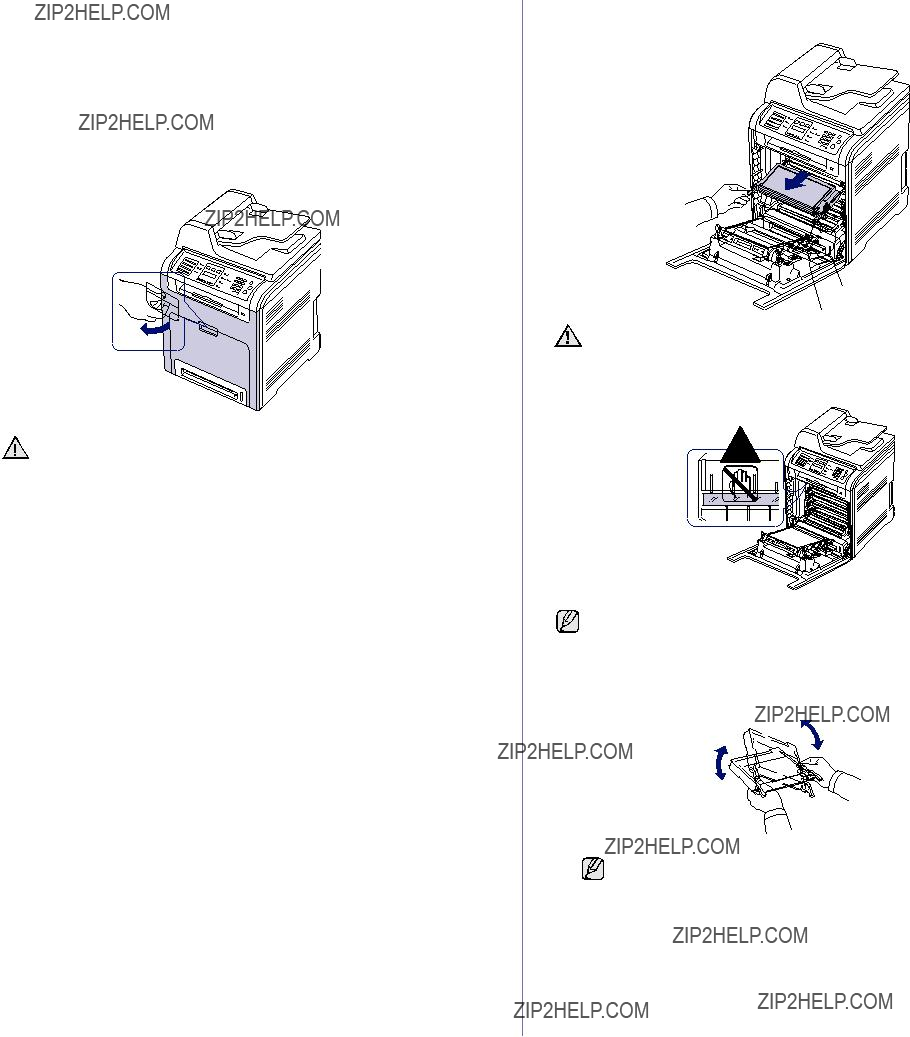
Redistributing toner
When a toner is low, faded or light areas may appear. It is possible that colored images may be printed with incorrect colors due to flawed mixing of toner colors when one of the colored toner cartridges is low on toner. You can temporarily improve print quality by redistributing the toner.
???The
???The SmartPanel program window appears on the computer telling you which color cartridge is low on toner.
1. Using the handle, completely open the front cover.
???Do not touch the green surface, the OPC drum or the front of the toner cartridge, with your hands or any other material. Use the handle on each cartridge in order to avoid touching this area.
???Be careful not to scratch the surface of the paper transfer belt.
???If you leave the front cover open for more than a few minutes, the OPC drum can be exposed to light. This will cause damage to the OPC drum. Close the front cover should the installation need to be halted for any reason.
2.Grasp the handles on the toner cartridge and pull to remove the cartridge from the machine.
When you open the front cover, be careful not to touch the underneath of the control panel (the lower part of the fuser unit). The temperature of the fuser unit might be high and could damage your skin.
When you open the front cover and work inside the machine, it is highly recommend that you remove the paper transfer belt first. Because the work you do could contaminate the paper transfer belt.
3.Holding both handles on the toner cartridge, thoroughly rock it from side to side to evenly distribute the toner.
If toner gets on your clothing, wipe it off with a dry
cloth and wash it in cold water. Hot water sets toner into fabric.
66 _Maintenance

4. Slide the toner cartridge back into the machine.
5. Close the front cover. Make sure the cover is securely latched.
If the front cover is not completely closed, the machine will not operate.
REPLACING THE TONER CARTRIDGE
The machine uses four colors and has a different toner cartridge for each one: yellow (Y), magenta (M), cyan (C), and black (K).
???The status LED and the
???For the
saved in memory.
At this stage, the toner cartridge needs to be replaced. Check the type of toner cartridge for your machine. (See "" on page 91.)
1.Turn the machine off, then wait a few minutes for the machine to cool.
2.Using the handle, completely open the front cover.
???Do not touch the green surface, the OPC drum or the front of each toner cartridge, with your hands or any other material. Use the handle on each cartridge in order to avoid touching this area.
???Be careful not to scratch the surface of the paper transfer belt.
???If you leave the front cover open for more than a few minutes, the OPC drum can be exposed to light. This will cause damage to the OPC drum. Close the front cover should the installation need to be halted for any reason.
3.Grasp the handles on the toner cartridge and pull to remove the cartridge from the machine.
When you open the front cover, be careful not to touch the underneath of the control panel (the lower part of the fuser unit). The temperature of the fuser unit might be high and could damage your skin.
When you open the front cover and work inside the machine, it is highly recommend that you remove the paper transfer belt first. Because the work you do could contaminate the paper transfer belt.
4.Take a new toner cartridge out of its package.
???Don't use sharp objects, such as a knife or scissors, to open the toner cartridge package. You could damage the surface of the toner cartridge.
???To prevent damage, do not expose the toner cartridge to light for more than a few minutes. Cover it with a piece of paper to protect it if necessary.
Maintenance_ 67

5.Holding both handles on the toner cartridge, thoroughly rock it from side to side to evenly distribute the toner.
6.Place the toner cartridge on a flat surface, as shown, and remove the paper covering the toner cartridge by removing the tape.
If toner gets on your clothing, wipe it off with a dry cloth and wash it in cold water. Hot water sets toner into fabric.
7.Make sure that the color of the toner cartridge matches the color slot and then grasp the handles on the toner cartridge. Insert the cartridge until it clicks into place.
8.Close the front cover. Make sure the cover is securely latched, and then turn the machine on.
If the front cover is not completely closed, the machine will not operate.
Clearing the Toner Empty message
When the Toner Empty message appears you can configure not to see this message again not to disturb you.
1.Press Menu ( ) until System Setup appears on the bottom line of the display and press OK.
) until System Setup appears on the bottom line of the display and press OK.
2.Press the Scroll buttons until Maintenance appears and press OK.
3.Press the Scroll buttons until CLR Empty Msg. appears and press OK.
4.Press the left/right arrow until the color menu you want appears on display and press OK.
5.Select On and press OK.
6.Now the Toner Empty message does not appear but the Replace Toner message will remain for reminding you that the new cartridge needs to be installed for quality.
???Once you have selected On, this setting will be permanently written to the memory of the toner cartridge, and this menu will be disappeared from the Maintenance menu.
???You can keep printing but the quality cannot be guaranteed, and the product support is no longer provided.
REPLACING THE PAPER TRANSFER BELT
The life of the paper transfer belt is approximately 50,000 black and color pages. After the life span of the paper transfer belt is complete, you have to replace it.
???The transfer
???The SmartPanel program window appears on the computer telling you the paper transfer belt needs to be replaced.
The life span of the paper transfer belt may be affected by operating environment, printing interval, media type, and media size.
1.Turn the machine off, then wait a few minutes for the machine to cool.
2.Using the handle, completely open the front cover.
3.Press the green release handle to release the paper transfer belt. Holding the handle on the paper transfer belt, lift it out of the machine.
68 _Maintenance
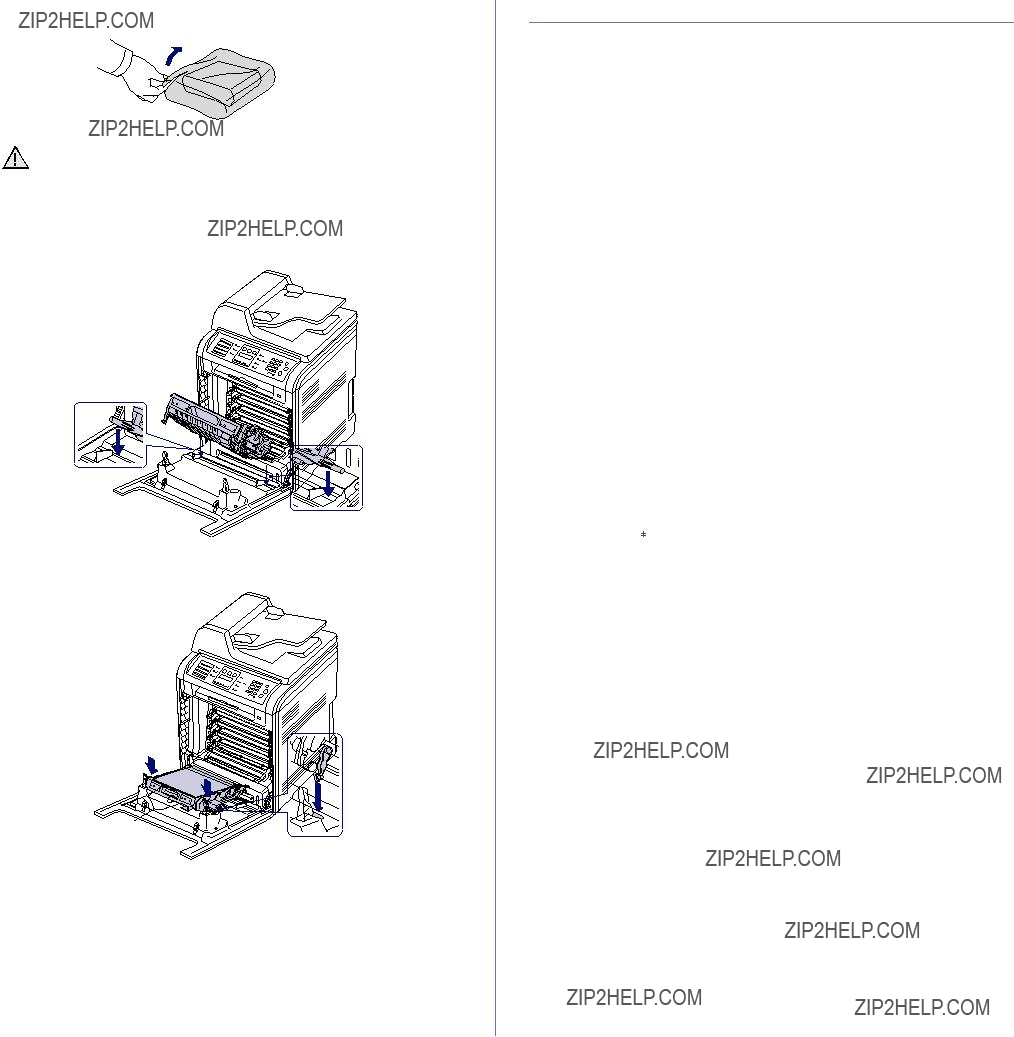
4.Take a new paper transfer belt out of its package.
???Don't use sharp objects, such as a knife or scissors, to open the paper transfer belt package. You could damage the surface of the paper transfer belt.
???Be careful not to scratch the surface of the paper transfer belt.
5.Holding the handle on the new paper transfer belt, align it with the slots on the inside of the front cover.
6.Lower the paper transfer belt until it is parallel with the front cover and firmly seated.
7.Close the front cover firmly.
8.Turn the machine on.
MAINTENANCE PARTS
To avoid print quality and paper feed problems resulting from worn parts, and to maintain your machine in top working condition the following condition, the following items will need to be replaced after the specified number of pages, or when the life span of each item has expired.
We highly recommend that this maintenance be performed by an authorized service provider, dealer or the retailer where you bought the machine. The warranty does not cover the replacement of the maintenance parts after their lifespan.
Checking replaceables
If you experience frequent paper jams or printing problems, check the number of pages the machine has printed or scanned. Replace the corresponding parts, if necessary.
1.Press Menu ( ) until System Setup appears on the bottom line of the display and press OK.
) until System Setup appears on the bottom line of the display and press OK.
2.Press the left/right arrow until Maintenance appears and press OK.
3.Press the left/right arrow until Supplies Life appears and press OK.
4.Press the left/right arrow until the item you want appears and press OK.
???Supplies Info: Prints the supply information page.
???Total: Displays the total number of pages printed.
???ADF Scan: Displays the number of pages scanned using the ADF.
???Platen Scan: Displays the number of pages scanned using the scanner glass.
???Transfer Belt, Fuser, Tray1 Roller, Tray2 Roller, MP Tray Roller: Displays the number of pages printed each item.
5.If you selected to print a supply information page, press OK to confirm.
6.Press Stop/Clear to return to ready mode.
Maintenance_ 69

Replacing the DADF (or ADF) rubber pad
You will need to replace the DADF (or ADF) rubber pad when there seems to be a consistent problem with paper pickup or when its specified yield is reached.
For the ADF
1.Open the ADF cover.
2.Rotate the bushing on the right end of the ADF roller toward the ADF and remove the roller from the slot.
1 Bushing
2 ADF roller
3. Remove the ADF rubber pad from the ADF, as shown.
1 ADF rubber pad
4.Insert a new ADF rubber pad into place.
5.Align the left end of the ADF roller with the slot and push the right end of the roller into the right slot. Rotate the bushing on the right end of the roller toward the document input tray.
6. Close the ADF cover.
For the DADF
1.Open the DADF cover.
2.Remove the DADF rubber pad from the DADF, as shown.
1 DADF rubber pad
3.Insert a new DADF rubber pad into place.
4.Close the DADF cover.
MANAGING YOUR MACHINE FROM THE
WEBSITE
If you have connected your machine to a network and set up TCP/IP network parameters correctly, you can manage the machine via Samsung???s
SyncThru??? Web Service, an embedded web server. Use SyncThru??? Web Service to:
???View the machine???s device information and check its current status.
???Change TCP/IP parameters and set up other network parameters.
???Change the printer properties.
???Set the machine to send email notifications to let you know the machine???s status.
???Get support for using the machine.
To access SyncThru??? Web Service:
1.Start a web browser, such as Internet Explorer, from Windows.
2.Enter the machine IP address (http://xxx.xxx.xxx.xxx) in the address field and press the Enter key or click Go.
Your machine???s embedded website opens.
CHECKING THE MACHINE???S SERIAL NUMBER
When you call for service or register as a user on the Samsung website, the machine???s serial number may be required.
You can check the serial number by taking the following steps:
1.Press Menu (  ) until System Setup appears on the bottom line of the display and press OK.
) until System Setup appears on the bottom line of the display and press OK.
2.Press the left/right arrow until Maintenance appears and press OK.
3.Press the left/right arrow until Serial Number appears and press OK.
4.Check your machine???s serial number.
5.Press Stop/Clear to return to ready mode.
70 _Maintenance
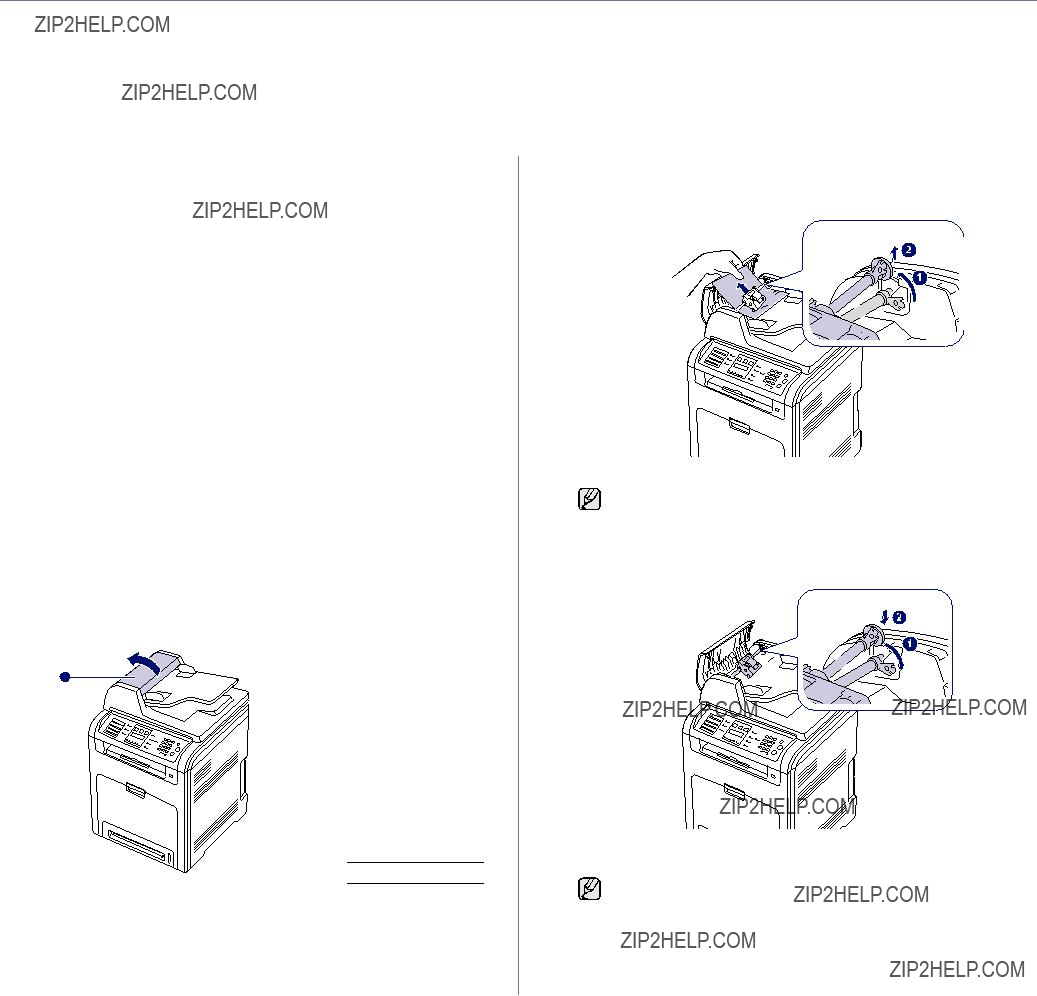
troubleshooting
This chapter gives helpful information for what to do if you encounter an error.
This chapter includes:
???Tips for avoiding paper jams
TIPS FOR AVOIDING PAPER JAMS
By selecting the correct media types, most paper jams can be avoided. When a paper jam occurs, follow the steps outlined on page 71.
???Follow the procedures on page 36. Ensure that the adjustable guides are positioned correctly.
???Do not overload the tray. Ensure that the paper level is below the paper capacity mark on the inside of the tray.
???Do not remove paper from the tray while your machine is printing.
???Flex, fan, and straighten paper before loading.
???Do not use creased, damp, or highly curled paper.
???Do not mix paper types in a tray.
???Use only recommended print media. (See "Setting the paper size and type" on page 38.)
???Ensure that the recommended side of the print media is facing up in the tray, or facing down in the
CLEARING DOCUMENT JAMS
When an original jams while passing through the DADF (or ADF), Document Jam appears on the display.
Input Misfeed
For the ADF
1.Remove any remaining pages from the ADF.
2.Open the ADF cover.
???Understanding display messages
3.Rotate the bushing on the right end of the ADF roller toward the ADF (1) and remove the roller from the slot (2). Pull the document gently to the left and out of the ADF.
This illustration may differ from your machine depending on its model.
4.Align the left end of the ADF roller with the slot and push the right end of the ADF roller into the right slot (1). Rotate the bushing on the right end of the roller toward the document input tray (2).
5.Close the ADF cover. Then load the removed page(s), if any, back into the ADF.
Troubleshooting_ 71

For the DADF
1.Remove any remaining pages from the DADF.
2.Open the DADF cover.
1 DADF cover
3. Pull the jammed paper gently out of the DADF.
This illustration may differ from your machine depending on its model.
4.Close the DADF cover. Then load the removed pages, if any, back into the DADF.
To prevent document jams, use the scanner glass for thick, thin, or mixed
Exit misfeed
1.Remove any remaining pages from the DADF (or ADF).
2.Seize the misfeed paper, and remove the paper from the document output tray by carefully pulling it to the right using both hands.
3. Load the removed pages back into the DADF (or ADF).
Roller misfeed
1.Open the scanner lid.
2.Seize the misfeed paper, and remove the paper from the feed area by carefully pulling it to the right using both hands.
3.Close the scanner lid. Then load the removed pages back into the DADF (or ADF).
72 _Troubleshooting
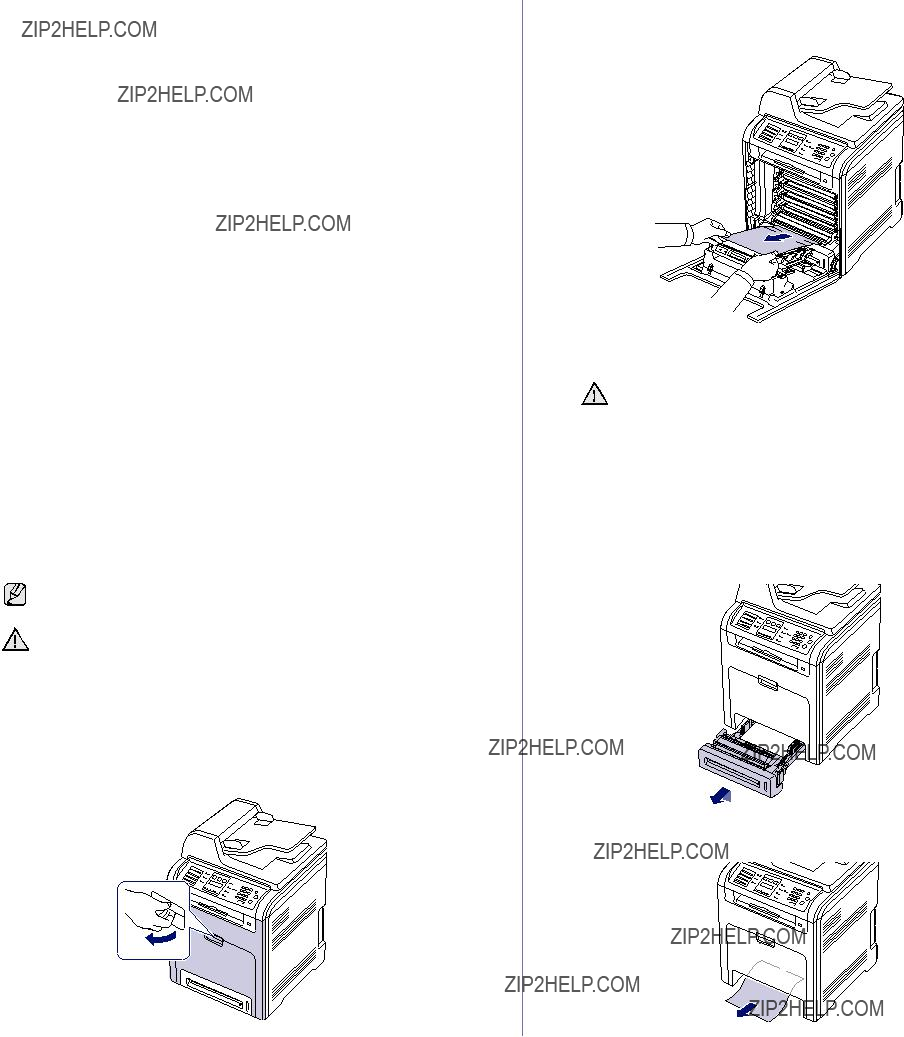
CLEARING PAPER JAMS
When a paper jam occurs, the warning message appears on the display screen. Refer to the table below to locate and clear the paper jam.
Some messages may not appear in the display depending on options or models.
To avoid tearing the paper, pull the jammed paper out gently and slowly. Follow the instructions in the following sections to clear the jam.
In the paper feed area
If paper is jammed in the paper feed area, follow the next steps to release the jammed paper.
1. Using the handle, completely open the front cover.
2.Carefully remove the paper by pulling in the direction as shown below. Go to step 7.
If you cannot find the jammed paper, or if there is any resistance removing the paper, stop pulling, and go to step 3.
???Do not touch the green surface, the OPC drum or the front of each toner cartridge, with your hands or any other material. Use the handle on each cartridge in order to avoid touching this area.
???Be careful not to scratch the surface of the paper transfer belt.
???If you leave the front cover open for more than a few minutes, the OPC drum can be exposed to light. This will cause damage to the OPC drum. Close the front cover should the installation need to be halted for any reason.
3.Close the front cover.
4. Pull the tray open.
5.Remove the jammed paper by gently pulling it straight out as shown below.
Troubleshooting_ 73

6. To replace the tray, lower the rear edge, align it with the slot, and slide it into the machine. 
7. Open the front cover and close it. The machine will resume printing.
In the
When you print using the
1. Check if the paper is stuck in the feeding area, and if so, pull it out gently and slowly. 
If you cannot find the jammed paper, or if there is any resistance removing the paper, stop pulling and go to step 2.
2.Close the
3.Pull the tray out.
4.Open the inner cover while you are pushing the lever with two hands.
5. Pull the paper out gently.
6.Replace the tray.
If you cannot find the jammed paper, or if there is any resistance removing the paper, stop pulling and go to step 8.
7.Using the handle, completely open the front cover.
8.Remove the jammed paper by pulling in the direction shown. To avoid tearing the paper, pull it out gently and slowly.
???Do not touch the green surface, the OPC drum or the front of each toner cartridge, with your hands or any other material. Use the handle on each cartridge in order to avoid touching this area.
???Be careful not to scratch the surface of the paper transfer belt.
???If you leave the front cover open for more than a few minutes, the OPC drum can be exposed to light. This will cause damage to the OPC drum. Close the front cover should the installation need to be halted for any reason.
9.Close the front cover firmly. The machine will resume printing.
If the front cover is not completely closed, the machine will not operate.
74 _Troubleshooting

In the fuser unit area
If paper is jammed in the fuser unit area, follow the next steps to release the jammed paper.
1. Open the scan unit.
2. Open the inner cover using the handle.
3.Open the inner cover using the handle on it and carefully take the jammed paper out of the machine.
Do not touch the fuser inside the inner cover. It is hot and could cause burns! The fuser's operating temperature is 180??C (356??F). Take care when removing paper from the machine.
4.Pull up the paper jam lever to loose the fusing part of the fuser unit and carefully take the jammed paper out of the machine.
5.Press down the paper jam lever to fasten the fusing part.
6.Close the inner cover.
7.Lowering down the scan unit gently and slowly until it is completely closed. Make sure that it is securely latched.
Be careful not to pinch your fingers!
If the scan unit is not completely closed, the machine will not operate.
Troubleshooting_ 75

In the paper exit area
If paper is jammed in the paper exit area, follow the next steps to release the jammed paper.
1.If a long portion of the paper is visible, pull it straight out. Open and close the front cover firmly. The machine will resume printing.
If you cannot find the jammed paper, or if there is any resistance removing the paper, stop pulling and go to step 2.
2. Open the scan unit.
3.Open the cover of reverse unit using the handle on it and carefully take the jammed paper out of the machine.
If there is any resistance removing the paper or difficulty picking up jammed paper, stop pulling and turn the release knob to the direction as
shown to remove the misfed paper.
4.Close the cover of reverse unit.
5.Lowering down the scan unit gently and slowly until it is completely closed. Make sure that it is securely latched.
Be careful not to pinch your fingers!
If the scan unit is not completely closed, the machine will not operate.
If you cannot find the jammed paper, or if there is any resistance removing the paper, stop pulling and go to step 6.
6.Open the rear cover and carefully take the jammed paper out of the machine.
76 _Troubleshooting
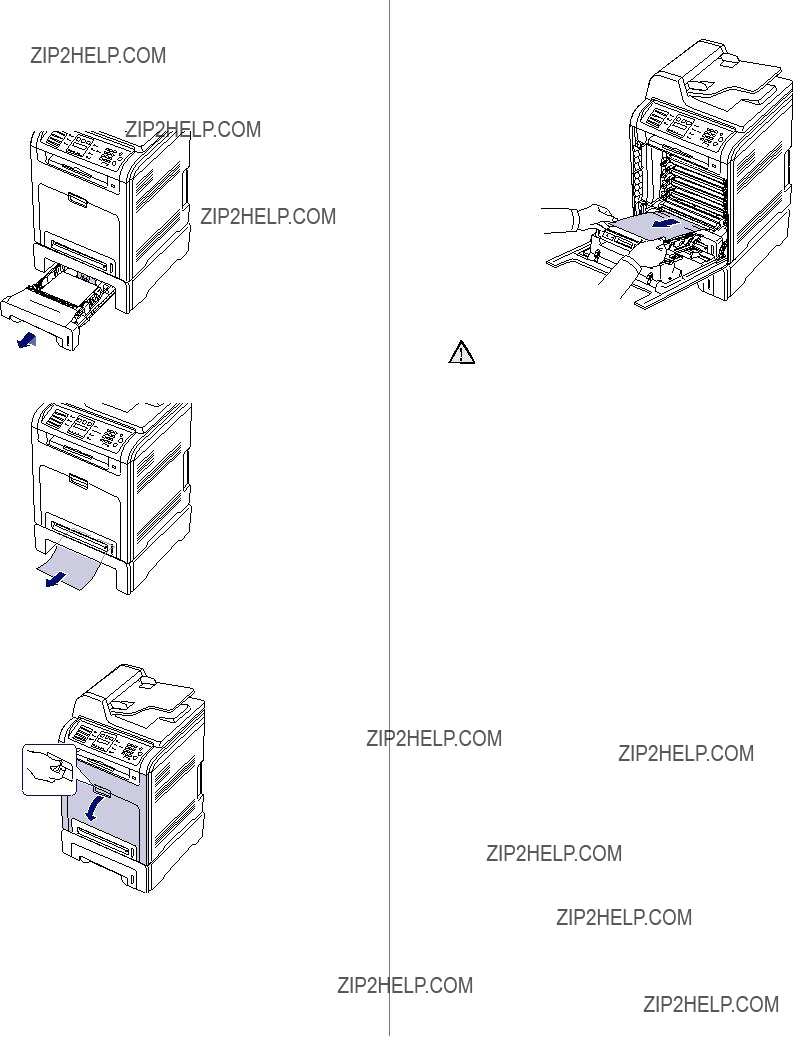
7. Close the rear cover.
In the optional tray
If paper is jammed in the optional Tray, follow the next steps to release the jammed paper.
1.Pull the optional Tray open. After you pull it all the way out, lift up the front part of the tray slightly to release the tray from the machine.
2.If you see the jammed paper, remove the paper from the machine by gently pulling it straight out as shown below.
3.Slide the tray back into the machine.
4.Open the front cover.
5.Pull the jammed paper out in the direction shown. To avoid tearing the paper, pull it out gently and slowly.
6. Close the front cover firmly. The machine will resume printing.
If the front cover is not completely closed, the machine will not operate.
Troubleshooting_ 77

UNDERSTANDING DISPLAY MESSAGES
Messages appear on the control panel display to indicate the machine???s status or errors. Refer to the tables below to understand the messages??? meaning and correct the problem if necessary. Messages and their meanings are listed in alphabetical order.
??? If the message is not in the table, cycle the power and try the printing job again. If the problem persists, call for service.
???Some messages may not appear in the display depending on options or models.
???xxx indicates the media type.
???yyy indicates the tray.
78 _Troubleshooting

Troubleshooting_ 79

80 _Troubleshooting
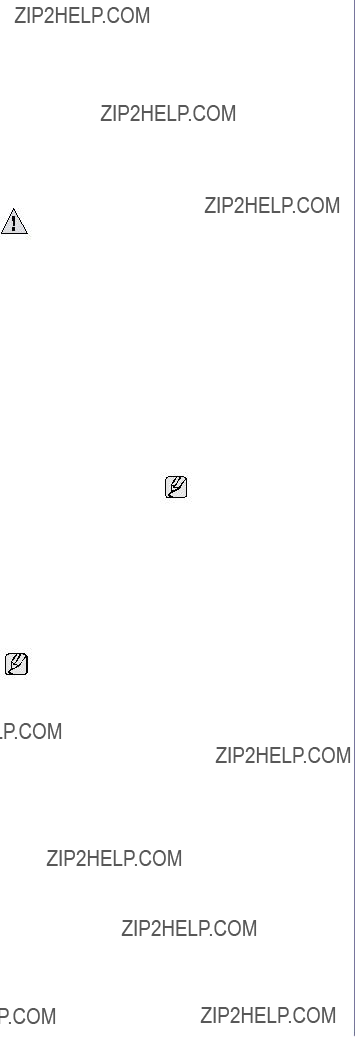
Troubleshooting_ 81

SOLVING OTHER PROBLEMS
The following chart lists some conditions that may occur and the recommended solutions. Follow the suggested solutions until the problem is corrected. If the problem persists, call for service.
Paper feeding
82 _Troubleshooting

Printing problems
???Check the machine for the following:
???The front cover is not closed. Close the cover.
???Paper is jammed. Clear the paper jam. See page 73.
???No paper is loaded. Load paper. See page 36.
???The toner cartridge is not installed. Install the toner cartridge.
???If a system error occurs, contact your service representative.
Troubleshooting_ 83
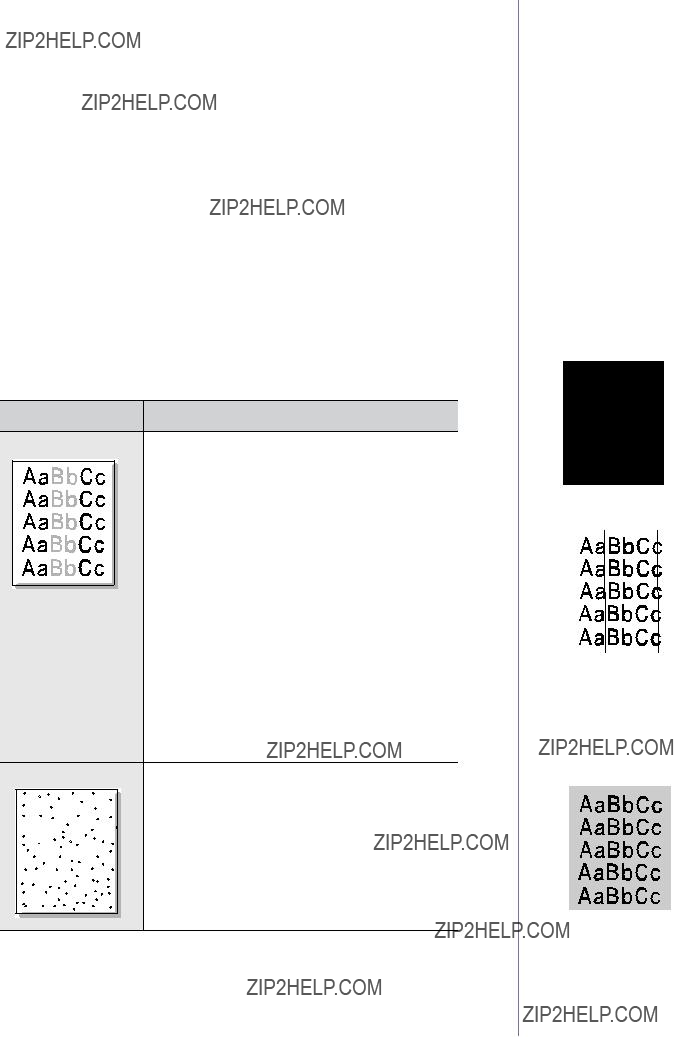
Printing quality problems
If the inside of the machine is dirty or paper has been loaded improperly, you may notice a reduction in print quality. See the table below to clear the problem.
84 _Troubleshooting
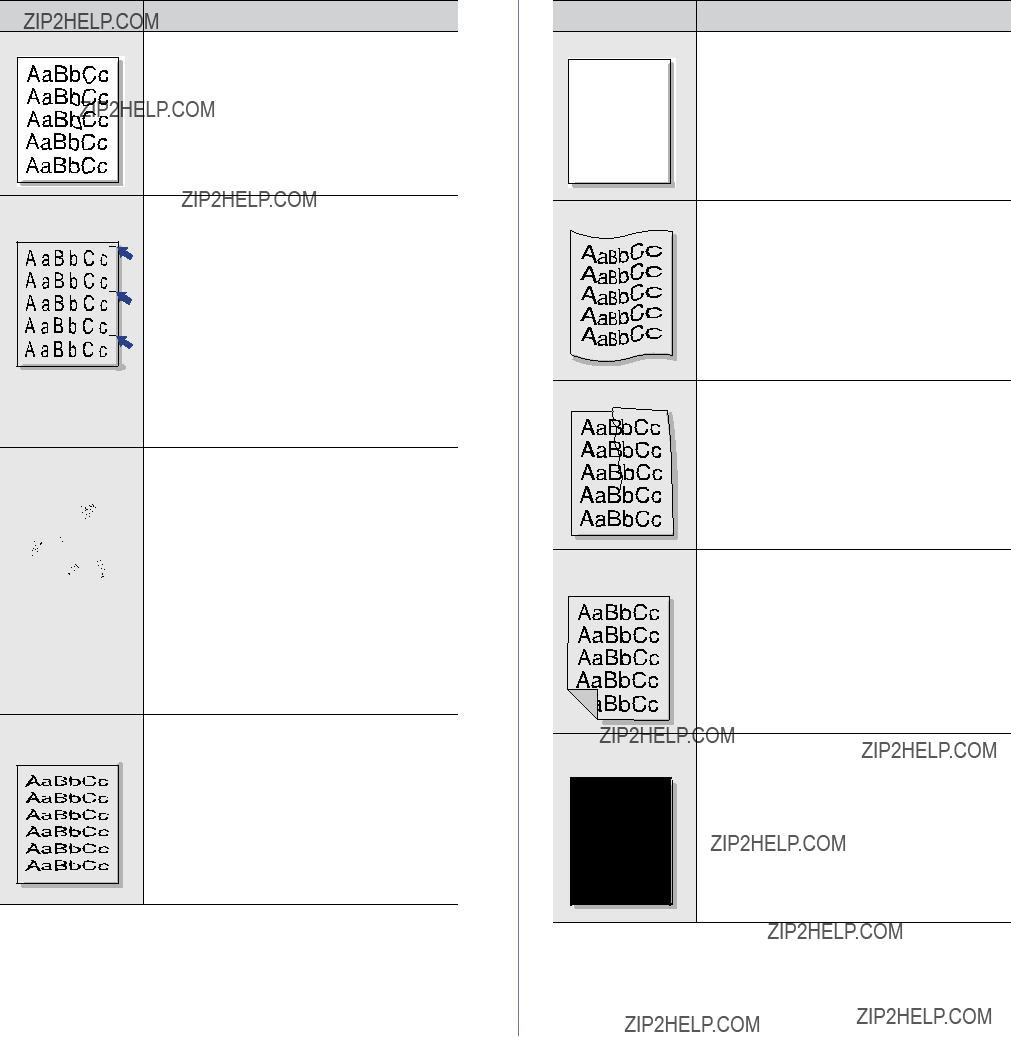
???The toner cartridge may be damaged. If a
repetitive mark occurs on the page, print a cleaning sheet several times to clean the cartridge. After the printout, if you still have the same problems, remove the toner cartridge and install a new one. See page 66.
??? Parts of the machine may have toner on them. If the defects occur on the back of the page, the problem will likely correct itself after a few more pages.
???The fusing assembly may be damaged. Contact a service representative.
???If background scatter covers the entire surface area of a printed page, adjust the print resolution through your software application or the printer properties.
Wrinkles or creases ??? Ensure that the paper is loaded properly.
???Check the paper type and quality. See page 33.
???Turn over the stack of paper in the tray. Also
try rotating the paper 180?? in the tray.
Troubleshooting_ 85
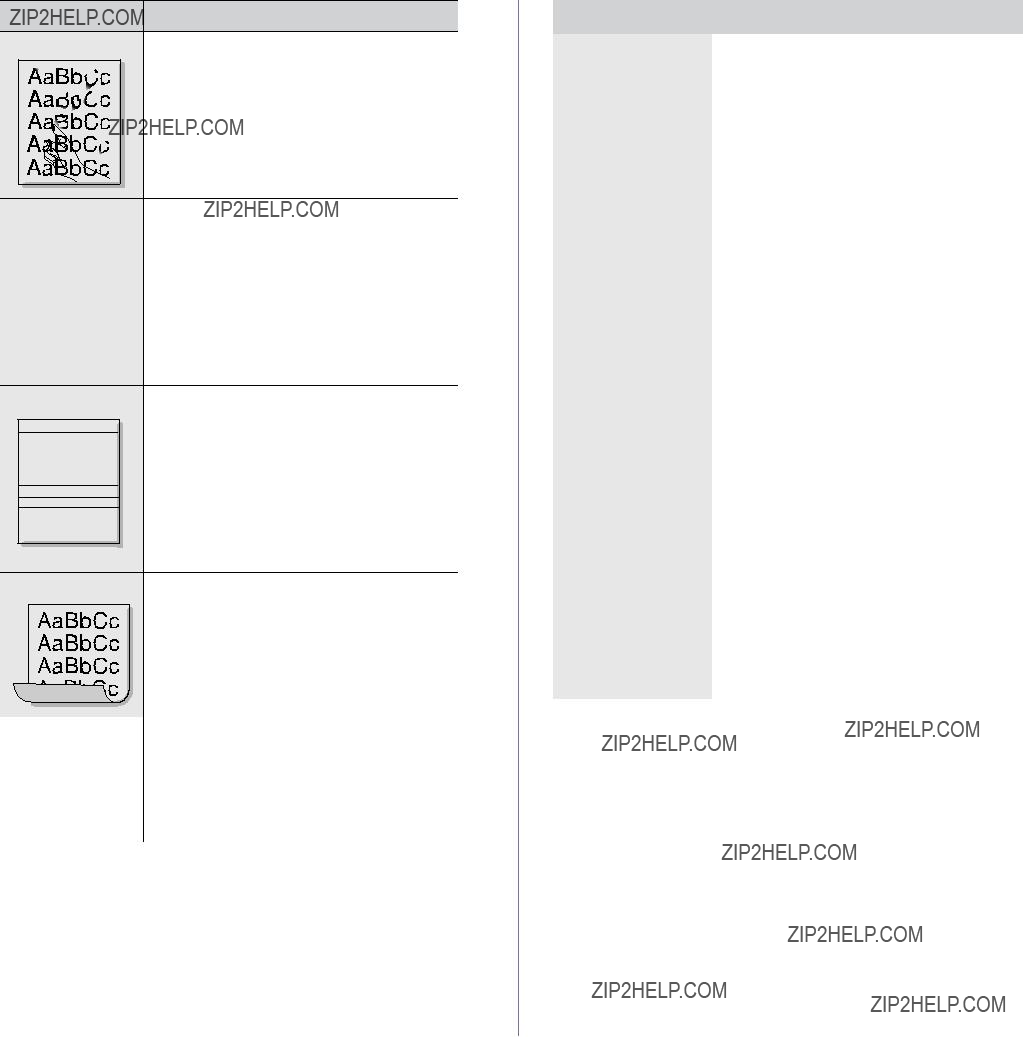
???Turn over the stack of paper in the tray.
86 _Troubleshooting

Scanning problems
??????Invalid handle.???
??????Scanning has failed.???
Samsung Scan Manager problems
Fax problems
Troubleshooting_ 87

Common PostScript problems
The following situations are PS language specific and may occur when several printer languages are being used.
To receive a printed or
Refer to the Microsoft Windows documentation that came with your computer for further information on Windows error messages.
88 _Troubleshooting

Common Linux problems
Troubleshooting_ 89

Refer to Linux User???s Guide that came with your computer for further information on Linux error messages.
Common Macintosh problems
Refer to Mac OS User???s Guide that came with your computer for further information on Mac OS error messages.
90 _Troubleshooting

ordering supplies and accessories
This chapter provides information on purchasing cartridges and accessories available for your machine.
This chapter includes:
???Supplies
???Accessories
The optional parts or features may differ by countries. Contact your sales representatives whether the part you want is available in your country.
SUPPLIES
When the toner runs out, you can order the following type of toner cartridge for your machine:
a.Declared yield value in accordance with ISO/IEC 19798.
When purchasing new print cartridges or other supplies, these must be purchased in the same country where the machine was purchased. Otherwise, print cartridges or other supplies will be incompatible with your machine, as configurations of print cartridges and other supplies vary, depending on the specific country.
ACCESSORIES
You can purchase and install accessories to enhance your machine???s performance and capacity.
a.Depending on your country, wireless LAN cards may not be available. Contact your local Samsung dealer or the retailer where you bought your printer.
Your machine may have two memory slots with a factory
Ordering supplies and accessories_ 91

HOW TO PURCHASE
To order
92 _Ordering supplies and accessories
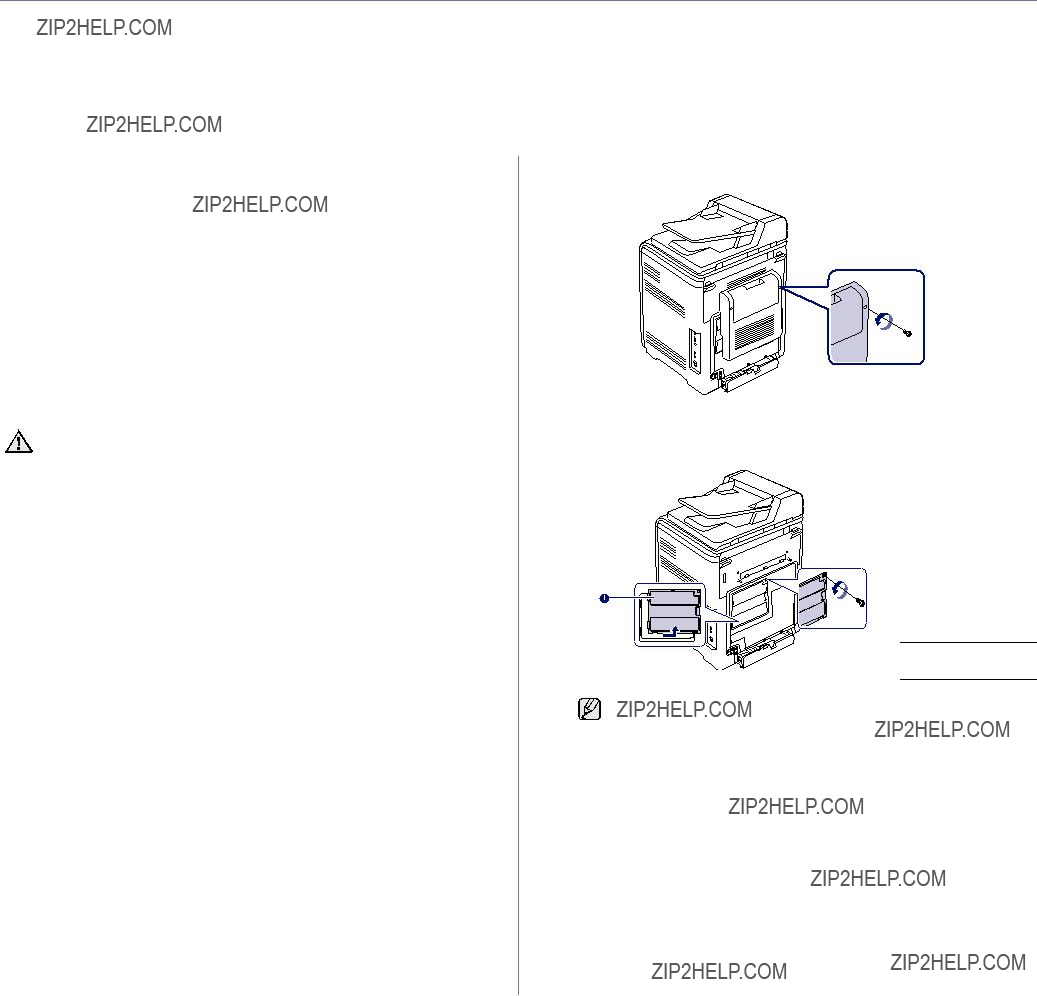
installing accessories
Your machine is a
This chapter includes:
???Precautions to take when installing accessories
PRECAUTIONS TO TAKE WHEN INSTALLING
ACCESSORIES
???Disconnect the power cord
Never remove the control board cover while the power is turned on. To avoid the possibility of an electrical shock, always disconnect the power cord when installing or removing ANY internal or external accessories.
???Discharge static electricity
The control board and internal accessories (network interface card or memory module) are sensitive to static electricity. Before installing or removing any internal accessories, discharge static electricity from your body by touching something metal, such as the metal back plate on any device plugged into a grounded power source. If you walk around before finishing the installation, repeat this procedure to discharge any static electricity again.
When installing accessories, battery inside the machine is a service component. Do not change it by yourself.
Risk of explosion if battery is replaced by an incorrect type. Dispose used batteries according to the instructions.
UPGRADING A MEMORY MODULE
Your machine has a dual
The machine has two memory slots with a factory
Installing a memory module
1. Turn the machine off and unplug all cables from the machine.
???Using a wireless network interface card
2. Release the screws and remove the rear cover.
3.Release the screws, then lift up the cover slightly and pull the cover to the right.
1 Control board cover
If you want to remove an existing memory module, push the two latches at the ends of the module outward.
4. Take out a new memory module from the plastic bag.
Installing accessories_ 93

5.Holding the memory module by the edges, align the memory module on the slot at about a
The notches and grooves illustrated above may not match those on an actual memory module and its slot.
6. Press the memory module into the slot with care until you hear a 'click'.
Do not press the memory module strongly or the module may be damaged. If the module does not seem to fit into the slot properly, carefully try the previous procedure again.
7. Replace the control board cover and fasten the cover with the screws.
8.Replace the rear cover and fasten the cover with the screw.
9.Reconnect the power cord and printer cable, and turn the machine on.
To release the memory module, pull the two tabs on the sides of the slot outwards, then the module springs out.
Activating the added memory in the PS printer properties
After installing the memory module, you need to select it in the printer properties of the PostScript printer driver in order to use it.
1.Make sure that the PostScript printer driver is installed on your computer. For details about installing the PS printer driver, see Software secion.
2.Click the Windows Start menu.
3.For Windows 2000, select Settings and then Printers.
For Windows XP/2003, select Printers and Faxes.
For Windows Vista, select Control Panel > Hardware and Sound > Printers.
4.Select the Samsung
5.Click the right mouse button on the printer icon and select Properties.
6.For Windows 2000/XP/2003/Vista, select Device Settings.
7.Select the amount of memory you installed from Printer Memory in the
Installable Options section.
8.Click OK.
USING A WIRELESS NETWORK INTERFACE CARD
The
For order information, see page 91
Review the precautions on page 93 and then follow this procedure to install the wireless network interface card in your machine.
Installing a wireless network interface card
1.Turn the machine off and unplug all cables from the machine.
2.Release the screws and remove the rear cover.
3.Release the screws, then lift up the cover slightly and pull the cover to the right.
1 Control board cover
94 _Installing accessories

4.Align the connector on the wireless network interface card with the connector on the control board. Push the card firmly into the connector on the control board until it is completely and securely in place.
1 Connector
2 Wireless network interface card
5. Replace the control board cover and fasten the cover with the screws.
6.Replace the rear cover and fasten the cover with the screw.
7.Reconnect the power cord and printer cable, and turn the machine on.
For information about configuring and using the printer on a wireless network environment, refer to the user???s guide provided with the wireless network interface card. You can also configure the network parameters on the control panel; see the next column.
Configuring basic network settings
After installing the wireless network card, you must configure the appropriate network parameters to use your printer in a wireless network. To do this, you can use both control panel and SyncThru Web Service, an embedded web site of your printer. This section gives you basic information on 802.11b/g network parameters which can be configured from the control panel.
You can configure basic wireless settings, such as SSID, Operation Mode, and channels. You can retrieve basic settings by selecting a wireless network or manually configure them as you need.
1.Press Menu ( ) until Network appears on the bottom line of the display and press OK.
) until Network appears on the bottom line of the display and press OK.
2.Press the left/right arrow until Wireless appears and press OK.
3.Press OK when WLAN Basic appears.
4.Press the left/right arrow to select the setup method you want and press
OK.
???Search List: The wireless network interface card on your printer searches for wireless networks in the area and shows the results.
???Custom: You can configure the wireless settings according to your needs.
5.If you selected Search List, press the left/right arrow to select a network and press OK.
If you selected Custom, set each network options:
???Edit SSID: Enter the SSID, the name that identifies a wireless network. SSID is
???Operation Mode: Select the type of wireless connections.
In
In
???Channel: This option is available only in the
6.When you have finished, press Stop/Clear to return to ready mode.
Selecting the authentication type
Authentication is a process of identifying the legitimacy of an user to access a network. You can select whether or not authentication is used.
1.Press Menu ( ) until Network appears on the bottom line of the display and press OK.
) until Network appears on the bottom line of the display and press OK.
2.Press the left/right arrow until Wireless appears and press OK.
3.Press the left/right arrow until WLAN Security appears and press OK.
4.Press the left/right arrow until Static WEP appears and press OK.
5.Press the left/right arrow until Authentication appears and press OK.
6.Press the left/right arrow to select the type you want.
???Open System: Authentication is not used.
???Shared Key: Authentication is used.
7.Press OK to save your selection.
8.Press Stop/Clear to return to ready mode.
Setting Encryption
If your network uses WEP encryption keys, you can must select the appropriate encryption type and configure encryption keys. You can configure up to four keys. The active key must match the key value and key position (for example, Key 1) configured on other wireless devices in the network.
1.Press Menu ( ) until Network appears on the bottom line of the display and press OK.
) until Network appears on the bottom line of the display and press OK.
2.Press the left/right arrow until Wireless appears and press OK.
3.Press the left/right arrow until WLAN Security appears and press OK.
4.Press the left/right arrow until Static WEP appears and press OK.
5.Press the left/right arrow until Encryption appears and press OK.
If you have set the authentication type to Open System, the Encryption menu does not display.
6.Set each encryption option and press OK.
???Encrypt. Type: Select an encryption type: None,
???Key Type: Select the key type of your network.
???Using Key: Select the key to be used in your network.
???Edit Key: Enter the key number for the selected key position.
Installing accessories_ 95

The numbers you can enter as follows:
7. When you have finished, press Stop/Clear to return to ready mode.
Restoring default values for wireless networking
If the problem occurrs when you use or set up the wireless network values, take following stops to restore factory default values. Generally, factory values of wireless networking are optimized for your printer.
1.Press Menu ( ) until Network appears on the bottom line of the display and press OK.
) until Network appears on the bottom line of the display and press OK.
2.Press the left/right arrow until Wireless appears and press OK.
3.Press the left/right arrow until WLAN Default appears and press OK.
4.When Restore appears on the bottom line of the display, press OK. The machine starts restoring the default values.
USING THE HARD DISK
Installing the hard disk allows the data from your computer to be sent to the print queue of the printer hard disk. This decreases the workload of the computer. You can also use various print features, such as storing a job in the hard disk, proofing a job, and printing private documents.
Installing the hard disk
For order information, see "Accessories" on page 91. Review the precautions on page 93.
1.Turn the machine off and unplug all cables from the machine.
2.Release the screws and remove the rear cover.
3.Open the control board cover. Release the screws, then lift up the cover slightly and pull the cover to the right.
1 control board cover
4. Align the connector on the hard disk with the connector on the control board. Push the hard disk in until it is latched into place
.
5. Fasten the screws supplied with your new hard disk.
6. Replace the control board cover and fasten the cover with the screws.
7. Replace the rear cover and fasten the cover with the screw.
96 _Installing accessories

8.Reconnect the power cord and printer cable, and turn the machine on.
9.Print a configuration page from the control panel to check if the hard disk is correctly installed. See page 62.
Setting the hard disk in the printer properties
After installing the hard disk, you need to select it in the printer properties to enable its use. Take the following steps:
1.Click the Windows Start menu.
2.For Windows 2000, select Settings and then Printers.
For Windows XP/2003, select Printers and Faxes.
For Windows Vista, select Control Panel > Hardware and Sound > Printers.
3.Select the Samsung
4.
???Samsung
???Samsung
Click the Device Option or Device Settings tab and set the Optional Hard Disk Drive (HDD) option to Installedd
5.Click OK.
Printing with the optional hard disk
After installing the optional hard disk, you can use advanced printing features, such as storing or spooling a print job to the hard disk, proofing a job, and specifying of printing a private job in the printer properties window.
Once you have stored files in the hard disk, you can easily print or delete the stored files using the control panel of your printer.
Storing a job
You can store jobs in the installed hard disk.
1.Open the file you want to store.
2.Select Print from the File menu. The Print window displays.
3.Click Properties. If you see Setup, Print or Options, click the button instead.
4.Click the Extra tab and click Job Setting.
5.Select the print mode you want from the
???Normal: Prints in normal mode.
???Proof: Prints the first file and after a pause prints the next file.
???Confidentical: Stores the files, securing them with a password.
???Store: Stores the file to the hard disk.
???Spool: Spools the file into the hard disk and prints it from the hard disk queue.
???Delay: Prints the file at a specified time.
6.Enter the user???s name and file name.
7.Click OK until the Print window is displayed.
8.Click OK or Print to start printing.
Printing a stored job
You can print jobs currently stored in the hard disk.
1.Press Menu ( ) until System Setup appears on the bottom line of the display and press OK.
) until System Setup appears on the bottom line of the display and press OK.
2.Press the left/right arrow until Job Manage appears and press OK.
3.Press the left/right arrow until Store Job appears and press OK.
4.Press the left/right arrow until the user???s name and file name you want appear and press OK.
5.If the select file is a confidential print job, enter the specified
Press the left/right arrow to enter the first digit and press OK. The cursor automatically moves to the next digit position. Enter the 2nd, 3rd, and 4th digit in the same way.
6.When Print appears, press OK.
If you enter the incorrect password, Invalid Password appears. Reenter the correct password.
7.Press the left/right arrow until the number of copies you want appears and press OK.
8.Press OK. Printing starts.
Deleting a stored job
You can delete jobs currently stored in the hard disk.
1.Press Menu ( ) until System Setup appears on the bottom line of the display and press OK.
) until System Setup appears on the bottom line of the display and press OK.
2.Press the left/right arrow until Job Manage appears and press OK.
3.Press the left/right arrow until Store Job appears and press OK.
4.Press the left/right arrow until the user???s name and file name you want appear and press OK.
5.If the select file is a confidential print job, enter the specified
Press the left/right arrow to enter the first digit and press OK. The cursor automatically moves to the next digit position. Enter the 2nd, 3rd, and 4th digit in the same way.
6.Press the left/right arrow until Delete appears and press OK.
If you enter the incorrect password, Invalid Password appears. Reenter the correct password.
7.When Yes appears, press OK.
Controlling the active job queue
All of the print jobs waiting to be printed are listed in the Active Job Queue in the order you sent them to the printer. You can delete a job from the queue before printing, or promote a job to print sooner.
To delete a file from the queue:
1.Press Menu ( ) until System Setup appears on the bottom line of the display and press OK.
) until System Setup appears on the bottom line of the display and press OK.
2.Press the left/right arrow until Job Manage appears and press OK.
3.Press the left/right arrow until Active Job appears and press OK.
4.Press the left/right arrow until the user???s name and file name you want appear and press OK.
5.If the select file is a confidential print job, enter the specified
Press the left/right arrow to enter the first digit and press OK. The cursor automatically moves to the next digit position. Enter the 2nd, 3rd, and 4th digit in the same way.
6.Press the left/right arrow until Cancel appears and press OK.
If you enter the incorrect password, Invalid Password appears. Reenter the correct password.
7.Press the left/right arrow until Yes appears and press OK.
To promote a file from the queue:
You can select a job waiting in the Active Job Queue and change its print order so that it can be printed sooner.
1.Press Menu ( ) until System Setup appears on the bottom line of the display and press OK.
) until System Setup appears on the bottom line of the display and press OK.
2.Press the left/right arrow until Job Manage appears and press OK.
3.Press the left/right arrow until Active Job appears and press OK.
Installing accessories_ 97

4.Press the left/right arrow until the user???s name and file name you want appear and press OK.
5.If the select file is a confidential print job, enter the specified
Press the left/right arrow to enter the first digit and press OK. The cursor automatically moves to the next digit position. Enter the 2nd, 3rd, and 4th digit in the same way.
6.Press the left/right arrow until Promote appears and press OK.
If you enter the incorrect password, Invalid Password appears. Reenter the correct password.
To print a file immediately:
You can print a job scheduled to be printed at a specified time immediately. In this case, the job currently printing is stopped and the selected job will be printed. This function is available when the job is scheduled for later printing.
1.Press Menu ( ) until System Setup appears on the bottom line of the display and press OK.
) until System Setup appears on the bottom line of the display and press OK.
2.Press the left/right arrow until Job Manage appears and press OK.
3.Press the left/right arrow until Active Job appears and press OK.
4.Press the left/right arrow until the user???s name and file name you want appear and press OK.
5.If the select file is a confidential print job, enter the specified
Press the left/right arrow to enter the first digit and press OK. The cursor automatically moves to the next digit position. Enter the 2nd, 3rd, and 4th digit in the same way.
6.Press the left/right arrow until Release appears and press OK.
This option appears only when you select a Delay print job. See page 97.
If you enter the incorrect password, Invalid Password appears. Reenter the correct password.
Printing using the form files
You can store up to 10 form files in the hard disk and make them printed with your document.
First, you need to create a form file using the printer driver. See the
Software section.
1.Press Menu ( ) until System Setup appears on the bottom line of the display and press OK.
) until System Setup appears on the bottom line of the display and press OK.
2.Press the left/right arrow until Form Menu appears and press OK.
3.Press the left/right arrow until the form you want appears and press OK.
???Off: Prints in normal mode.
???Single Form: Prints all page using the first form.
???Double Form: Prints the front page using the first form and the back page using the second form.
4.Press Back ( ) to return to the upper menu level.
) to return to the upper menu level.
5.Press the left/right arrow until Select Form appears and press OK.
6.Press OK when 1st Form appears.
7.Press the left/right arrow until the form file you want appears and press OK.
If you select Double Form, continue the next step.
8.Press the left/right arrow until 2nd Form appears and press OK.
9.Press the left/right arrow until the form file for the second form appears and press OK.
File Policy
You can choose the file policy for generating file name before you proceed with the job through HDD. If the HDD memory already has the same name when you entered a new file name, you can rename or overwrite it.
1.Press Menu ( ) until System Setup appears on the bottom line of the display and press OK.
) until System Setup appears on the bottom line of the display and press OK.
2.Press the left/right arrow until Job Manage appears and press OK.
3.Press the left/right arrow until File Policy appears and press OK.
4.Press the left/right arrow until the job setting you want appears and press OK.
???Rename: If the HDD memory already has the same name when you enter a new file name, the file will be saved as a different name that is automatically programmed.
???Overwrite: You can set the machine to delete previous job information on HDD as you store new job information.
5. Press OK.
Deleting residual image data
ImageOverwrite is a security measure for customers who are concerned about unauthorized access and duplication of classified or private document.
1.Press Menu ( ) until System Setup appears on the bottom line of the display and press OK.
) until System Setup appears on the bottom line of the display and press OK.
2.Press the left/right arrow until ImageOverwrite appears and press
OK.
3.Press the left/right arrow until the job setting you want appears and press OK.
???Immediate: All residual image data from the machine will be erased immediately after each job has been processed.
???On Demand: This option provides an
4.Press the left/right arrow to move to On or Off for Immediate.
Press the left/right arrow to move to Enable or Disable for On Demand.
If you selected On Demand enabled, the machine confirms if the overwrite feature starts now. Press the left/right arrow to select Yes or No. If you select Yes, On Demand overwrite starts as soon as you select Yes. If you select No, this feature will be enabled.
5. Press OK.
98 _Installing accessories

specifications
This chapter guides you about this machine???s specifications such as various features.
This chapter include:
GENERAL SPECIFICATIONS
The symbol * optional feature depending on machines.
a.DADF
b.Sound Pressure Level, ISO 7779
c.Declared yield value in accordance with ISO/IEC 19798. The number of pages may be affected by operating environment, printing interval, media type, and media size.
d.It varies depending on the product configuration.
Specifications_ 99

PRINTER SPECIFICATIONS
???
OS compatibilityb ??? Windows: 2000/XP/2003/Vista/2008
???Linux: RedHat 8.0~9.0, Mandrake 9.2~10.1, SuSE 8.2~9.2, Fedra Core 1~4
???Macintosh: Mac OS X 10.3~10.5, Universal Mac
???Ethernet 10/100 Base TX (embedded type)
a.It will be affected by operating system used, computing performance, application software, connecting method, media type, media size and job complexity.
b.Visit www.samsungprinter.com to download the latest software version.
SCANNER SPECIFICATIONS
???8 bit for gray scale
a.Due to the applications for scanning, the maximum resolution might differ.
b.JPEG is not available when you select the mono mode in scan color.
COPIER SPECIFICATIONS
???Scanner glass: 25% to 400%
a.Copy speed is based on Single Document Multiple Copy.
100 _Specifications
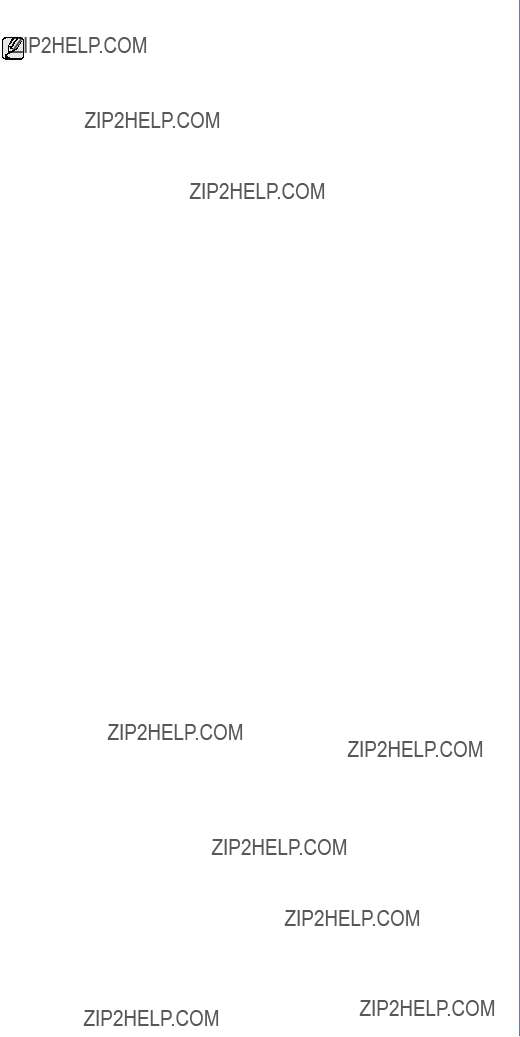
FACSIMILE SPECIFICATIONS
The fax feature may not be supported depending on machines.
a.Standard resolution, MMR(JBIG), Maximum modem speed, Phase ???C??? by
Specifications_ 101
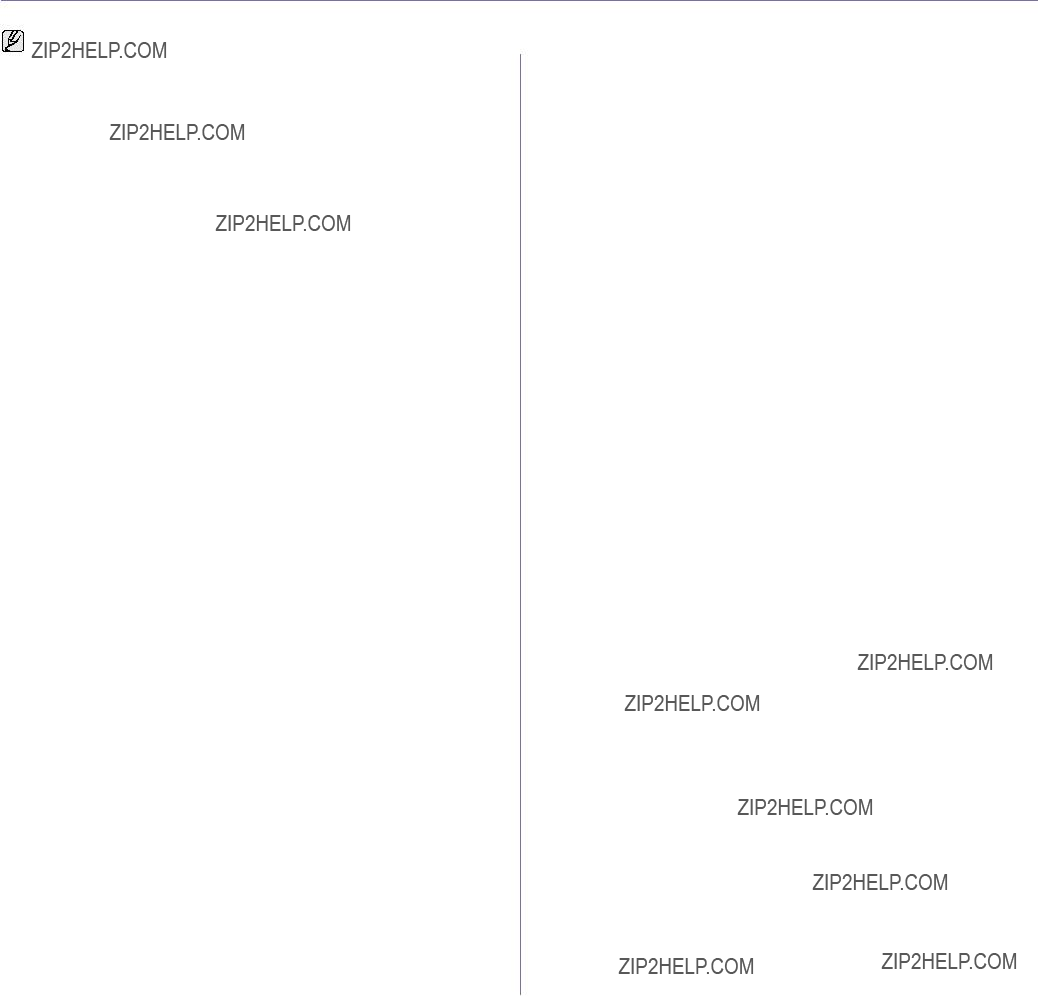
glossary
The following glossary helps you get familiar with the product by understanding the terminologies commonly used with printing as well as mentioned in this user's guide.
ADF
An Automatic Document Feeder (ADF) is a mechanism that will automatically feed an original sheet of paper so that the machine can scan some amount of the paper at once.
AppleTalk
AppleTalk is a proprietary suite of protocols developed by Apple, Inc for computer networking. It was included in the original Macintosh (1984) and is now deprecated by Apple in favor of TCP/IP networking.
BIT Depth
A computer graphics term describing the number of bits used to represent the color of a single pixel in a bitmapped image. Higher color depth gives a broader range of distinct colors. As the number of bits increases, the number of possible colors becomes impractically large for a color map.
BMP
A bitmapped graphics format used internally by the Microsoft Windows graphics subsystem (GDI), and used commonly as a simple graphics file format on that platform.
BOOTP
Bootstrap Protocol. A network protocol used by a network client to obtain its IP address automatically. This is usually done in the bootstrap process of computers or operating systems running on them. The BOOTP servers assign the IP address from a pool of addresses to each client. BOOTP enables 'diskless workstation' computers to obtain an IP address prior to loading any advanced operating system.
CCD
Charge Coupled Device (CCD) is a hardware which enables the scan job. CCD Locking mechanism is also used to hold the CCD module to prevent any damage when you move the machine.
Collation
Collation is a process of printing a
Control Panel
A control panel is a flat, typically vertical, area where control or monitoring instruments are displayed. They are typically found in front of the machine.
Coverage
It is the printing term used for a toner usage measurement on printing. For example, 5% coverage means that an A4 sided paper has about 5% image or text on it. So, if the paper or original has complicated images or lots of text on it, the coverage will be higher and at the same time, a toner usage will be as much as the coverage.
CSV
Comma Separated Values (CSV). A type of file format, CSV is used to exchange data between disparate applications. The file format, as it is used in Microsoft Excel, has become a pseudo standard throughout the industry, even among
DADF
A Duplex Automatic Document Feeder (DADF) is a mechanism that will automatically feed and flip over an original sheet of paper so that the machine can scan on both sides of the paper.
Default
The value or setting that is in effect when taking a printer out of its box state, reset, or initialized.
DHCP
A Dynamic Host Configuration Protocol (DHCP) is a
DIMM
Dual Inline Memory Module (DIMM), a small circuit board that holds memory. DIMM stores all the data within the machine like printing data, received fax data.
DNS
The Domain Name Server (DNS) is a system that stores information associated with domain names in a distributed database on networks, such as the Internet.
Dot Matrix Printer
A dot matrix printer refers to a type of computer printer with a print head that runs back and forth on the page and prints by impact, striking an
DPI
Dots Per Inch (DPI) is a measurement of resolution that is used for scanning and printing. Generally, higher DPI results in a higher resolution, more visible detail in the image, and a larger file size.
DRPD
Distinctive Ring Pattern Detection. Distinctive Ring is a telephone company service which enables a user to use a single telephone line to answer several different telephone numbers.
Duplex
A mechanism that will automatically flip over a sheet of paper so that the machine can print (or scan) on both sides of the paper. A printer equipped with a Duplex can print
Duty Cycle
Duty cycle is the page quantity which does not affect printer performance for a month. Generally the printer has the lifespan limitation such as pages per year. The lifespan means the average capacity of
ECM
Error Correction Mode (ECM) is an optional transmission mode built into Class 1 fax machines or fax modems. It automatically detects and corrects errors in the fax transmission process that are sometimes caused by telephone line noise.
Emulation
Emulation is a technique of one machine obtaining the same results as another.
102 _Glossary

An emulator duplicates the functions of one system with a different system, so that the second system behaves like the first system. Emulation focuses on exact reproduction of external behavior, which is in contrast to simulation, which concerns an abstract model of the system being simulated, often considering its internal state.
Ethernet
Ethernet is a
EtherTalk
A suite of protocols developed by Apple Computer for computer networking. It was included in the original Macintosh (1984) and is now deprecated by Apple in favor of TCP/IP networking.
FDI
Foreign Device Interface (FDI) is a card installed inside the machine to allow a third party device such as a coin operated device or a card reader. Those devices allow the
FTP
A File Transfer Protocol (FTP) is a commonly used protocol for exchanging files over any network that supports the TCP/IP protocol (such as the Internet or an intranet).
Fuser Unit
The part of a laser printer that melts the toner onto the print media. It consists of a hot roller and a
Gateway
A connection between computer networks, or between a computer network and a telephone line. It is very popular, as it is a computer or a network that allows access to another computer or network.
Grayscale
A shades of gray that represent light and dark portions of an image when color images are converted to grayscale; colors are represented by various shades of gray.
Halftone
An image type that simulates grayscale by varying the number of dots. Highly colored areas consist of a large number of dots, while lighter areas consist of a smaller number of dots.
HDD
Hard Disk Drive (HDD), commonly referred to as a hard drive or hard disk, is a
IEEE
The Institute of Electrical and Electronics Engineers (IEEE) is an international
IEEE 1284
The 1284 parallel port standard was developed by the Institute of Electrical and Electronics Engineers (IEEE). The term
Intranet
A private network that uses Internet Protocols, network connectivity, and possibly the public telecommunication system to securely share part of an organization's information or operations with its employees.
Sometimes the term refers only to the most visible service, the internal website.
IP address
An Internet Protocol (IP) address is a unique number that devices use in order to identify and communicate with each other on a network utilizing the Internet Protocol standard.
IPM
The Images Per Minute (IPM) is a way of measuring the speed of a printer. An IPM rate indicates the number of
IPP
The Internet Printing Protocol (IPP) defines a standard protocol for printing as well as managing print jobs, media size, resolution, and so forth. IPP can be used locally or over the Internet to hundreds of printers, and also supports access control, authentication, and encryption, making it a much more capable and secure printing solution than older ones.
IPX/SPX
IPX/SPX stands for Internet Packet Exchange/Sequenced Packet Exchange. It is a networking protocol used by the Novell NetWare operating systems. IPX and SPX both provide connection services similar to TCP/IP, with the IPX protocol having similarities to IP, and SPX having similarities to TCP. IPX/SPX was primarily designed for local area networks (LANs), and is a very efficient protocol for this purpose (typically its performance exceeds that of TCP/IP on a LAN).
ISO
The International Organization for Standardization (ISO) is an international
The International Telecommunication Union is an international organization established to standardize and regulate international radio and telecommunications. Its main tasks include standardization, allocation of the radio spectrum, and organizing interconnection arrangements between different countries to allow international phone calls. A
Standardized test chart published by
JBIG
Joint
JPEG
Joint Photographic Experts Group (JPEG) is a most commonly used standard method of lossy compression for photographic images. It is the format used for storing and transmitting photographs on the World Wide Web.
LDAP
The Lightweight Directory Access Protocol (LDAP) is a networking protocol for querying and modifying directory services running over TCP/ IP.
Glossary_ 103

LED
A
MAC address
Media Access Control (MAC) address is a unique identifier associated with a network adapter. MAC address is a unique
MFP
Multi Function Peripheral (MFP) is an office machine that includes the following functionality in one physical body, so as to have a printer, a copier, a fax, a scanner and etc.
MH
Modified Huffman (MH) is a compression method for decreasing the amount of data that needs to be transmitted between the fax machines to transfer the image recommended by
MMR
Modified Modified READ (MMR) is a compression method recommended by
Modem
A device that modulates a carrier signal to encode digital information, and also demodulates such a carrier signal to decode transmitted information.
MR
Modified Read (MR) is a compression method recommended by
NetWare
A network operating system developed by Novell, Inc. It initially used cooperative multitasking to run various services on a PC, and the network protocols were based on the archetypal Xerox XNS stack. Today NetWare supports TCP/IP as well as IPX/SPX.
OPC
Organic Photo Conductor (OPC) is a mechanism that makes a virtual image for print using a laser beam emitted from a laser printer, and it is usually green or gray colored and a cylinder shaped.
An exposing unit of a drum is slowly worn away by its usage of the printer, and it should be replaced appropriately since it gets scratches from grits of a paper.
Originals
The first example of something, such as a document, photograph or text, etc, which is copied, reproduced or translated to produce others, but which is not itself copied or derived from something else.
OSI
Open Systems Interconnection (OSI) is a model developed by the International Organization for Standardization (ISO) for communications. OSI offers a standard, modular approach to network design that divides the required set of complex functions into manageable,
PABX
A private automatic branch exchange (PABX) is an automatic telephone switching system within a private enterprise.
PCL
Printer Command Language (PCL) is a Page Description Language (PDL) developed by HP as a printer protocol and has become an industry standard. Originally developed for early inkjet printers, PCL has been released in varying levels for thermal, matrix printer, and page printers.
Portable Document Format (PDF) is a proprietary file format developed by Adobe Systems for representing two dimensional documents in a device independent and resolution independent format.
PostScript
PostScript (PS) is a page description language and programming language used primarily in the electronic and desktop publishing areas. - that is run in an interpreter to generate an image.
Printer Driver
A program used to send commands and transfer data from the computer to the printer.
Print Media
The media like paper, envelopes, labels, and transparencies which can be used on a printer, a scanner, a fax or, a copier.
PPM
Pages Per Minute (PPM) is a method of measurement for determining how fast a printer works, meaning the number of pages a printer can produce in one minute.
PRN file
An interface for a device driver, this allows software to interact with the device driver using standard input/output system calls, which simplifies many tasks.
Protocol
A convention or standard that controls or enables the connection, communication, and data transfer between two computing endpoints.
PS
See PostScript.
PSTN
The
Resolution
The sharpness of an image, measured in Dots Per Inch (DPI). The higher the dpi, the greater the resolution.
SMB
Server Message Block (SMB) is a network protocol mainly applied to share files, printers, serial ports, and miscellaneous communications between nodes on a network. It also provides an authenticated Inter- process communication mechanism.
SMTP
Simple Mail Transfer Protocol (SMTP) is the standard for
104 _Glossary

Subnet Mask
The subnet mask is used in conjunction with the network address to determine which part of the address is the network address and which part is the host address.
TCP/IP
The Transmission Control Protocol (TCP) and the Internet Protocol (IP); the set of communications protocols that implement the protocol stack on which the Internet and most commercial networks run.
TCR
Transmission Confirmation Report (TCR) provides details of each transmission such as job status, transmission result and number of pages sent. This report can be set to print after each job or only after failed transmissions.
TIFF
Tagged Image File Format (TIFF) is a
Toner Cartridge
A kind of bottle within a machine like printer which contains toner. Toner is a powder used in laser printers and photocopiers, which forms the text and images on the printed paper. Toner can be melted by the heat of the fuser, causing it to bind to the fibers in the paper.
TWAIN
An industry standard for scanners and software. By using a TWAIN- compliant scanner with a
UNC Path
Uniform Naming Convention (UNC) is a standard way to access network shares in Window NT and other Microsoft products. The format of a UNC path is: \\<servername>\<sharename>\<Additional directory>
URL
Uniform Resource Locator (URL) is the global address of documents and resources on the Internet. The first part of the address indicates what protocol to use, the second part specifies the IP address or the domain name where the resource is located.
USB
Universal Serial Bus (USB) is a standard that was developed by the USB Implementers Forum, Inc., to connect computers and peripherals. Unlike the parallel port, USB is designed to concurrently connect a single computer USB port to multiple peripherals.
Watermark
A watermark is a recognizable image or pattern in paper that appears lighter when viewed by transmitted light. Watermarks were first introduced in Bologna, Italy in 1282; they have been used by papermakers to identify their product, and also on postage stamps, currency, and other government documents to discourage counterfeiting.
WIA
Windows Imaging Architecture (WIA) is an imaging architecture that is originally introduced in Windows Me and Windows XP. A scan can be initiated from within these operating systems by using a
Glossary_ 105

index
A
accessories
installing
hard disk 96
wireless network interface card 94
Address Book
group dial numbers 58 speed buttons 57 speed dial numbers 57
ADF rubber pad, replace 69 ADF, load 32
adjustment
altitude 28
alarm sound 29
Ans/Fax mode, receiving mode 53
C
characters, enter 29 cleaning
inside 63 outside 63 scan unit 65
clock mode 29
collation, special copy 40 control panel 20
copying
default setting, change 40 edge erase 42
ID card copy 40 margin shift 41 original type 39 poster 41
time out, set 42
D
date and time, set 29 default mode, change 29 delayed fax 54
106_Index
demo page, print 25
display language, change 28 driver
installation 27
DRPD (Distinctive Ring Pattern Detection)
E
edge erase, special copy 42
F
fax header, set 51
Fax mode, receiving mode 53 fax number, set 51
faxing
default settings, change 57 delayed faxes 54
fax setup 56 forwarding faxes 55 Multiple Send faxes 54 priority faxes 55 receiving faxes 52 sending faxes 52
Forwarding 55
G
Group dial numbers, set 58
H
hard disk
I
ID card, special copy 40 ID copy 20, 21 installing accessories
hard disk 96
network interface card 94
J
jam
clearing paper from the tray1 73 tips for avoiding paper jams 71
jam, clear
document 71
job timeout, set 30
K
key sound 29
L
LED
Status 22
Linux problems 88 loading originals
ADF 32
scanner glass 32
M
machine ID, set 51 Maintenance
maintenance parts 69 toner cartridge 65
margin shift, special copy 41 memory module
memory, clear 63 Multiple Sned faxes 54
N
network
setting up 25
network interface card, install 94
O
optional tray 69, 91 originals
P
paper
changing the size 36 clearing jam 73
loading in the
paper tray, set
paper type
setting 38
PostScript
problems 87
power save mode 30
print quality problems, solve 83 printing
USB memory 60
priority fax 55 problem, solve
Network Scan 86 paper feeding 81 printing quality 83 scanning 86 Windows 87
R
receiving a fax
in Ans/Fax mode 53 in DRPD mode 53 in Fax mode 53
in Secure Receiving mode 53 in Tel mode 53
in the memory 49
receiving modes 52 redialing
replacing
ADF rubber pad 69
replacing components
toner cartridge 66
replacing, toner cartridge 67 reports, print 62
ringer 29

contact SAMSUNG worldwide
If you have any comments or questions regarding Samsung products, contact the Samsung customer care center.
108 _Contact SAMSUNG worldwide
Contact SAMSUNG worldwide_ 109
?? 2008 Samsung Electronics Co., Ltd. All rights reserved.
This user???s guide is provided for information purposes only. All information included herein is subject to change without notice. Samsung Electronics is not responsible for any direct or indirect damages, arising from or related to use of this user???s guide.
???Samsung and Samsung logo are trademarks of Samsung Electronics Co., Ltd.
???PCL and PCL 6 are trademarks of
???Microsoft, Windows, and Windows Vista are either registered trademarks or trademarks of Microsoft Corporation.
???PostScript 3 is a trademark of Adobe System, Inc.
???UFST?? and MicroType??? are registered trademarks of Monotype Imaging Inc.
???TrueType, LaserWriter and Macintosh are trademarks of Apple Computer, Inc.
???All other brand or product names are trademarks of their respective companies or organizations.

Rev. 3.00


 Samsung Printer
Samsung Printer

 Software section
Software section
SOFTWARE SECTION
CONTENTS
Chapter 1: INSTALLING PRINTER SOFTWARE IN WINDOWS
Chapter 2: BASIC PRINTING
Chapter 3: ADVANCED PRINTING
2
3
4
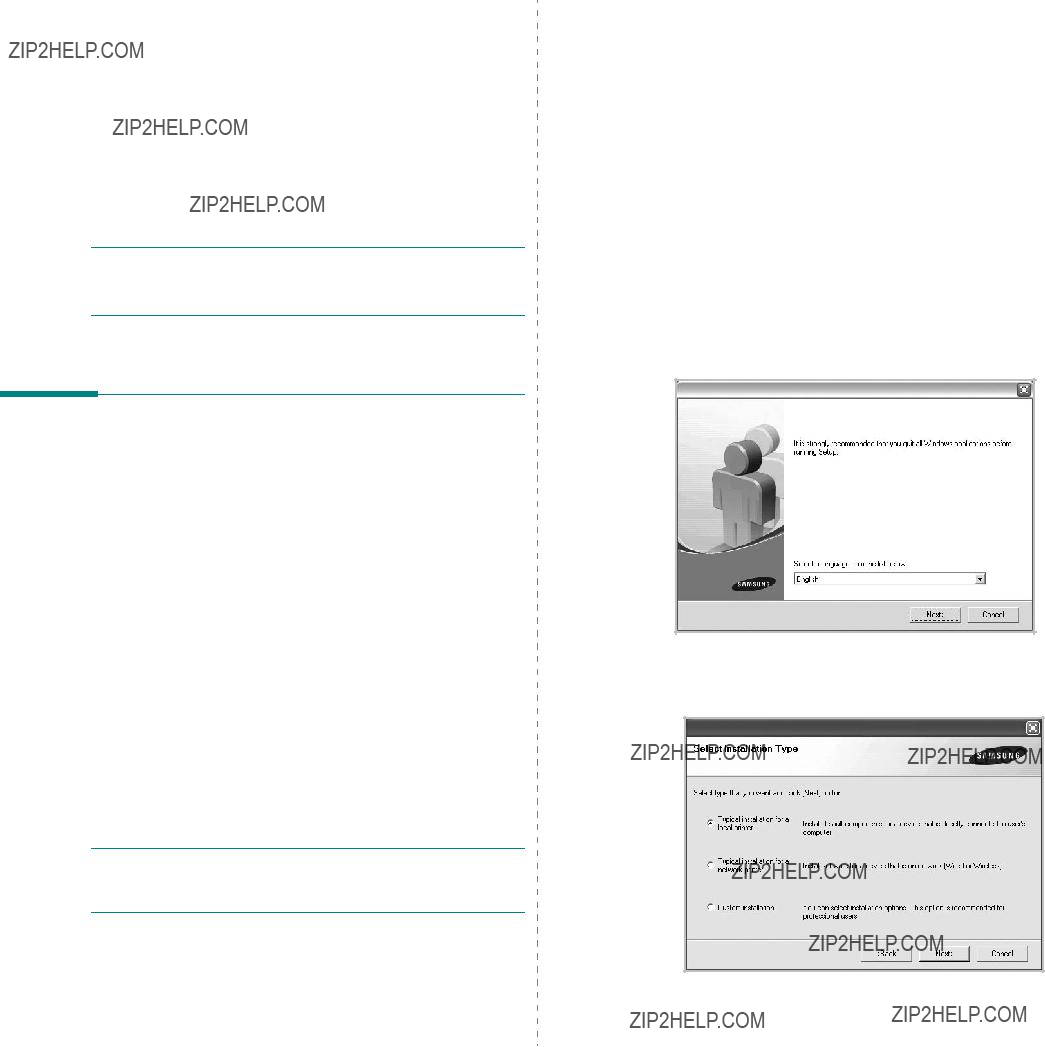
1 Installing Printer
Software in Windows
This chapter includes:
???Installing Printer Software
???Reinstalling Printer Software
???Removing Printer Software
???Installing mono printer driver
NOTE: The following procedure is based on Windows XP, for other operating systems, refer to the corresponding Windows user's guide or online help.
Installing Printer Software
You can install the printer software for local printing or network printing. To install the printer software on the computer, perform the appropriate installation procedure depending on the printer in use.
A printer driver is software that lets your computer communicate with your printer. The procedure to install drivers may differ depending on the operating system you are using.
All applications should be closed on your PC before beginning installation.
Installing Software for Local Printing
A local printer is a printer directly attached to your computer using the printer cable supplied with your printer, such as a USB or parallel cable. If your printer is attached to a network, skip this step and go to ???Installing Software for Network Printing??? on page 8.
You can install the printer software using the typical or custom method.
NOTE: If the ???New Hardware Wizard??? window appears during the installation procedure, click  in the upper right corner of the box to close the window, or click Cancel.
in the upper right corner of the box to close the window, or click Cancel.
Typical Installation
This is recommended for most users. All components necessary for printer operations will be installed.
1Make sure that the printer is connected to your computer and powered on.
2Insert the supplied
The
If the installation window does not appear, click Start and then Run. Type X:\Setup.exe, replacing ???X??? with the letter which represents your drive and click OK.
If you use Windows Vista, click Start ??? All programs ??? Accessories ??? Run, and type X:\Setup.exe.
If the AutoPlay window appears in Windows Vista, click
Run Setup.exe in Install or run program field, and click Continue in the User Account Control window.
3Click Next.
??? If necessary, select a language from the
4Select Typical installation for a local printer. Click Next.
5
Installing Printer Software in Windows

NOTE: If your printer is not already connected to the computer, the following window will appear.
???After connecting the printer, click Next.
???If you don???t want to connect the printer at this time, click Next, and No on the following screen. Then the installation will start and a test page will not be printed at the end of the installation.
???The installation window that appears in this User???s Guide may differ depending on the printer and interface in use.
5After the installation is finished, a window asking you to print a test page appears. If you choose to print a test page, select the checkbox and click Next.
Otherwise, just click Next and skip to step 7.
6If the test page prints out correctly, click Yes. If not, click No to reprint it.
7To register yourself as a user of Samsung Printers in order to receive information from Samsung, select the checkbox and click Finish. You are now sent to the Samsung web site.
Otherwise, just click Finish.
Custom Installation
You can choose individual components to install.
1Make sure that the printer is connected to your computer and powered on.
2Insert the supplied
The
If the installation window does not appear, click Start and then Run. Type X:\Setup.exe, replacing ???X??? with the letter which represents your drive and click OK.
If you use Windows Vista, click Start ??? All programs ??? Accessories ??? Run, and type X:\Setup.exe.
If the AutoPlay window appears in Windows Vista, click
Run Setup.exe in Install or run program field, and click Continue in the User Account Control window.
3Click Next.
??? If necessary, select a language from the
4 Select Custom installation. Click Next.
NOTE: After setup is complete, if your printer driver doesn???t work properly, reinstall the printer driver. See ???Reinstalling Printer Software??? on page 11.
6
Installing Printer Software in Windows

5 Select your printer and click Next.
6 Select the components to be installed and click Next.
NOTE: If your printer is not already connected to the computer, the following window will appear.
???After connecting the printer, click Next.
???If you don???t want to connect the printer at this time, click Next, and No on the following screen. Then the installation will start and a test page will not be printed at the end of the installation.
???The installation window that appears in this User???s Guide may differ depending on the printer and interface in use.
NOTE: You can change the desired installation folder by clicking [Browse].
7After the installation is finished, a window asking you to print a test page appears. If you choose to print a test page, select the checkbox and click Next.
Otherwise, just click Next and skip to step 9.
8If the test page prints out correctly, click Yes. If not, click No to reprint it.
9To register yourself as a user of Samsung Printers in order to receive information from Samsung, select the checkbox and click Finish. You are now sent to the Samsung web site.
Otherwise, just click Finish.
7
Installing Printer Software in Windows
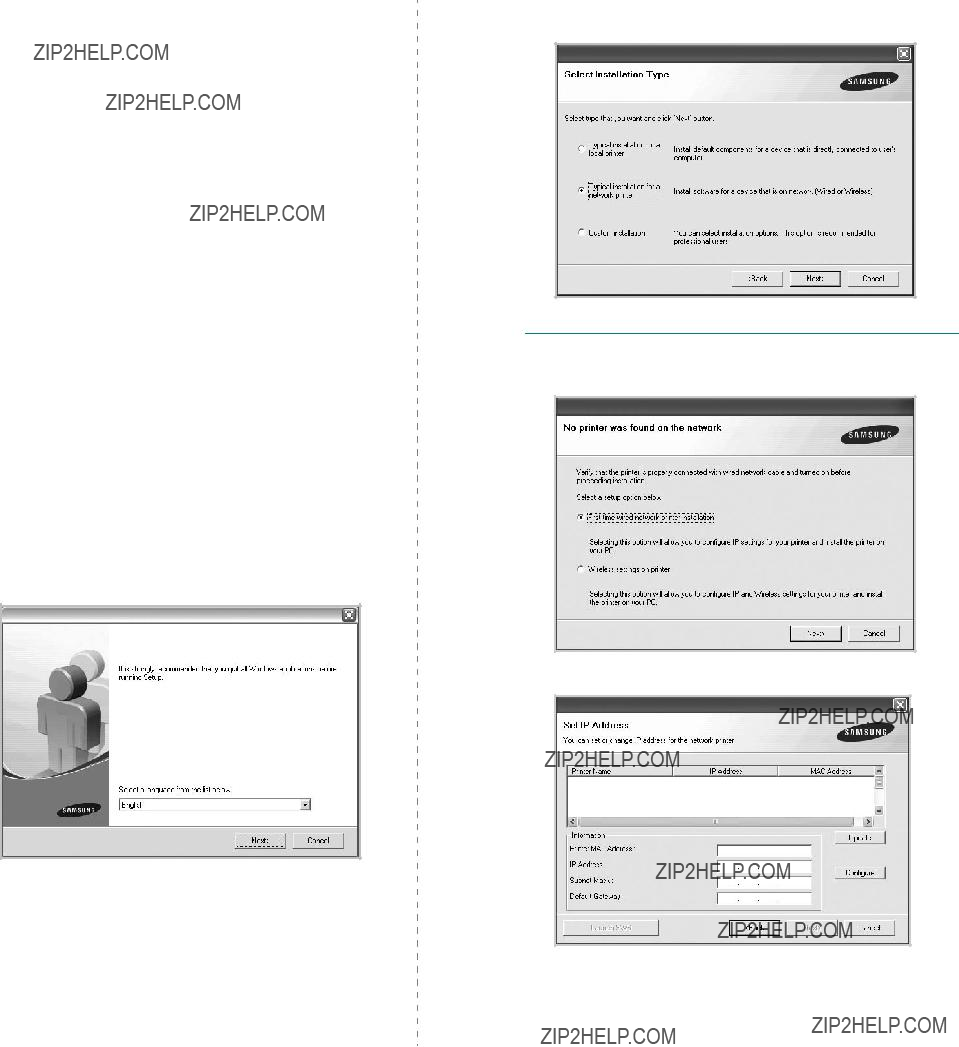
Installing Software for Network Printing
When you connect your printer to a network, you must first configure the TCP/IP settings for the printer. After you have assigned and verified the TCP/IP settings, you are ready to install the software on each computer on the network.
You can install the printer software using the typical or custom method.
Typical Installation
This is recommended for most users. All components necessary for printer operations will be installed.
1Make sure that the printer is connected to your network and powered on. For details about connecting to the network, see the supplied printer???s User???s Guide.
2Insert the supplied
The
If the installation window does not appear, click Start and then Run. Type X:\Setup.exe, replacing ???X??? with the letter which represents your drive and click OK.
If you use Windows Vista, click Start ??? All programs ??? Accessories ??? Run, and type X:\Setup.exe.
If the AutoPlay window appears in Windows Vista, click
Run Setup.exe in Install or run program field, and click Continue in the User Account Control window.
3Click Next.
??? If necessary, select a language from the
4Select Typical installation for a network printer. Click Next.
NOTE: If your printer is not connected to the network, the following window will appear. Select a setup option you want, click Next.
Then the Set IP Address window appears. Do as follows:
1.Select a printer to be set with a specific IP address from the list.
8
Installing Printer Software in Windows

2.Configure an IP address, subnet mask, and gateway for the printer manually and click Configure to set the specific IP address for the network printer.
3.Click Next, and go to step 6.
You can also set the network printer via SyncThruTM Web Service, an embedded web server. Click Launch SWS on Set IP Address window. Your machine???s embedded website opens.
5The list of printers available on the network appears. Select the printer you want to install from the list and then click Next.
???If you do not see your printer on the list, click Update to refresh the list, or select Add TCP/IP Port to add your printer to the network. To add the printer to the network, enter the port name and the IP address for the printer.
To verify your printer???s IP address or the MAC address, print a Network Configuration page in machine.
???To find a shared network printer (UNC Path), select Shared Printer [UNC] and enter the shared name manually or find a shared printer by clicking the Browse button.
NOTE: If you cannot find your machine in network, please turn off the firewall and click Update.
For Windows operating system, click Start ??? Control Panel and start windows firewall, and set this option unactivated. For other operating system, refer to its
6After the installation is finished, a window appears asking you to print a test page and to register yourself as a user of Samsung Printers in order to receive information from Samsung. If you so desire, select the corresponding checkbox(es) and click Finish.
Otherwise, just click Finish.
NOTE: After setup is complete, if your printer driver doesn???t work properly, reinstall the printer driver. See ???Reinstalling Printer Software??? on page 11.
Custom Installation
You can choose individual components to install and set a specific IP address.
1Make sure that the printer is connected to your network and powered on. For details about connecting to the network, see the supplied printer???s User???s Guide.
2Insert the supplied
The
If the installation window does not appear, click Start and then Run. Type X:\Setup.exe, replacing ???X??? with the letter which represents your drive and click OK.
If you use Windows Vista, click Start ??? All programs ??? Accessories ??? Run, and type X:\Setup.exe.
If the AutoPlay window appears in Windows Vista, click
Run Setup.exe in Install or run program field, and click Continue in the User Account Control window.
9
Installing Printer Software in Windows

3 Click Next.
??? If necessary, select a language from the
4 Select Custom installation. Click Next.
5The list of printers available on the network appears. Select the printer you want to install from the list and then click Next.
???If you do not see your printer on the list, click Update to refresh the list, or select Add TCP/IP Port to add your printer to the network. To add the printer to the network, enter the port name and the IP address for the
printer.
To verify your printer???s IP address or the MAC address, print a Network Configuration page in machine.
???To find a shared network printer (UNC Path), select Shared Printer [UNC] and enter the shared name manually or find a shared printer by clicking the Browse button.
NOTE: If you cannot find your machine in network, please turn off the firewall and click Update.
For Windows operating system, click Start ??? Control Panel and start windows firewall, and set this option unactivated. For other operating system, refer to its
TIP: If you want to set a specific IP address on a specific network printer, click the Set IP Address button. The Set IP Address window appears. Do as follows:
a.Select a printer to be set with a specific IP address from the list.
b.Configure an IP address, subnet mask, and gateway for the printer manually and click Configure to set the specific IP address for the network printer.
c.Click Next.
You can also set the network printer via SyncThruTM Web Service, an embedded web server. Click Launch SWS on Set IP Address window. Your machine???s embedded website opens.
6Select the components to be installed. After selecting the components, the following window appears. You can also change the printer name, set the printer to be shared on
10
Installing Printer Software in Windows

the network, set the printer as the default printer, and change the port name of each printer. Click Next.
To install this software on a server, select the Setting up this printer on a server checkbox.
7After the installation is finished, a window appears asking you to print a test page and to register yourself as a user of Samsung Printers in order to receive information from Samsung. If you so desire, select the corresponding checkbox(es) and click Finish.
Otherwise, just click Finish.
NOTE: After setup is complete, if your printer driver doesn???t work properly, reinstall the printer driver. See ???Reinstalling Printer Software??? on page 11.
Reinstalling Printer Software
You can reinstall the software if installation fails.
1Start Windows.
2From the Start menu select Programs or All Programs ??? your printer driver name ??? Maintenance.
3Select Repair and click Next.
4The list of printers available on the network appears. Select the printer you want to install from the list and then click Next.
???If you do not see your printer on the list, click Update to refresh the list, or select Add TCP/IP Port to add your printer to the network. To add the printer to the network, enter the port name and the IP address for the printer.
???To find a shared network printer (UNC Path), select Shared Printer [UNC] and enter the shared name manually or find a shared printer by clicking the Browse button.
You will see a component list so that you can reinstall any item individually.
NOTE: If your printer is not already connected to the computer, the following window will appear.
11
Installing Printer Software in Windows

???After connecting the printer, click Next.
???If you don???t want to connect the printer at this time, click Next, and No on the following screen. Then the installation will start and a test page will not be printed at the end of the installation.
???The reinstallation window that appears in this User???s Guide may differ depending on the printer and interface in use.
5Select the components you want to reinstall and click
Next.
If you installed the printer software for local printing and you select your printer driver name, the window asking you to print a test page appears. Do as follows:
a.To print a test page, select the check box and click
Next.
b.If the test page prints out correctly, click Yes. If it doesn???t, click No to reprint it.
6When the reinstallation is done, click Finish.
Removing Printer Software
1Start Windows.
2From the Start menu select Programs or All Programs ??? your printer driver name ??? Maintenance.
3Select Remove and click Next.
You will see a component list so that you can remove any item individually.
4Select the components you want to remove and then click
Next.
5When your computer asks you to confirm your selection, click Yes.
The selected driver and all of its components are removed from your computer.
After the software is removed, click Finish.
Installing mono printer driver
This printer features a monochrome only printer. This mono driver limits output to th black toner. You must install the mono driver on your computer. Following steps guide you through the step by step installation process.
1Make sure that the printer is connected to your computer
and powered on. Or your computer and printer are connected to the network.
2Insert the supplied
3Click Cancel.
If the confirmation window appears, click Finish.
4Click Start ??? Printers and Faxes.
5Select Add Printer.
6When Add Printer Wizard appears, click Next.
7Select Local printer attached to this computer, and
Automatically detect and install my Plug and Play printer, then click Next. Go to step 13.
If your computer does not find the printer, then follow the next step.
8Select Next in the Select a Printer Port window.
9In the Select a Printer Port window, select Have Disk....
10Click Browse to find a mono driver for your printer. ex) Windows XP 32 bit
Select
11Select ***.inf file and click Open.
12Click OK in the Install From Disk window.
12
Installing Printer Software in Windows

13Select a mono driver in the Printers field, and click Next.
NOTE: If you have installed a mono driver before, then the Use Existing Driver window. Select as the window explains, and click Next. Also, depending on your computer configuration, the printer sharing window or the print the test page window may appear; make the appropriate selection.
14Enter your printer name, and click Next.
15Click Finish to start installing a mono printer driver.
16NOTE: If your printer is connected to a network, go to printer's Properties and select the Ports tab, then click
Add Portand Standard TCP/IP Port, and create a new port to connect to the printer. To create a new port, follow the procedure laid out in the wizard window.
13
Installing Printer Software in Windows

2 Basic Printing
This chapter explains the printing options and common printing tasks in Windows.
This chapter includes:
???Printing a Document
???Printing to a file (PRN)
???Printer Settings
-Layout Tab
-Paper Tab
-Graphics Tab
-Extras Tab
-About Tab
-Printer Tab
-Using a Favorite Setting
-Using Help
Printing a Document
NOTES:
???Your printer driver Properties window that appears in this User???s Guide may differ depending on the printer in use. However the composition of the printer properties window is similar.
???Check the Operating System(s) that are compatible with your printer. Please refer to the OS Compatibility section of Printer Specifications in your Printer User???s Guide.
???If you need to know the exact name of your printer, you can check the supplied
???When you select an option in printer properties, you may see
an exclamation mark or mark. An exclamation mark means you can select that certain option but it is not
mark or mark. An exclamation mark means you can select that certain option but it is not
recommended, and mark means you cannot select that option due to the machine???s setting or environment.
The following procedure describes the general steps required for printing from various Windows applications. The exact steps for printing a document may vary depending on the application program you are using. Refer to the User???s Guide of your software application for the exact printing procedure.
1Open the document you want to print.
2Select Print from the File menu. The Print window is
displayed. It may look slightly different depending on your application.
The basic print settings are selected within the Print window. These settings include the number of copies and print range.
Make sure that your printer is selected.
3Select your printer driver from the Name
To take advantage of the printer features provided by your printer driver, click Properties or Preferences in the application???s Print window. For details, see ???Printer Settings??? on page 15.
If you see Setup, Printer, or Options in your Print window, click it instead. Then click Properties on the next screen.
Click OK to close the printer properties window.
4To start the print job, click OK or Print in the Print window.
Printing to a file (PRN)
You will sometimes need to save the print data as a file for your purpose.
To create a file:
1 Check the Print to file box at the Print window.
2Select the folder and assign a name of the file and then click OK.
14 Basic Printing
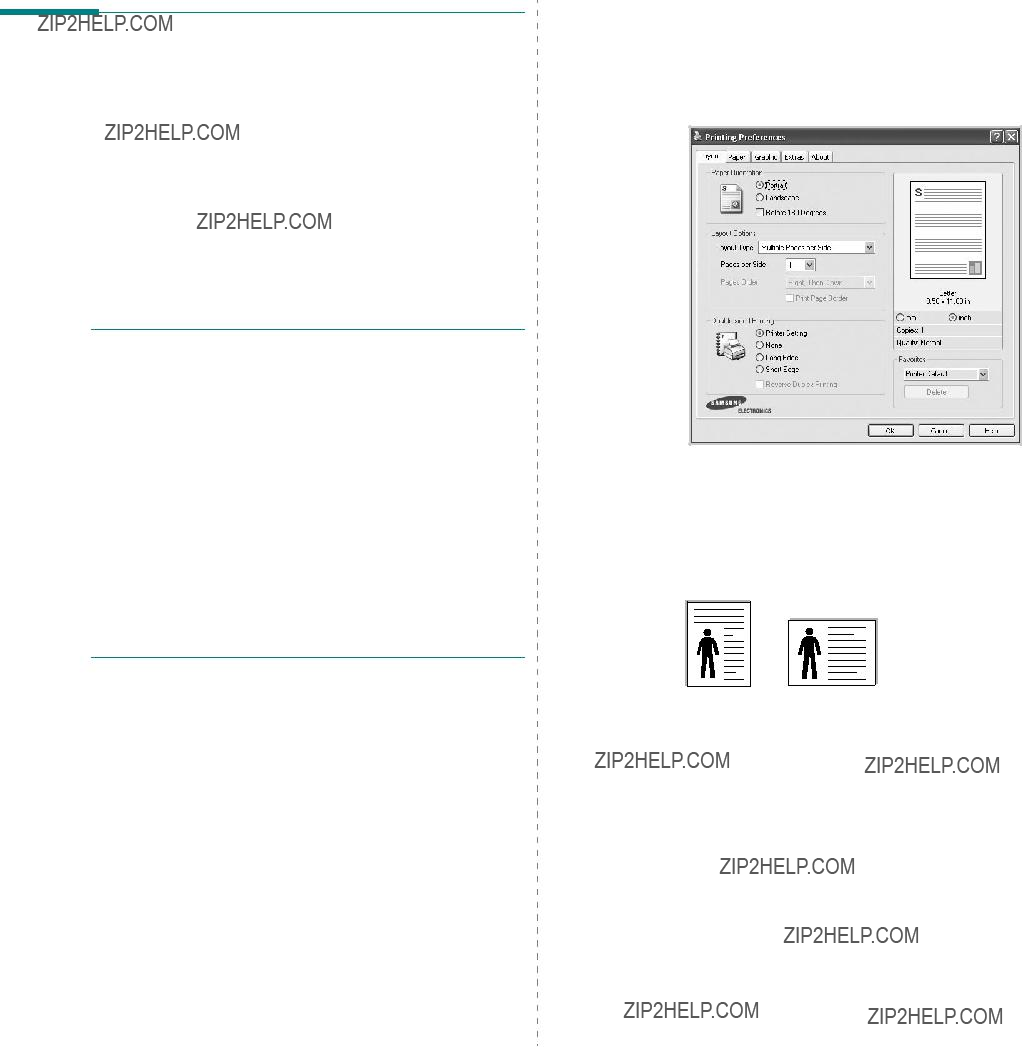
Printer Settings
You can use the printer properties window, which allows you to access all of the printer options you need when using your printer. When the printer properties are displayed, you can review and change the settings needed for your print job.
Your printer properties window may differ, depending on your operating system. This Software User???s Guide shows the Properties window for Windows XP.
Your printer driver Properties window that appears in this User???s Guide may differ depending on the printer in use.
If you access printer properties through the Printers folder, you can view additional
NOTES:
???Most Windows applications will override settings you specify in the printer driver. Change all print settings available in the software application first, and change any remaining settings using the printer driver.
???The settings you change remain in effect only while you are using the current program. To make your changes permanent, make them in the Printers folder.
???The following procedure is for Windows XP. For other Windows OS, refer to the corresponding Windows User's Guide or online help.
1.Click the Windows Start button.
2.Select Printers and Faxes.
3.Select your printer driver icon.
4.
Printing Preferences.
5.Change the settings on each tab, click OK.
Layout Tab
The Layout tab provides options to adjust how the document appears on the printed page. The Layout Options includes
Multiple Pages per Side, Poster Printing and Booklet Printing. See ???Printing a Document??? on page 14 for more information on accessing printer properties.
Paper Orientation
Paper Orientation allows you to select the direction in which information is printed on a page.
???Portrait prints across the width of the page, letter style.
???Landscape prints across the length of the page, spreadsheet style.
???Rotate allows you to rotate the page the selected degrees.
 Portrait
Portrait  Landscape
Landscape
Layout Options
Layout Options allows you to select advanced printing options. You can choose Multiple Pages per Side and Poster Printing.
???For details, see ???Printing Multiple Pages on One Sheet of Paper
???For details, see ???Printing Posters??? on page 20
???For details, see ???Printing Booklets??? on page 20
??? For details, see ???Printing on Both Sides of Paper??? on page 21.
15 Basic Printing

Paper Tab
Use the following options to set the basic paper handling specifications when you access the printer properties. See ???Printing a Document??? on page 14 for more information on accessing printer properties.
Click the Paper tab to access various paper properties.
Copies
Copies allows you to choose the number of copies to be printed. You can select 1 to 999 copies.
Paper Options
Size
Size allows you to set the size of paper you loaded in the tray. If the required size is not listed in the Size box, click Custom. When the Custom Paper Setting window appears, set the paper size and click OK. The setting appears in the list so that you can select it.
Source
Make sure that Source is set to the corresponding paper tray. Use
If the paper source is set to Auto Selection, the printer automatically picks up print material in the following tray order: Manual Tray or
Type
Set Type to correspond to the paper loaded in the tray from which you want to print. This will let you get the best quality printout. If not, print quality may not be acheived as you want.
???Thin Paper: Less than 19 lb (70 g/m2) thin paper.
???Thick Paper: 24 lb to 32 lb (90~120 g/m2) thick paper.
???Bond Paper: When you use the bond paper, select this option.
???Cotton Paper: 20 lb to 24 lb (75~90 g/m2) cotton paper such as Gilbert 25 % and Gilbert 100 %.
???Archive Paper: When you need to keep
???Plain Paper: Normal plain paper. Select this type if your printer is monochrome and printing on the 16 lb (60 g/m2) cotton paper.
???Recycled Paper: 20 lb to 24 lb (75~90 g/m2) recycled paper.
???Color Paper: 20 lb to 24 lb (75~90 g/m2) color- backgrounded paper.
First Page
This property allows you to print the first page using a different paper type from the rest of the document. You can select the paper source for the first page.
For example, load thick stock for the first page into the Multi- purpose Tray, and plain paper into Tray n. Then, select Tray n in the Source option and
Scaling Printing
Scaling Printing allows you to automatically or manually scale your print job on a page. You can choose from None, Reduce/ Enlarge, and Fit to Page.
???For details, see ???Printing a Reduced or Enlarged Document??? on page 21.
???For details, see ???Fitting Your Document to a Selected Paper Size??? on page 21.
16 Basic Printing
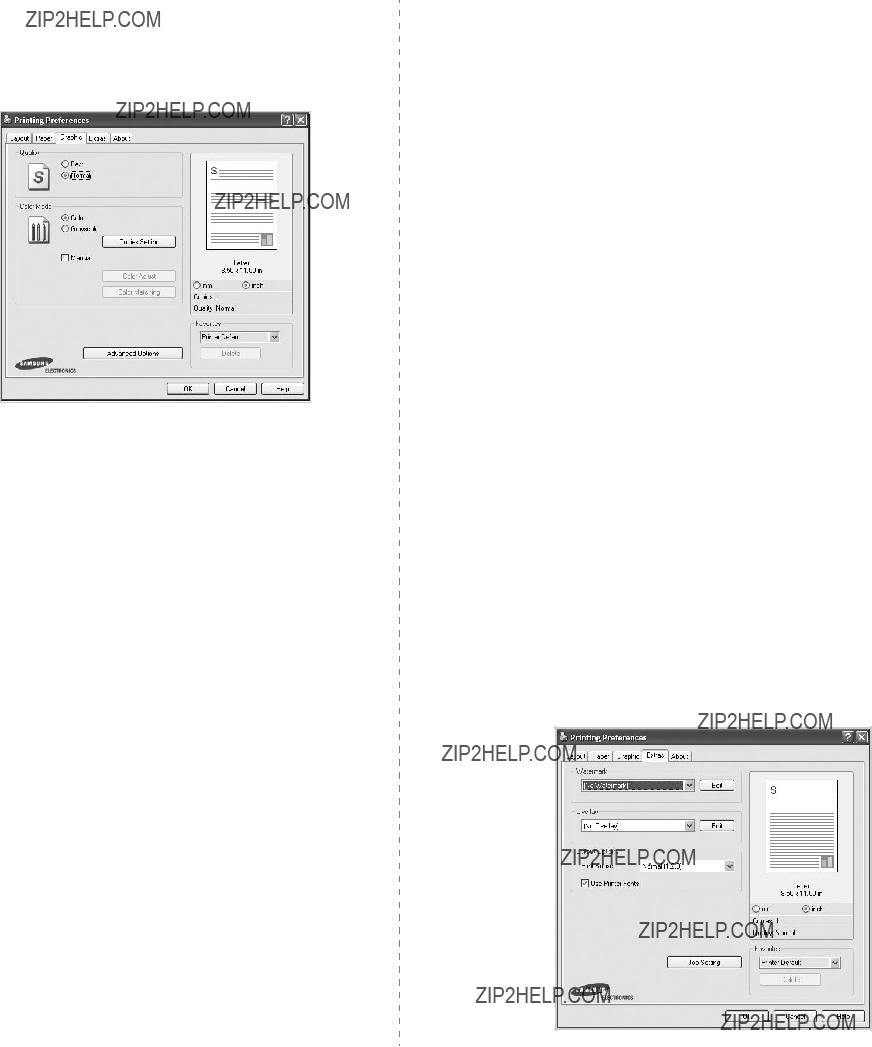
Graphics Tab
Use the following Graphic options to adjust the print quality for your specific printing needs. See ???Printing a Document??? on page 14 for more information on accessing printer properties.
Click the Graphic tab to display the properties shown below.
Quality
The Quality options you can select may vary depending on your printer model. The higher the setting, the sharper the
clarity of printed characters and graphics. The higher setting also may increase the time it takes to print a document.
Color Mode
You can choose color options. Setting to Color typically produces the best possible print quality for color documents. If you want to print a color document in grayscale, select Grayscale. If you want to adjust the color options manually, select Manual and click the Color Adjust or Color Matching button.
???Copies Setting : In order to use this option, first you need to set total number of copies from Paper tab. When you make several copies, and if you want to print some copies in color and some in grayscale, use this option and select the number of copies in grayscale.
???Color Adjust : You can adjust the appearance of images by
changing the settings in the Levels option.
???Color Matching : You can adjust the appearance of images by changing the settings in the Settings option.
Advanced Options
You can set advanced settings by clicking the Advanced Options button.
???Raster Compression: This option determines the compression level of images for transferring data from a computer to a printer. If you set this option to Maximum, the
printing speed will be high, but the printing quality will be low.
This feature is available only when you use the PCL 6 printer driver.
??? TrueType Options: This option determines what the driver tells the printer about how to image the text in your document. Select the appropriate setting according to the status of your document. This feature is available only when you use the PCL 6 printer driver.
-Download as Outline: When this option is selected, the driver will download any TrueType fonts that are used in your
Basic Printing
after printing a document, you find that the fonts did not print correctly, choose Download as bit image and resubmit your print job. The Download as bit image setting is often useful when printing Adobe. This feature is available only when you use the PCL 6 printer driver.
-Download as Bitmap: When this option is selected, the driver will download the font data as bitmap images. Documents with complicated fonts, such as Korean or Chinese, or various other fonts, will print faster in this setting.This feature is available only when you use the PCL 6 printer driver.
-Print as Graphics: When this option is selected, the driver will download any fonts as graphics. When printing documents with high graphic content and relatively few TrueType fonts, printing performance (speed) may be enhanced in this setting. This feature is available only when you use the PCL 6 printer driver.
???Print All Text To Black: When the Print All Text To Black option is checked, all text in your document prints solid black, regardless of the color it appears on the screen.
???Print All Text To Darken: When the Print All Text To Darken option is checked, all text in your document is allowed to print darker than on a normal document.
???Grayscale Enhancement: Press the Smart Color tab. It allows users to preserve the details of nature photos, and improve contrast and readability among gray scaled colors, when printing color documents in grayscale.
???Fine Edge: Press the Smart Color tab. It allows users to emphasize edges of texts and fine lines for improving readability and align each color channel registration in color printing mode.
Extras Tab
You can select output options for your document. See ???Printing a Document??? on page 14 for more information about accessing the printer properties.
Click the Extras tab to access the following feature:
Watermark

You can create a background text image to be printed on each page of your document. For details, see ???Using Watermarks??? on page 22.
Overlay
Overlays are often used to take the place of preprinted forms and letterhead paper. For details, see ???Using Overlays??? on page 23.
Output Options
???Print Subset: You can set the sequence in which the pages print. Select the print order from the
-Normal (1,2,3): Your printer prints all pages from the first page to the last page.
-Reverse All Pages (3,2,1): Your printer prints all pages from the last page to the first page.
-Print Odd Pages: Your printer prints only the odd numbered pages of the document.
-Print Even Pages: Your printer prints only the even numbered pages of the document.
???Use Printer Fonts: When Use Printer Fonts is checked, the printer uses the fonts that are stored in its memory (resident fonts) to print your document, rather than downloading the fonts used in your document. Because downloading fonts takes time, selecting this option can speed up your printing time. When using Printer fonts, the printer will try to match the fonts used in your document to those stored in its memory. If, however, you use fonts in your document that are very different from those resident in the printer, your printed output will appear very different from what it looks like on the screen.
This feature is available only when you use the PCL 6 printer driver.
???Save as Form for Overlay: Select Save as Form for Overlay to save the document as a form file (C:\FORMOVER\*.FOM). Once this option is selected, the printer driver requires the file name and the destination path each time you print. If you want to preset the file name and specify the path, click on the button in the Output to area, and type the file name and specify the path.
This feature is available only when you use the PCL 6 printer driver.
Job Setting
Job Setting dialog allows you to select how to print or save the printing file by using the optional HDD. Some printers do not
support this feature.
top right corner of the window. The Job Setting Help
window opens and allows you to view onscreen help supplied on the Job Setting.
About Tab
Use the About tab to display the copyright notice and the version number of the driver. If you have an Internet browser, you can connect to the Internet by clicking on the web site icon. See ???Printing a Document??? on page 14 for more information about accessing printer properties.
Printer Tab
If you access printer properties through the Printers folder, you can view the Printer tab. You can set the printer configuration.
The following procedure is for Windows XP. For other Windows OS, refer to the corresponding Windows User's Guide or online help.
1Click the Windows Start menu.
2Select Printers and Faxes.
3Select your printer driver icon.
4
Properties.
5Click the Printer tab and set the options.
Using a Favorite Setting
The Favorites option, which is visible on each properties tab, allows you to save the current properties settings for future use.
To save a Favorites item:
1Change the settings as needed on each tab.
2Enter a name for the item in the Favorites input box.
3 Click Save.
When you save Favorites, all current driver settings are saved.
To use a saved setting, select the item from the Favorites drop down list. The printer is now set to print according to the Favorites setting you selected.
To delete a Favorites item, select it from the list and click
Delete.
You can also restore the printer driver???s default settings by selecting Printer Default from the list.
Using Help
Your printer has a help screen that can be activated by clicking the Help button in the printer properties window. These help screens give detailed information about the printer features provided by the printer driver.
You can also click  from the upper right corner of the window, and then click on any setting.
from the upper right corner of the window, and then click on any setting.

3 Advanced Printing
This chapter explains printing options and advanced printing tasks.
NOTE:
???Your printer driver Properties window that appears in this User???s Guide may differ depending on the printer in use. However the composition of the printer properties window is similar.
???If you need to know the exact name of your printer, you can check the supplied
This chapter includes:
???Printing Multiple Pages on One Sheet of Paper
???Printing Posters
???Printing Booklets
???Printing on Both Sides of Paper
???Printing a Reduced or Enlarged Document
???Fitting Your Document to a Selected Paper Size
???Using Watermarks
???Using Overlays
1  2
2 
3  4
4 
Printing Multiple Pages on One Sheet of Paper
You can select the number of pages to print on a single sheet of paper. To print more than one page per sheet, the pages will be reduced in size and arranged in the order you specify. You can print up to 16 pages on one sheet.
1To change the print settings from your software application, access printer properties. See ???Printing a Document??? on page 14.
2From the Layout tab, choose Multiple Pages per Side in the Layout Type
3Select the number of pages you want to print per sheet
(1, 2, 4, 6, 9, or 16) in the Pages per Side
4Select the page order from the Page Order
Check Print Page Border to print a border around each page on the sheet.
5Click the Paper tab, select the paper source, size, and type.
6Click OK and print the document.
19 Advanced Printing

Printing Posters
This feature allows you to print a
1 To change the print settings from your software
application, access printer properties. See ???Printing a Document??? on page 14.
2Click the Layout tab, select Poster Printing in the Layout Type
3Configure the poster option:
You can select the page layout from Poster<2x2>,
Poster<3x3>, Poster<4x4>. If you select
Poster<2x2>, the output will be automatically stretched to cover 4 physical pages.
Specify an overlap in millimeters or inches to make it easier to pasting the sheets together.
0.15 inches
0.15 inches
4Click the Paper tab, select the paper source, size, and type.
5Click OK and print the document. You can complete the poster by pasting the sheets together.
Printing Booklets
This printer feature allows you to print your document on both sides of the paper and arranges the pages so that the paper can be folded in half after printing to produce a booklet.
1To change the print settings from your software application, access the printer properties. See ???Printing a Document??? on page 14.
2From the Layout tab, choose Booklet Printing from the Layout Type
NOTE: The Booklet Printing option is not available for all paper sizes. In order to find out the available paper size for this feature, select the paper size in the Size option on the
Paper tab, then check if the Booklet Printing in a Layout Type
3Click the Paper tab, and select the paper source, size, and type.
4Click OK and print the document.
5After printing, fold and staple the pages.
20 Advanced Printing
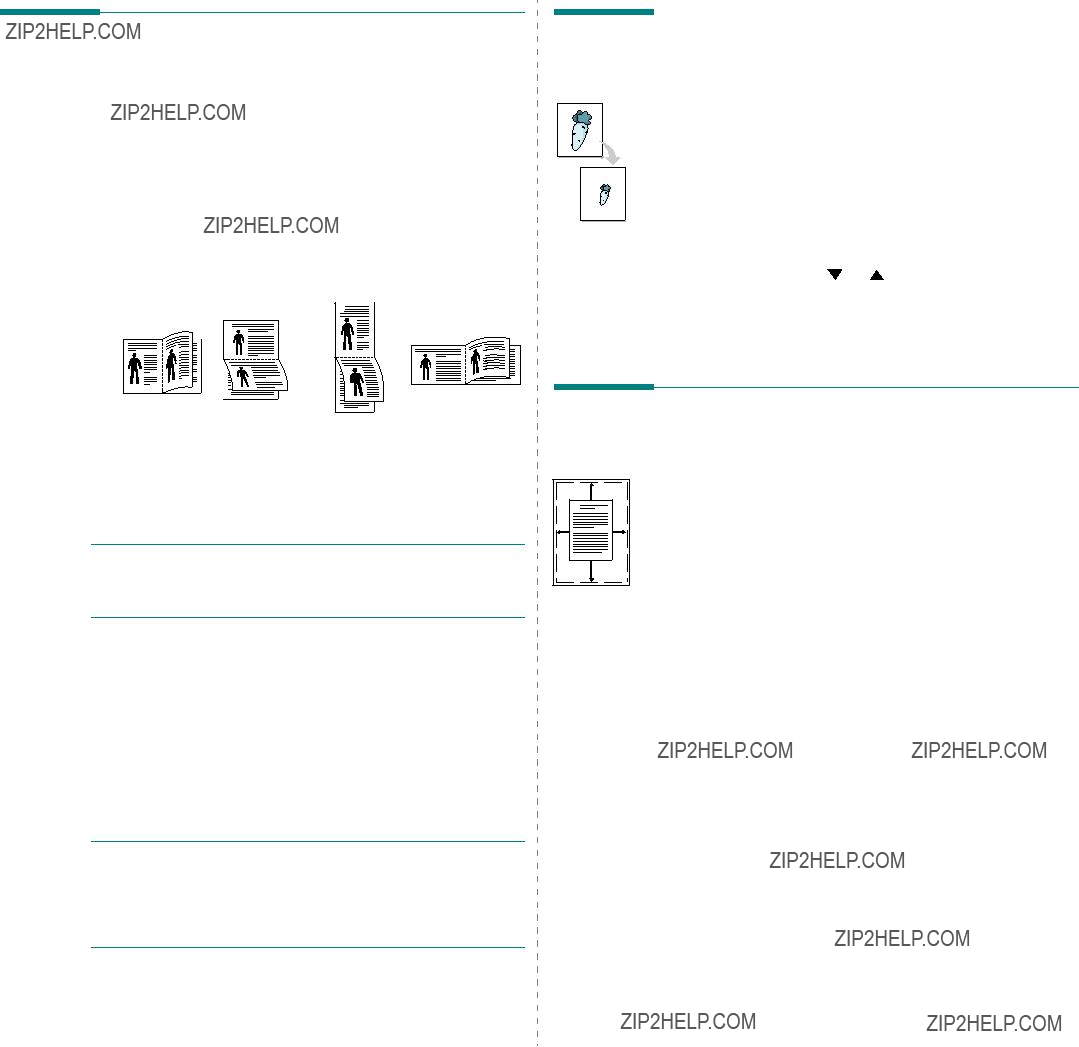
4 Click the Paper tab and select the paper source, size, and type.
5 Click OK and print the document.
NOTE: If your printer does not have a duplex unit, you should complete the printing job manually. The printer prints every other page of the document first. After printing the first side of your job, the Printing Tip window appears. Follow the on- screen instructions to complete the printing job.
21 Advanced Printing

Using Watermarks
The Watermark option allows you to print text over an existing document. For example, you may want to have large gray letters reading ???DRAFT??? or ???CONFIDENTIAL??? printed diagonally across the first page or all pages of a document.
There are several predefined watermarks that come with the printer, and they can be modified, or you can add new ones to the list.
Using an Existing Watermark
1To change the print settings from your software
application, access printer properties. See ???Printing a Document??? on page 14.
2Click the Extras tab, and select the desired watermark
from the Watermark
3Click OK and start printing.
NOTE: The preview image shows how the page will look when it is printed.
Creating a Watermark
1To change the print settings from your software
application, access printer properties. See ???Printing a Document??? on page 14.
2Click the Extras tab, and click the Edit button in the
Watermark section. The Edit Watermark window appears.
3Enter a text message in the Watermark Message box.
You can enter up to 40 characters. The message displays in the preview window.
When the First Page Only box is checked, the watermark prints on the first page only.
4Select watermark options.
You can select the font name, style, size, or grayscale level from the Font Attributes section and set the angle of the watermark from the Message Angle section.
5Click Add to add a new watermark to the list.
6When you have finished editing, click OK and start printing.
To stop printing the watermark, select (No Watermark) from the Watermark
Editing a Watermark
1To change the print settings from your software
application, access printer properties. See ???Printing a Document??? on page 14.
2Click the Extras tab and click the Edit button in the
Watermark section. The Edit Watermark window appears.
3Select the watermark you want to edit from the Current Watermarks list and change the watermark message and options.
4Click Update to save the changes.
5Click OK until you exit the Print window.
Deleting a Watermark
1To change the print settings from your software
application, access printer properties. See ???Printing a Document??? on page 14.
2From the Extras tab, click the Edit button in the
Watermark section. The Edit Watermark window appears.
3Select the watermark you want to delete from the Current Watermarks list and click Delete.
4Click OK until you exit the Print window.
22 Advanced Printing

Dear ABC
Regards
 WORLD BEST
WORLD BEST 
Using Overlays
What is an Overlay?
An overlay is text and/or images stored in the computer hard disk drive (HDD) as a special file format that can be printed on any document. Overlays are often used to take the place of preprinted forms and letterhead paper. Rather than using preprinted letterhead, you can create an overlay containing the exact same information that is currently on your letterhead. To print a letter with your company???s letterhead, you do not need to load preprinted letterhead paper in the printer. You need only tell the printer to print the letterhead overlay on your document.
Using a Page Overlay
After an overlay has been created, it is ready to be printed with your document. To print an overlay with a document:
Creating a New Page Overlay
To use a page overlay, you must create a new page overlay containing your logo or image.
1Create or open a document containing text or an image for
use in a new page overlay. Position the items exactly as you wish them to appear when printed as an overlay.
2To save the document as an overlay, access printer properties. See ???Printing a Document??? on page 14.
3Click the Extras tab, and click Edit button in the Overlay section.
4In the Edit Overlay window, click Create Overlay.
5In the Create Overlay window, type a name of up to eight characters in the File name box. Select the destination path, if necessary. (The default is C:\Formover).
6Click Save. The name appears on the Overlay List box.
7Click OK or Yes to finish creating.
The file is not printed. Instead it is stored on your computer hard disk drive.
NOTE: The overlay document size must be the same as the documents you print with the overlay. Do not create an overlay with a watermark.
NOTE: The resolution of the overlay document must be the same as that of the document you will print with the overlay.
Deleting a Page Overlay
You can delete page overlays that you no longer use.
1In the printer properties window, click the Extras tab.
2Click the Edit button in the Overlay section.
3Select the overlay you want to delete from the Overlay List box.
4Click Delete Overlay.
5When a confirming message window appears, click Yes.
6Click OK until you exit the Print window.
23 Advanced Printing
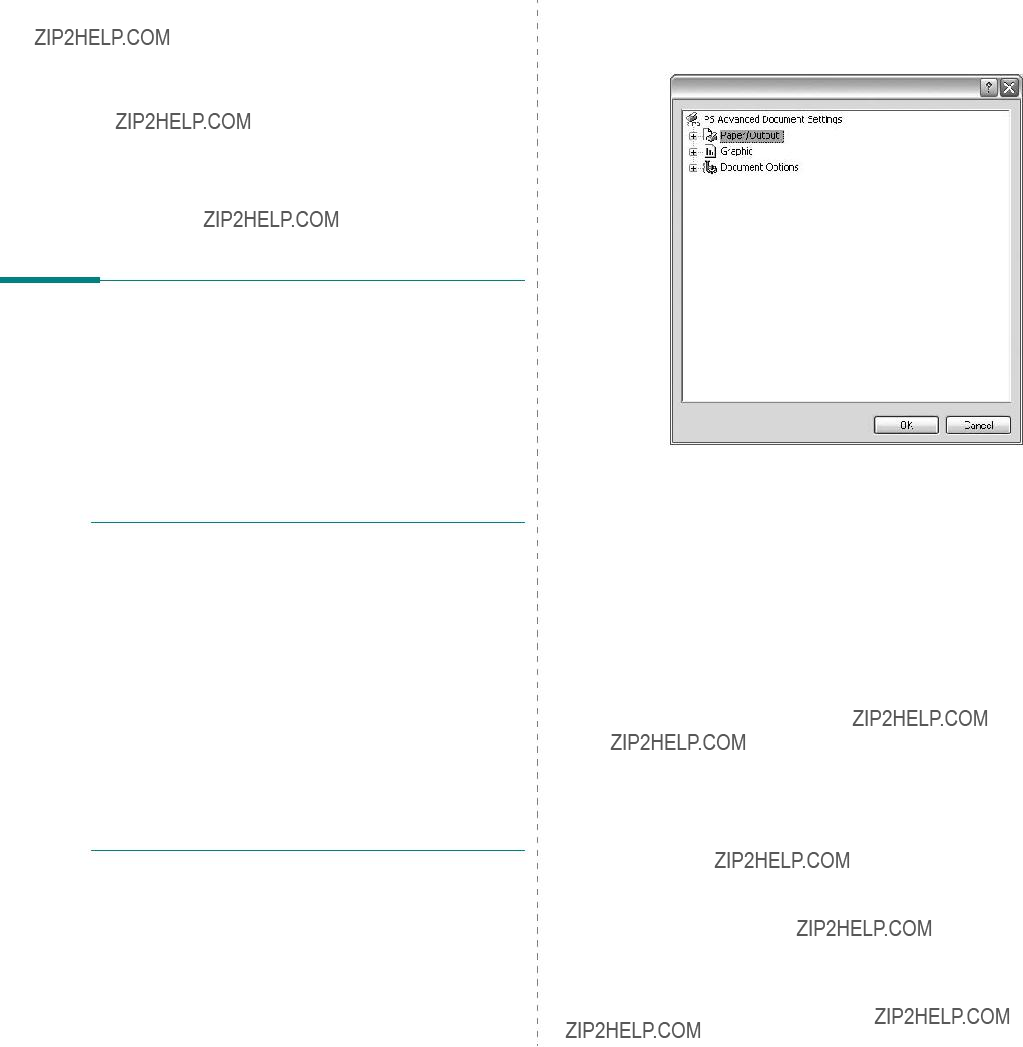
4 Using Windows
PostScript Driver
If you want to use the PostScript driver provided with your system
PPDs, in combination with the PostScript driver, access printer features and allow the computer to communicate with the printer. An installation program for the PPDs is provided on the supplied software
Printer Settings
You can use the printer properties window, which allows you to access all of the printer options you need when using your printer. When the printer properties are displayed, you can review and change the settings needed for your print job.
Your printer properties window may differ, depending on your operating system. This Software User???s Guide shows the Properties window for Windows XP.
Your printer driver Properties window that appears in this User???s Guide may differ depending on the printer in use.
NOTES:
???Most Windows applications will override settings you specify in the printer driver. Change all print settings available in the software application first, and change any remaining settings using the printer driver.
???The settings you change remain in effect only while you are using the current program. To make your changes permanent, make them in the Printers folder.
???The following procedure is for Windows XP. For other Windows OS, refer to the corresponding Windows User's Guide or online help.
1.Click the Windows Start button.
2.Select Printers and Faxes.
3.Select your printer driver icon.
4.
Printing Preferences.
5.Change the settings on each tab, click OK.
Advanced
You can use advanced settings by clicking the Advanced button.
???Paper/Output this option allows you to select the size of the paper loaded in the tray.
???Graphic this option allows you to adjust the print quality for your specific printing needs.
???Document Options this options allow you to set the PostScript options or printer features.
Using Help
You can click  from the upper right corner of the window, and then click on any setting.
from the upper right corner of the window, and then click on any setting.
24
Using Windows PostScript Driver
